Reunion
Behind the scenes P.44
Photography
Celebrities in black and white P.36
Faculty
Jennifer Brice is North bound P.8


Reunion
Behind the scenes P.44
Photography
Celebrities in black and white P.36
Faculty
Jennifer Brice is North bound P.8

WRCU alumni who now work in the biz P.28
The Class of 2024 participates in Senior Sunset, May 16. During the annual tradition, the graduating seniors gather at Raab House for a toast at sunset. look
Read this issue and all previous issues at colgate.edu/magazine.

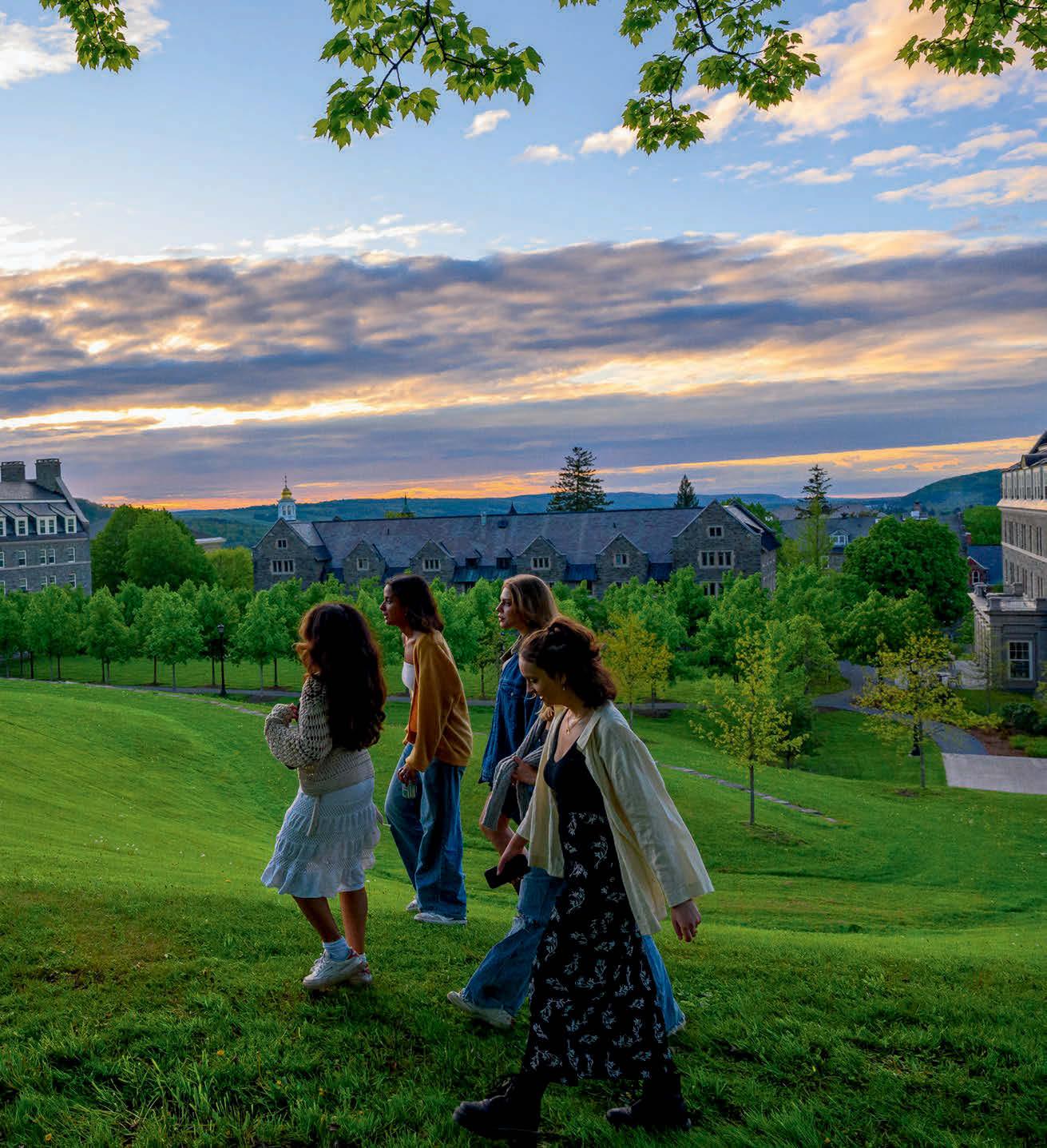
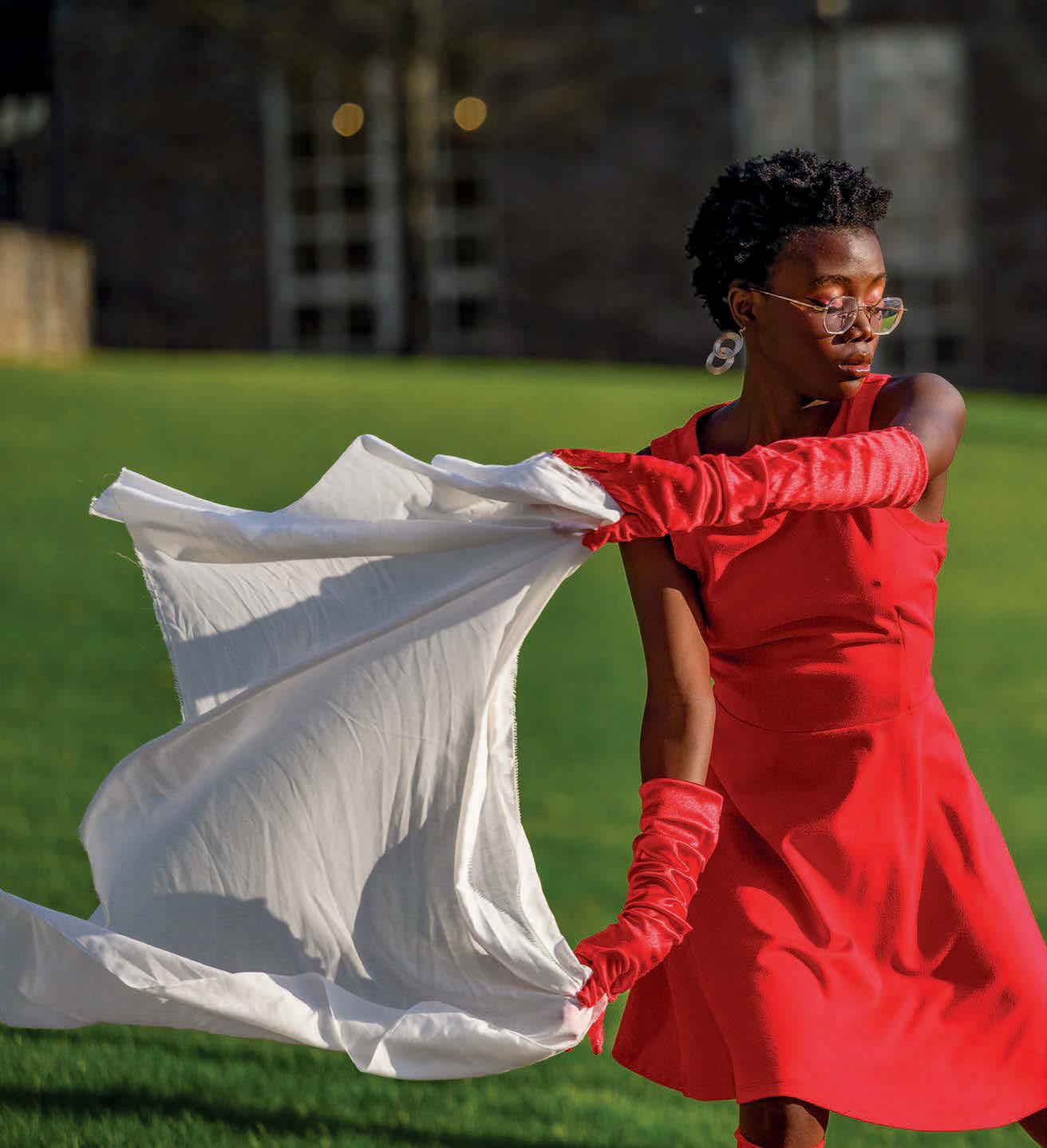
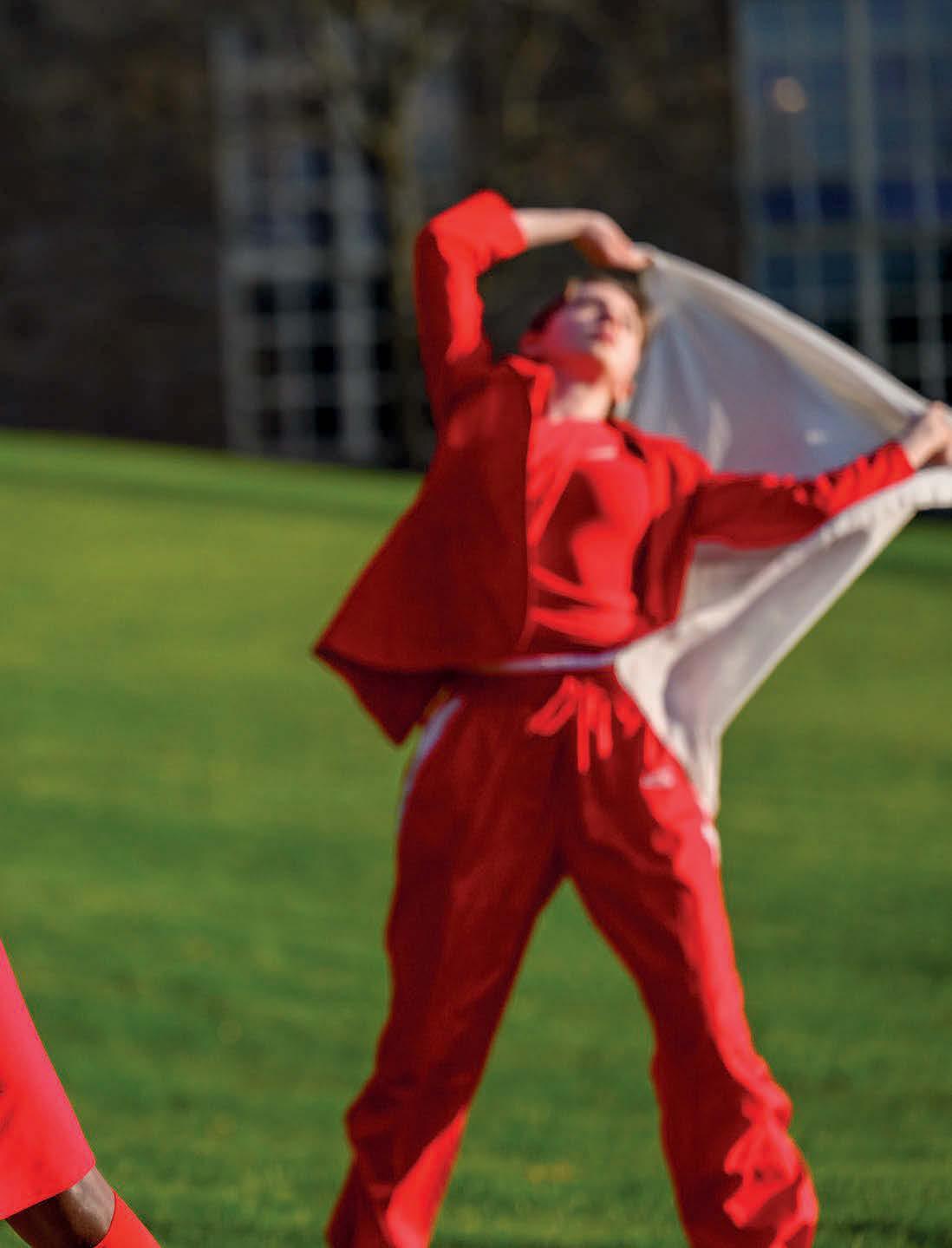
Lemon ’24 (left) and Rylee
’26 perform a dance choreographed by guest artist Esther Baker-Tarpaga. The dance production titled DIS/UNITY was the culmination of THEA 371: Contemporary Dance in Performance, taught by Professor Brian Stark. In addition to those class members (Lemon was one of them), students from around campus, like Hatch, joined in. The performance also featured live music and movement by students in Stark’s MUSI 208: Jazz Theory and Improvisation. look
Veronica Padilla Vriesman ’17 is uncovering how shells tell the story of climates past, present, and future.
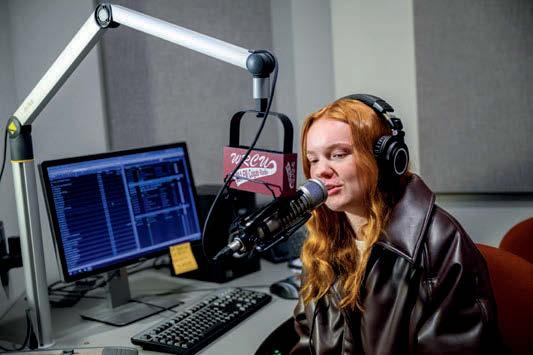
In her new memoir, Professor Jennifer Brice writes about life in Alaska and beyond.
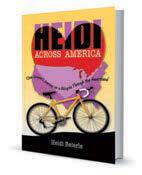
Heidi Beierle ’97 reflects on the emotional and physical journey of biking from Oregon to Washington, D.C., by herself one hot summer.
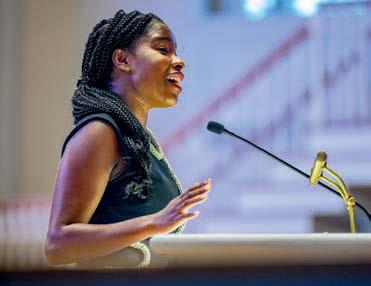
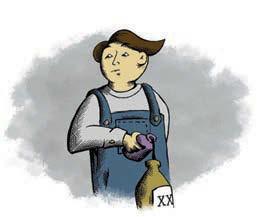
In The Great Murdering-Heir Case, Professor William Meyer takes aim at a seminal law case.
How Korean pop music has become a global phenomenon
Tate Fonda ’25 interviews her radio predecessors — alumni who set the record in motion and continue to work in related industries.

Thea Traff ’13 has photographed famous faces, including Lily Gladstone, Mick Jagger, and President Biden.
Cover: John Penner ’04, senior principal engineer at Sony Music Entertainment, photographed at Sony in New York City by Laura Barisonzi

See some special moments from this year’s event.

As chief creative officer at Walt Disney Imagineering, Bruce Vaughn ’88 has helped develop some of the parks’ most popular rides and attractions.
56
Expat Andrew Balmuth ’89 brings the best of American craft beer to consumers in Japan. 57
For one day only, Lara Donahue ’14 puts on an enigmatic off-Broadway hit.
58

Dan Slater ’00 discusses his new nonfiction book, The Incorruptibles: A True Story of Kingpins, Crime Busters, and the Birth of the American Underworld 58





Vice President for University
Communications
Daniel DeVries
Director of University Publications
Aleta Mayne
Assistant Director, University
Publications
Mary Donofrio
Associate Vice President for University
Communications
Mark Walden
Senior Art Director
Karen Luciani
University Photographer
Mark DiOrio
Communications Specialist
Kathy Jipson
Contributors: Omar Ricardo Aquije, athletics communications manager; Kelli Ariel, web manager; Stephanie DeVries, communications specialist, centers and institutes; Jordan Doroshenko, dir., athletic communications; Bernie Freytag, art dir.; Garrett Mutz, sr. designer; Brian Ness, sr. multimedia producer; Kristin Putman, sr. social media strategist; Amber Springer, web content specialist
Printed and mailed from Lane Press in South Burlington, Vt.
Colgate Magazine Volume LIII Number 4

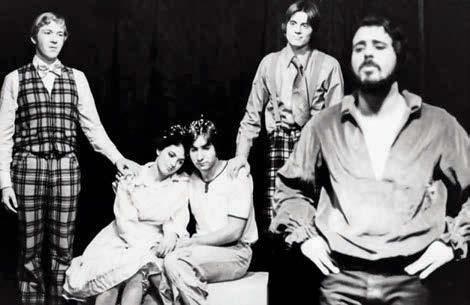
Hill Came Alive With the Sound of Musicals
Malachy Duffy ’74 remembers how he and a group of students pulled off a well-received campus production of The Fantasticks in 1974.
Colgate Magazine is a publication of Colgate University. Online: colgate.edu/magazine Email: magazine@colgate.edu Telephone: 315-228-7407
Change of Address: Alumni Records Assistant, Colgate University, 13 Oak Drive, Hamilton, NY 13346-1398 Email: alumnirecords@colgate.edu Telephone: 315-228-7453
Opinions expressed are not necessarily shared by the University, the publishers, or the editors. Colgate University does not discriminate in its programs and activities because of race, color, sex, pregnancy, religion, creed, national origin, ancestry, citizenship status, physical or mental disability, age, marital status, sexual orientation, veteran or military status, predisposing genetic characteristics, domestic violence victim status, or any other protected category under applicable local, state, or federal law. For inquiries regarding the University’s non-discrimination policies, contact Renee Madison, Title IX coordinator and vice president for equity and inclusion, 13 Oak Drive, Hamilton, NY 13346; 315-228-7014.
Of all the challenges to higher education that occurred this past year — and there were many — I think the greatest, and the one with perhaps the longest-term implications for Colgate and for other colleges and universities, has been the sharp drop in the public’s regard for American higher education.
We live in a time when regard for many of our most important institutions — the U.S. presidency, Congress, the Supreme Court, the national press — is falling, sometimes dramatically so. It might not be surprising to see the same trends are affecting our colleges and universities. Are we simply victims of the larger trends of a more suspicious and cynical time?
Of course, so much of the news about higher education has not been good. Admissions scandals, athletics programs seemingly fully in the thrall of huge financial arrangements, unclear responses to the pandemic — all contributed to the sense that our nation’s colleges and universities are not well run, or have drifted from some set of important governing principles. In the past year, questions about what can be said on a campus and what beliefs are promulgated rocked institutions and put our nation’s colleges and universities on the front pages of newspapers for weeks.
What is telling is that there appears to be no person who is explaining to the nation the value of what happens on a campus and why we need our colleges and universities. There appears to be no leader of American higher education whose thoughts are wellcirculated and whose opinions are sought and almost universally accepted.
In the past, Derek Bok (Harvard’s president from 1971–91), Bill Bowen (Princeton 1972–88), Father Ted Hesburgh (Notre Dame 1952–87), and Kingman Brewster (Yale 1963–77) could command the opinion pages of Time or the New York Times. They were symbols of the place higher education held in the nation’s collective regard. More recently, Ruth Simmons (Brown 2001–12) and Bob Zimmer (University of Chicago 2006–21) were thought to be spokespeople for “American Higher Education” — Simmons speaking forcefully about access to elite institutions and Zimmer about the centrality of free and unfettered debate and discourse on the campus.
Today no one seems to have assumed the role of speaking nationally about the nature and purpose of the American college and university. This past academic year, in fact, was seen by many as the moment when college presidents were seemingly revealed to be fully without leadership capacities. The job itself was no longer thought desirable. (I was recently on an airplane and my seat row companion — an elderly, elegant woman — asked me what I did for a living. I told her I was a college president. She put her hand on my forearm and said, “Oh, dear.”)
Perhaps the challenge is that there is no system of

We gather on campus in pursuit of truth, obtained through study and research, through questioning and debate.
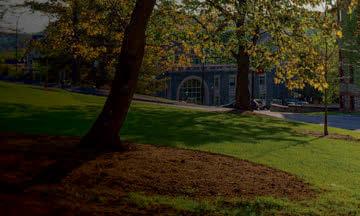
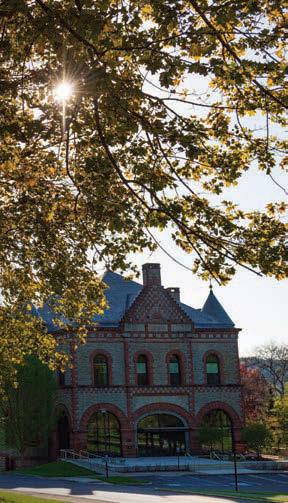


American higher education. Unlike the situation in most European and Asian nations, there is no central body that regulates and thus speaks for all 4,000 American colleges and universities. We all act separately — competing for students, faculty, and staff as well as for acclaim and regard.
But we are joined by a set of beliefs — or should be. That we gather on campus in pursuit of truth, obtained through study and research, through questioning and debate. That our work on a campus demands rigor. That education remains the most powerful tool designed to free a person from the limitations of their particular circumstances. That a rigorous form of education is a necessary ingredient for a functioning democracy. That a degree can be completed in a set amount of time, but an education starts at a college and continues through a life marked by curiosity and engagement. That a campus is a place where one is called upon to think, and thus is a place where, person by person, the nation forms its sense of itself.
So, next time I am on an airplane, and someone wonders what I do, I can, and should, honestly say that I am fortunate enough to be charged with a nearly sacred duty to serve a college that, through the assemblage of a faculty and a student body, engages in the hard work of learning and truth seeking, and that because of this work, it serves a nation.
— Brian W. Casey

Here’s to the Health Issue WOW! Best magazine yet, in my opinion (spring 2024). Thanks so much for including the first-person accounts of the six medical professionals and the article about wholeperson healing. I especially loved hearing about friends of mine/fellow classmates plus a couple of friends from the early ’90s. As always, Colgate grads continue to be mind-blowingly impressive.
Kerstan Lincoln ’93 Ruffer
Testimony Is Not Evidence
I have always read Colgate’s alumni publications, and was positively impressed by its latest iteration, Colgate Magazine, at the last “redo.” Aside from the look, I actually read the content (not just class notes!), making me one of the 68%. The latest issue on health was, I initially thought, topical for one approaching a 50th Reunion. As a true believer in the liberal arts and the importance of learning to think as a foundational skill, I was, however, quite amazed to see a section on so-called alternative medicine, albeit partially veiled in the title “Whole-Person Healing.” Wow, or should I say, woo?
Reiki, chiropractic, acupuncture, and (so help me, Darwin) homeopathy are all
fake treatments that have been scientifically discredited for ages. Chi is woo, acupuncture is woo (OK, occasionally a study says acupuncture helps with pain, but it’s impossible to devise a good double-blind study, and pain is notoriously subjective to measure), homeopathy is woo², and chiropractic is scientific in the same way as is scientology, with tests, tools, and toys, just no demonstrable proof.
There is only one kind of medicine that works; it’s called medicine. Those efforts that don’t work are “alternative medicine,” aka not medicine As the saying goes, “testimony is not evidence.”
I am glad to see that my legacy donation to the P&R department to endow a chair in “Skeptical, Atheist, and NonTheistic World Views” will be going where it is so clearly needed.
R.B. Wright ’74

The Ripple Effect In response to (“Making Waves,” spring 2024, p. 50): Nick (Kern ’94) was never a follower. I love to see him keep breaking new ground. No surprises here. Well done, Nick!
Jesse Coburn ’94

The winter 2024 edition of the Colgate Magazine highlighted a recent exhibition of the art of Lee Brown Coye at the Picker Art Gallery (“The Ghastly and Grand World of Lee Brown Coye,” p. 10). For those interested in seeing more of the artist’s work, a large, multipanel mural is always on display in the village of Hamilton. The paintings depict the founding of Hamilton with emphasis on the Civil War years — its role in the abolition movement and its location as a station on the Underground Railroad. The mural was commissioned by Doane’s Steak House, which later became Hickey’s Tavern. When the tavern was closed and sold, the mural was restored and loaned to the village. It has been on display at the Hamilton Post Office since 1996. Will Keller ’84

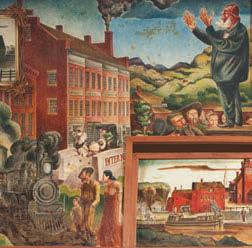

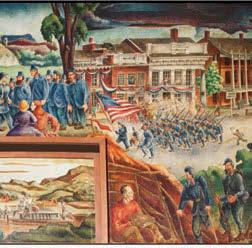
Editor’s note:
A reminder that Colgate Magazine now publishes three times a year. The next issue will be autumn/winter, mailing in January.
To submit a letter to the editor, email us at magazine@colgate.edu. Letters may be edited for editorial style, length, clarity, and civility and must be relevant to Colgate Magazine’s editorial coverage. Generally, only one letter to the editor is published in Colgate Magazine by the same author in a calendar year. Letters to the editor represent the individual views of the authors. They do not reflect the views of Colgate University, Colgate Magazine, or its staff.
Memoir
In her new book, Professor Jennifer Brice writes about her life in Alaska and beyond.
Professor Jennifer Brice writes that she is “ridiculously vain” about the fact that she has a “working knowledge of aeronautical charts.” Born and raised in Fairbanks, Alaska, she knows how to both fly a plane and drive a dump truck. In Another North, a collection of essays she wrote over 25 years, the English professor reveals parts of herself and ruminates on “the questions that have engaged me,” she said during a spring Brown Bag at Colgate’s Women’s Studies Center. “The questions are rooted in dialectical materialism and the tension between what are generally regarded as higher order concerns — the intellect, ideas, books, solitude,” she said, “and lower order ones — the senses, safety, bodily comfort, romance.”
The following excerpt is from an essay titled “Theory of Life,” in which Brice draws on literary criticism to interpret the stories of her life. In a section of the essay, called “Narrative,” she recaps what she calls her “origin story,” telling the tale of how her parents met and fell in love. “It’s a reminder of how contingent all of our lives are on a particular set of circumstances, how dependent we are on stories,” Brice says of the history her parents recited throughout her life. “Sometimes we feel something powerful,” she says, “and in order to understand, we have to put a story to those feelings.”
Brice says the book is “inflected with the wisdom and insight” of her English department colleagues: CJ Hauser, Peter Balakian, and Jane Pinchin.

“Not only do we tell stories, but stories tell us.”
For the last time, my mother’s foundation myth: Born at Babies Hospital in New York to a Brown- and Harvard-educated surgeon and his socialite wife. Educated at Emma Willard, Colby College, and Columbia-Presbyterian School of Nursing. On a lark, accepted a public health nurse position in Alaska. Met a guy who wasn’t right for her but who happened to have an older brother he worshiped. For him, it was love at first sight. They went on several dates: curling with friends, dinner at Club 11, where they danced
to “Moon River.” He proposed; she demurred. He pressed his case with a Tiffany’s diamond and dozens of yellow roses.
The day after she said yes, Alba flew out East. Biding his time while Carol and her mother planned a speeded-up wedding — Lent was coming — he finished the flying lessons he’d begun in Fairbanks, doing his first solo and earning his private pilot’s license. On Feb. 17, 1962, Carol Ann met him at the altar of All Saints Episcopal Church in North Adams, Mass. She wore a raw silk ballgown with an Alençon lace veil. Dressed in red velvet cocktail dresses, her
Time and again, I urge my students to dig deep in the substrata of their lives, then to dig again, deeper still. Bring up whatever shards you can find, I tell them.
bridesmaids carried rabbit fur muffs rather than flowers.
On receiving, via telegram, the news of my birth, just over a year later, my surgeon grandfather pronounced me “J.P., the lumber baroness.” It was a joke. At the time, my father was still working as a mechanic for Pan Am.
Decades passed. To build their company, my father and his brothers worked brutal hours in conditions so cold and dangerous, they hardly bear thinking about. There were a lot of lean years and a few profitable ones, enough to outfit us in the trappings of the middle class: Hawaiian vacations, orthodontics, college tuition, a series of Volvo station wagons.
In 2012 the company that my father founded with his father and three brothers was purchased by one of Alaska’s large Native corporations. This scenario is the Alaska equivalent of winning the lottery. The Native corporation installed my brother as president and CEO of the Brice Companies. One of his first acts was to hire my father and one of my uncles — the one who’d set my parents up on their first date — as consultants. At first, this was painful for my father and his brother. Then, when the extent of their windfall sunk in, they used some of the money to buy back some of the fun they’d missed by working so hard for all those years. They bought matching airplanes, took up gold mining, built vacation cabins in remote places, then the riverboats that were required to reach those cabins.
My parents began spending long stretches of every winter in Key West or Hawaii. In the summer, between stays at one or the other of their cabins, they putter around the Fairbanks house. Dad builds treehouses for his grandchildren and patches the lawn.
Mom grows dinner-plate-sized dahlias in the garden and throws teddy bear tea parties for the grandchildren. She is growing vague and forgetful, soft around the edges. She still bakes pies, though, with rhubarb from her garden. Before working the crust, she takes off her engagement ring and sets it on the windowsill. Sometimes in the winter, Dad puts on his Carhartt overalls to chop wood or plow the driveway.
A while back, when it became clear Mom could no longer keep track of things like reading glasses and keys, he had new locks installed, ones with a passcode they can both remember: 0-2-17. On that day, every year, Dad still brings Mom a bouquet of yellow roses.
In my professional life, I spend a lot of time thinking about the stories we tell and the ones we don’t. Why do our set pieces come off in some contexts, fall flat in others? Is it an accident of timing? A trick of the light? And why do the stories that sustained us as children often lose their shine, failing to grow along with us? Every semester, I put Joan Didion’s “White Album” in front of my students, pointing out the opening line: “We tell ourselves stories in order to live.” I share with them Patricia Hampl’s mantra, from “Memory and Imagination”: “Refuse to write your life, and you have no life.” If there’s time, I refer them to the work of Paul Armstrong, a neuroscientist who studies the human need for narrative, which satisfies the brain’s need for pattern and consistency as well as its hunger for flexibility and openness.
Time and again, I urge my students to dig deep in the substrata of their lives, then to dig again, deeper still. Bring up whatever shards you can find, I tell them. Together, we’ll turn those pieces into a story.
Somewhere along the way, I stopped believing my own advice. I’m not as cynical as one or two writers I can think of — one of whom recently declared, in an interview, the end of character; the other of whom asserts loudly and often, to anyone who will listen, that narrative is dead. They both make compelling intellectual arguments; sap that I am, I sometimes find myself nodding in agreement while reading or hearing them. But they’re wrong, of course. The human craving for characters and stories has changed over time, with technology (the New Yorker profile giving way to the Instagram feed), but it hasn’t disappeared altogether, and surely it won’t — ever.
The danger I’m thinking of is an entirely different one. I’ve watched my mother use her stories sometimes as a cudgel (against my father’s family and their working-class roots; against her own children, whose
→ First job was writing obituaries for the Fairbanks Daily News-Miner
→ Has three daughters, two of whom are identical twins
→ Has a ghost in her house
→ Earned her BA from Smith College and her MFA from the University of Alaska Fairbanks
→ Calls Virginia Woolf “the generative angel” of her new book, which is her third
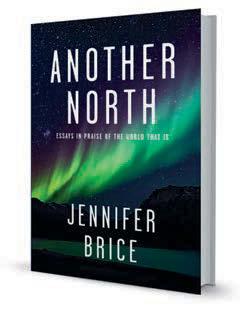
lives will never rise to the same level of interestingness as hers) and as cultural capital (against everyone else who washed up, for one reason or another, in one of the farthest north outposts of the continent).
Our stories ought to form a supple scaffolding, I think — a shape that can bend in the face of heavy winds. They shouldn’t ossify over time but rather soften and recede. As we age, we should become more restrained in the telling and retelling of our own stories, more receptive to the stories of others. In Darwin’s Worms, his monograph on Darwin and Freud, Adam Phillips reminds us Freud adamantly refused to write the story of his own life, nor would he allow anyone else to do it for him. His resistance to autobiography, Phillips writes, was not due to evasiveness or a desire for control (though surely that was part of it). Rather, he believed (in Phillips’ telling) that a person’s “life story was, in part, the ways in which a person avoided having a life story.” In short, life is the thing that unfurls in resistance to — even opposition to — the stories we or others wish to tell about it.
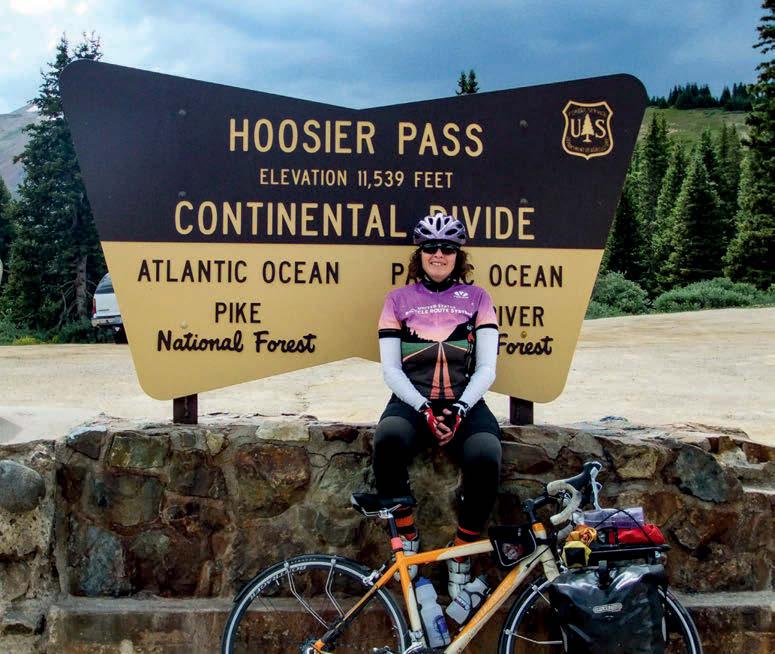
pproximately 1,000 people ride the TransAtlantic Bike Trail — stretching from Oregon to Virginia — every year, estimates the Adventure Cycling Association. In summer 2010, Heidi Beierle ’97 became one of those people, traveling solo. June 23, she hopped on her bike and gave herself three months to make it to the Preserving the Historic Road Conference in Washington, D.C. There she was to present on bicycle tourism and historic roads, having just finished her first year of grad school in community and regional planning.
ABeierle had some research questions she wanted to explore on the trip: What efforts do communities make to invite cyclists to stay in their towns? What do cyclists do to support these communities?
She also wanted to answer some questions about herself because she’d found
herself in “a dark place,” feeling lonely and depressed. On her bike, Beierle knew, she felt happiness.
While learning more about herself, Beierle also got to know people across America. “Growing up in Wyoming, it’s such a harsh place to live — people, plants, everybody’s on their own,” she says. “So encountering friendly, welcoming people was really a surprise to me. People were falling over themselves to make sure I was OK, even when I didn’t need help or anything.” In return, Beierle was curious about the strangers she met, what they loved about where they live, and their tips for her as she traveled through.
Toward the end of the trip, when the heat and exhaustion had broken her one too many times, Beierle had “a profound moment,” she recalls. She remembers thinking, “I love me. And I’m not alone; I
have never been alone. There have been these people all around me, welcoming me. There are all my people in a virtual space who are there with me. There’s this whole world around me with all these other creatures in it.” She adds, “This idea that I’m part of a greater community and energy and spirit of place was mind-blowing.”
Beierle blogged along the way and used that material as part of her research for her master’s thesis. In fall 2013, she began writing about the personal part of the experience and turned it into a book that was released in April. The following is an excerpt from Heidi Across America: One Woman’s Journey on a Bicycle Through the Heartland.
I pedaled out of Baker City [Ore.] on a hot Tuesday morning across a sagebrushknotted rumple of land on my way to Halfway [Ore.]. My sitting parts were still sore, but a day off the saddle had reduced the tenderness. Heat reflected from the pavement, and the parts of my head exposed by my helmet’s vents baked.
Few vehicles passed on Highway 86. No bicyclists. The road through this sere emptiness was mine. The landscape was quiet and expansive.
I pedaled and sweated, scanning the hillsides for visual relief from the sun’s glare. None. I hoped for shade farther ahead. None.
The road east of Richland climbed at a 7% grade. It was midday. My head sizzled as I inched up the treeless hillside. My quads burned.
After what seemed like 2 or 3 miles of climbing, the road bent to the left for another mile. The grade steepened as I crawled to the road crest.
Short evergreens marked the ridge. I strained past a gravel pullout, wanting to stop but determined to keep going. I could rest on the way down.
Over the crest, the landscape changed to deep greens, tall grass, coniferous trees, and yellow, lavender, and white wildflowers.
Following the squiggling road down, my head cooled in the rush of air. A broad smile etched my face.
While learning about herself, Beierle also got to know people across America.
The colorful structures of Halfway stood amid hayfields and woods.
I stopped at the library for Wi-Fi and sat at a picnic table in the courtyard because the building was closed.
“Oh, hi, didn’t mean to disturb you,” a woman’s voice said.
I turned to find a gray-haired woman in shorts and a T-shirt pulling on a garden hose. “You’re not disturbing me. Is it OK that I’m here?” I said.
“Yes. It’s a great spot.”
“I agree. The garden is really pretty.”
“Oh, thank you. I volunteer twice a week to take care of it. If you want some water, help yourself.” She indicated the spigot on the wall. “It’s nice and cold.”
I thanked her and turned to my computer. After 20 minutes, the woman returned to the table. “Do you know where you’re staying tonight?”
“I haven’t sorted it out yet. I wanted to get my blog post written while I have a connection.”
“You’re welcome to stay with me and my husband. We often host cyclists. It’s nice to have company. We’re about 3 miles from here.”
I accepted. I wanted to talk to people who could tell me about life in towns like Halfway and what kind of economic impact touring cyclists, such as myself, were perceived to bring, especially since homestays didn’t immediately bring economic benefit to rural communities. Did touring cyclists get something out of it beyond a free place to stay? How were the people offering homestays served? What was the longer-term economic benefit of hosting cyclists? In Baker City, I’d interviewed a couple who moved to town because they were artists and cyclists and liked what living in a place with a lower cost of living enabled. The risk of being entrepreneurial was also low. They missed their city cycling community but organized bicycle races, which brought people and money to town. Everyone benefited.
Linda offered dinner around 6 p.m. in addition to lodging. Were people really that nice?
Around 4:30 p.m., I stopped at the gravel drive leading to Linda and Tom’s house. A lake of grass swooshed and rose in the breeze. Dark blue mountains crowned the view.
We began with cocktail hour in chairs on the back patio, watching the weather move across the ridges and valleys. As the thunderstorm and rain curtain consumed the higher ridges to the east, Linda used a large, pagoda-style house on the ridge as a reference point for the storm’s movement. In that house lived the first Sports Illustrated

LIST
Trek 2.1 with a custom cargo rack that fit onto the front handlebars and axles. Beierle hung two panniers from bars welded onto the sides of the rack.
Tarp, ground cloth, sleeping pad, and sleeping bag. A water bottle and some food: “Basically, snacks that would do in a pinch if I ended up somewhere where there was no food … oatmeal packets that I would eat dry.”
One riding outfit (that she wore). Change of socks, one long-sleeve shirt, one short-sleeve shirt, one pair of yoga pants, a dress that could also serve as pajamas, one pair of non-biking shoes (lightweight Mary Janes).
A 2008 MacBook with charging cable that “felt like a brick”
A roll of black masking tape, a self-healing cutting mat, an X-Acto knife, a pair of scissors, a glue stick, and some magazines. “Very handy stuff in my world. I could make envelopes, I could repair things, I could make art.”
A 1955 Thunderbird toy car
swimsuit cover model from 1964. “She’s an artist,” Linda said. The artist in me stirred.
The storm came rushing over us, and we scrambled inside for a bounteous salad made from vegetables grown in their garden.
Linda and Tom told me stories about different biking tours they’d been on, retirement, irrigation, the difficulty of keeping young people in Halfway, and the challenges of finding a doctor who would live in such an isolated place. I didn’t know that someone like me could address what they saw as needs in their community. Cycle Oregon, the organization that produced weeklong event rides in rural parts of the state every year, had a giving program to support communities that the rides visited. There was also the new Oregon Scenic Bikeway program and the established state and national Scenic Byway program. Even if Halfway had annual events around scenic tours, I doubted young people would stay unless they loved farming, ranching, or had the vision and savvy to make conservation or outdoor adventure experiences into their livelihood.
Linda excused herself to turn on the heat lamp for her adolescent chicks while Tom told me about the forest. Linda returned, wide-eyed: “You should see the light out there.”
The three of us returned to the back patio. In the evening’s low light, the clouds had an unearthly glow to them, ominous and playful.
At Colgate, Beierle was an English major. She now lives in Bellingham, Wash., where she owns a small business that offers consulting for recreation, tourism, and transportation, as well as communication services. She also is an operations manager and creative director at a financial advisory practice, an author, an artist, and a slow traveler. This excerpt is reprinted with permission from Health Communications, Inc.
The Adventure Cycling Association established the TransAmerica Trail in 1976 as part of celebrating the U.S. Bicentennial.
On commencement weekend, Colgate celebrated the graduating Class of 2024, which entered the University during what President Brian W. Casey called “the most inauspicious of times” — August 2020, in the midst of the COVID-19 pandemic.
“The first thing I learned about you, this class, was that you were brave,” Casey
said during the baccalaureate service. “You made a hard thing good, together.”
The class and their guests also heard inspiring words from financier-turned–human rights activist and author Bill Browder, an individual who epitomizes the notion of bravery — as he put it himself, “the person that Vladimir Putin, the president of Russia, hates more than anybody in the Western world.” In his commencement address, Browder told the story of how he catalyzed the Global Magnitsky Act — international legislation that targets human rights abusers and corrupt individuals. The act honors the legacy of his lawyer Sergei Magnitsky,
who died in a Russian prison in 2009 after uncovering massive fraud committed by Russian government officials and being arrested, imprisoned without trial, and systematically tortured.
Such efforts may seem far from the endeavors in which most college graduates would envision themselves becoming involved; yet, Browder posited, “many elements of my story will be elements of your story.” He went on to share advice, such as “You will never be able to predict what will happen in your life…. You are going to have to roll with the punches and adapt.” Browder also said, “Perseverance and unwavering commitment can
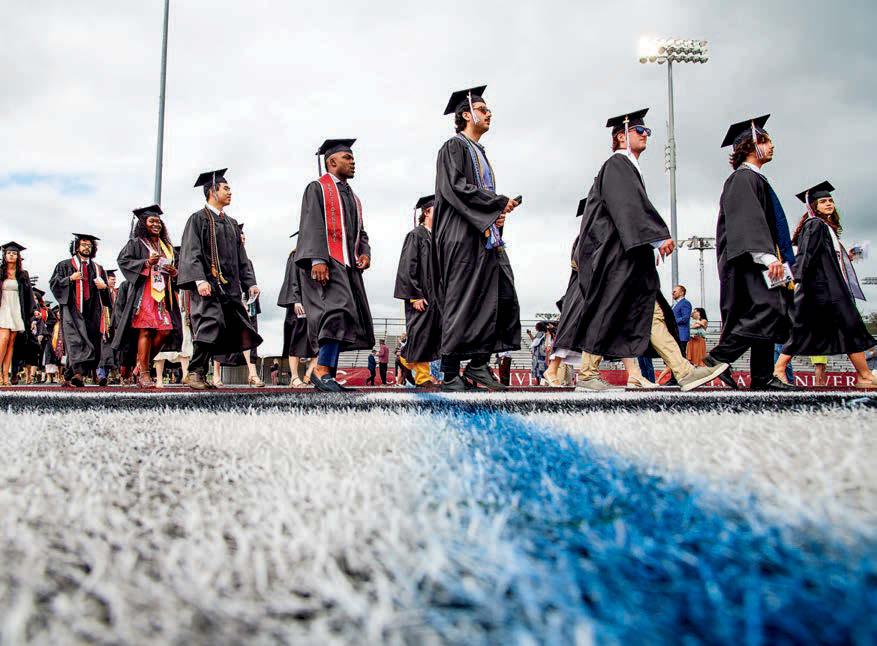
move mountains. There will be setbacks along the way. But keep pushing forward. Never give up. Never give in.” And, lastly, he said, “the cause, the idea that sets your soul on fire — commit yourself to it; focus on it with laser intensity. The next chapter in history is going to be written by you.”
— Rebecca Downing
→ Valedictorian: Michael Hanratty of Barkhamsted, Conn., summa cum laude, Phi Beta Kappa, economics and political science major, high honors in political science
→ Salutatorian: Nikoloz Bujiashvili of Tbilisi, Georgia, summa cum laude, Phi Beta Kappa, physics and computer science major, honors in computer science
→ 730 undergraduates recognized for earning the AB degree
→ 6 awarded a master of arts in teaching, with distinction
→ 1 awarded a master of arts, with distinction
→ 33 elected to Phi Beta Kappa
→ 133 summa cum laude
→ 260 magna cum laude
→ 138 cum laude
Commencement speaker Bill Browder received a doctor of letters and was one of five honorary degree recipients at Colgate’s 203rd Commencement. The other recipients included: Angela Ferguson, doctor of humane letters: As a member of the Eel Clan of the Onondaga, Ferguson is supervisor of the Onondaga Nation Farm and a founder of Braiding the Sacred. That organization coordinates gatherings among Indigenous communities to create opportunities for relationship building and knowledge sharing among traditional Indigenous corn growers. She has been featured in the PBS series Native
America and in the New York Times. Author Mohsin Hamid, doctor of letters: Hamid has written five novels, including the international bestsellers Exit West and The Reluctant Fundamentalist (both of which were shortlisted for the Booker Prize) as well as Moth Smoke, How to Get Filthy Rich in Rising Asia, and his most recent, The Last White Man He speaks and writes on topics ranging from literature, culture, and the arts to migration, technology, business, and politics.
Michael J. Herling ’79, P’08,’09,’12, doctor of humane letters: The former chair of Colgate’s Board of Trustees, Herling is founding partner at Finn Dixon & Herling LLP, a law firm in Stamford, Conn. Herling chaired the search committee that hired Brian W. Casey as Colgate’s 17th president. Herling also served on the Task Force on Academic Freedom and
Bill Browder
Freedom of Expression and for 10 years on the Alumni Council and chaired the Presidents’ Circle Membership Committee.
Tod Machover, doctor of letters: Called “America’s most wired composer” by the Los Angeles Times and “a musical visionary” by the New York Times, Machover is a composer/ inventor who is the Muriel R. Cooper Professor of music and media at the MIT Media Lab. He is also visiting professor of composition at London’s Royal Academy of Music. His compositions — commissioned and performed by elite ensembles, opera houses, and esteemed soloists worldwide have received numerous awards, including a Chevalier of Arts et Lettres accolade from the French Culture Ministry.
Laura Klugherz, professor of music and Africana & Latin American studies, achieved emeritus standing.

Quotable
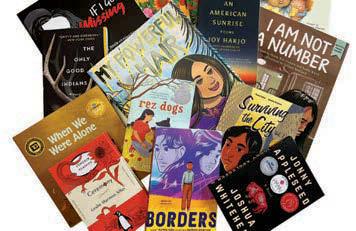
Last spring, students donated Indigenous-authored books to local Little Free Libraries as part of an Indigenous Education course taught by Visiting Professor of Native American Studies Tarisa Little.
To decide which books to donate, Little’s students engaged in a semester-long research project, beginning their studies with introductory lectures on Indigenous ways of knowledge and early colonial schools.
Through the class, Little’s students learned about the importance of multicultural inclusion in the classroom. The students’ efforts represent what Little calls “little activisms” — small acts with significant impact.
“Talking about Indigenous people in the classroom and putting them in a contemporary context is beneficial for them not just to be heard about,” the professor says, “but also seen as current members of society.”
Tate Fonda ’25
“Every fashion reflects its time and the larger elements of its culture. Ultimately, the only way to remain comfortably trapped in your person, in your time, in your skin, and in your clothes is to just enjoy the tango and see it less as a matter of choice and more as something that simply is.”
Avery Trufelman, host of the fashion podcast Articles of Interest, gave a campus talk, titled “Everyday Performance: How History, Politics, and Culture Shape What We Wear and How We Wear It.”
Illustrations by Bernie Freytag

1
Joe Castiglione ’68 received the 2024 Ford C. Frick Award at the National Baseball Hall of Fame in July.

2
Colgate hosted a live recording of the PBS political TV program Ivory Tower
3
Professor Chad Sparber’s work has been cited in Biden’s 2024 Economic Report of the President
4
Judge Meredith Vacca ’02 was nominated by President Biden for the U.S. District Court for the Western District of N.Y.
5
Students for Environmental Action held a bake sale to raise money for oncillas, a tiger cat threatened by habitat loss and human activity.

6
7
Neuroscience major Gwen Eichfeld ’25 received the Goldwater Scholarship and was chosen as a Harvard-Amgen Scholar.
8
The Tzotzil Maya rock band Sak Tzevul showcased their musical talents and discussed Indigenous identity.

9 Jessica Johnson ’22 was selected for the NIH Oxford-Cambridge Scholars Program.
10
The Division of Natural Sciences and Mathematics launched the Science and Technology Accelerated Research Scholars program
11
SGA President Jonathan Eaton ’24 won the 1819 Award.
12
Alex Coco ’12 was a producer for the film Anora, which won the Palme d'Or at Cannes.
13
Golden Globe–winning and Academy Award–nominated producer Jeff Sharp ’89 made a documentary titled Colgate Together about the University’s pandemic response.

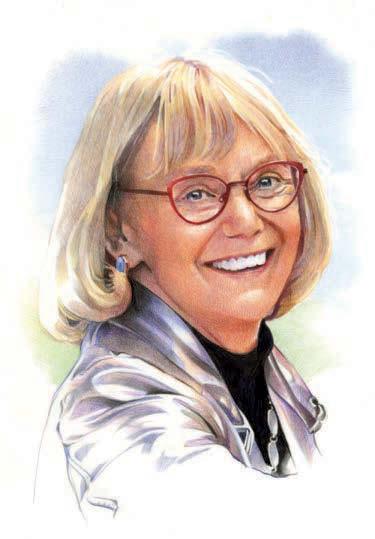
When former Colgate University President Rebecca S. Chopp was diagnosed with Alzheimer’s disease five years ago, the first neurologist she saw gave a grim prognosis: She wouldn’t even be able to button her shirt in a few years. But, as the liberal arts has taught her, if you don’t like the answer you get, “ask the question again; ask it deeper,” she told an audience gathered in Colgate Memorial Chapel in April. When she asked a second neurologist for an opinion, that doctor said, “There’s so much more living you can do.”
Embracing this credo of living life to the fullest, Chopp has written the book Still Me:
Accepting Alzheimer’s Without Losing Yourself and has become an Alzheimer’s activist and educator. She has delivered a TED Talk on the subject and in the spring came to Colgate to participate in a panel discussion with Ellen Percy Kraly, professor of geography and environmental studies emerita, and Doug Johnson, the William R. Kenan Jr. Professor of psychological and brain sciences.
“It was at Colgate where I began to realize how the arts, science, and athletics come together in the phrase we always use, ‘the spirit that is Colgate’ — and it’s about being a full person, a whole person, and how all of this can combine into making a
It’s about being a full person, a whole person, and how all of this can combine into making a life worth living.
life worth living,” Chopp said. After serving as Colgate’s 15th president, she became president of Swarthmore College and then chancellor of the University of Denver. Chopp was in the prime of her life when she was diagnosed, she said at the Colgate event. After working through her despair, she decided to “live with joy,” as that second neurologist told her she could do, and start researching how to live well. She turned that “prescription” into gifts she shares with others:
“Build your body to prolong your brain. I wrote this book, and here’s how I did it. I have a little Pomsky (a mix between a Pomeranian and a Husky), and he’s very active. So we walked extremely fast for about an hour to an hour and a half every morning. That got all those chemicals in my brain to allow me to concentrate, to go home and write that book. Exercise is extremely important. If you don’t do it, start. And if you do [exercise], increase it.”
“Creativity, with the 100,000 billion neurons in the brain, allows a kind of flexibility. It forms new pathways, and it also reduces anxiety. So create, doodle, dance; music is fabulous. Any kind of artistic activity. I learned to paint.”
“Sleep is really important. When I [worked at Colgate] and throughout my life, I slept about four hours a night…. [Now] I sleep about nine to 10 hours a day, which is amazing.”
“Every morsel you eat is brain boosting or brain destroying. Adopt a Mediterranean diet. I gave up all processed foods.”
“Abide in awe. Call it spirituality. Call it religion. Whatever you need… Awe is that feeling of being connected to transcendence.”
The panel discussion with Chopp kicked off the University’s Arts, Creativity, and Innovation Weekend. For more on that weekend, see p. 22.
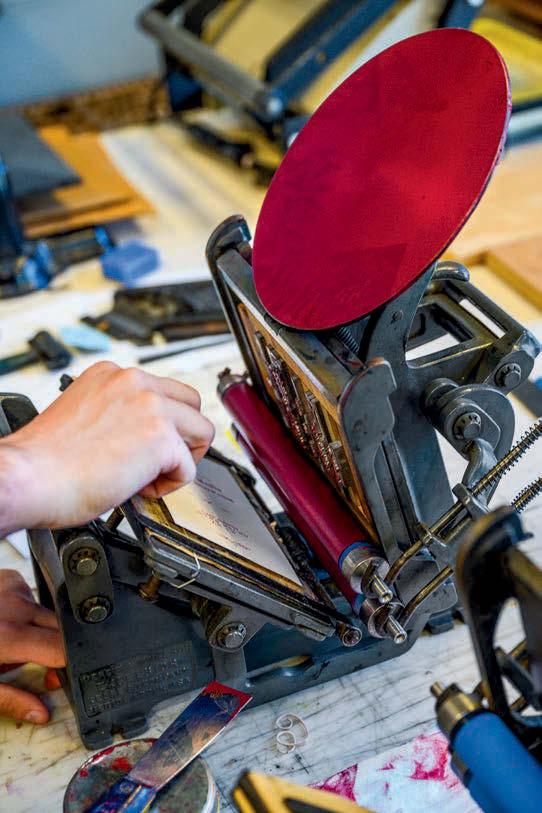
In Little Hall: making an old printing process new again
Three small printing presses, dating back to the early and mid-1900s, have been restored to working order in 205 Little Hall. Two of them, along with 11 full type cases and a number of partial type cases, were used for the Colgate News A third was donated to the University by the family of a former Little Hall
The equipment had “been gathering dust until they were transformed into something operable” by Kieran Blunnie ’24, says Lynn Schwarzer, professor of art and film & media studies. She’s most excited because they can now be used in her printmaking class, where she teaches processes like lithography, intaglio, and

Blunnie, a film & media studies and political science major from Darien, Conn., arrived at Colgate already knowing the art of letterpress. He began learning the craft when he was 12 years old at Camp Kieve in Maine, to which he has returned every summer to refine his skills and, in recent years, teach it to other campers. “He has a natural inclination to it, and we’re really lucky,” Schwarzer says.
Both Schwarzer and Blunnie agree that there’s something special about the letterpress process, which was replaced by computerization in the mid20th century. “There are tiny bits of fluctuation and little characteristics that can appear, which don’t appear when you just press print and 30 things come out,” Schwarzer says.
“There’s beauty in putting everything together by hand,” Blunnie adds.
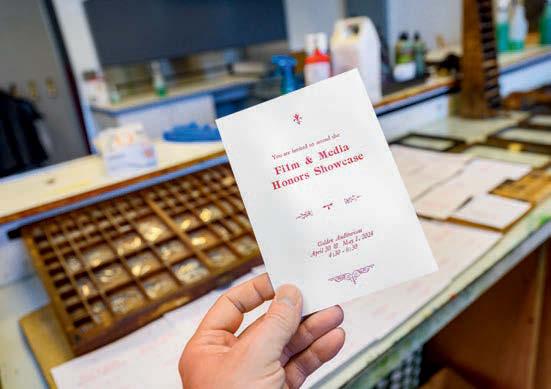
This year, as Blunnie was preparing to make his capstone film about letterpress, he asked Schwarzer if he could have access to the printmaking studio and the presses. She made a deal with him: He could have a key if he would make the equipment functional again.
His work started in January: “It became a matter of identifying what was broken,” he explains, “ordering new parts, making sure those parts worked, cleaning and oiling, and then organizing all the pieces.”
“The process itself is meditative,” Schwarzer says. “There’s a rhythm to it: You put the paper in, you make sure it’s inked up, you press it, and then you do the next one and the next one.”
The
Professor Lynn Schwarzer

Two of these proof presses are 5" by 8" and the other is 6" x 10". “They’re not for laying out a full newspaper type,” explains Schwarzer. “It is enough to do business cards, invitations, and
of a former Little Hall custodian. business and artwork that is of a scale.”

like and papermaking.
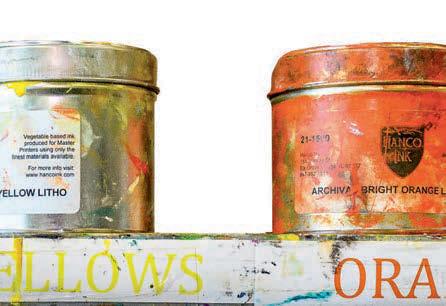


In recent years, letterpress has had a resurgence, she notes. “It’s a little like vinyl; the appreciation for the manual setting of this as opposed to the digital.”
to the Aleta Mayne
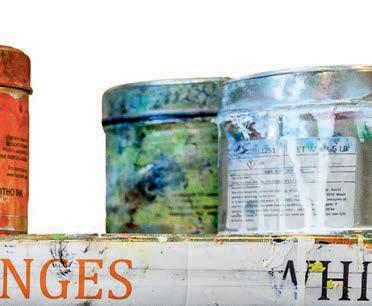

Lou Kaminski
Just before finishing his first year as a Colgate staff member, Lou Kaminski completed a 100-mile race on March 23 along the Prairie Spirit Trail in Ottawa, Kan. This was his second 100-mile race, after completing the first eight years ago. He placed 7th overall and 5th in his division in the March race with a time of 19:32:38, among the 40 runners who finished the race (out of the nearly 60 who started).
As someone who started seriously running in your 30s, what sparked the transition from more casual running to taking on longer and longer races?
I have always been interested in running, but never quite had the confidence in myself to just go for it. I worked at [Johnson and Wales University] in Miami and incorporated a lot of events with students into my running, which sparked an even bigger passion for wellness. I also had a friend who encouraged me to join a running group, and the rest was history. I found my community and made some lifelong friends. It was

that group that opened my eyes to distance running and ultramarathons.
What qualities does someone need to be a 100 miler?
I’ve never been one to give up, so I’ve always tapped into those reserves when it gets really tough.
For me, distance running, in particular ultramarathons, has always been about testing the mental and physical limits. I say everyone can run, you just have to get out the door and get your feet moving. There is no particular race, gender, age, or body size at these races. I do think you need to have mental grit, patience, and perseverance to get through a race of this distance. I’ve never been one to give up, so I’ve always tapped into those reserves when it gets really tough.
Do you have advice for someone looking to start running more seriously?
What has always worked for me is setting goals for myself, whether that is to make it to the end of the street, the next tree, finishing a 5K, finishing a 5K faster, or just getting out
the door. I also think having someone who can hold you accountable is important. I knew for this 100 miler that I had to provide data from my training runs to my coach, and I needed to meet his expectations, but I also knew that if I didn’t get my long runs in, I was going to be in pain on race day. I run in all conditions — rain, sun, sleet, snow, wind. I run when I’m tired, I run when I’m overwhelmed, I push myself to run when I don’t want to, and I find people who can push me even more on the days when I really don’t want to get moving.
How does running play a role in your job at Colgate?
Having my office decorated with race medals and pictures helps me break barriers with students. It humanizes me and almost always allows me an opportunity to talk with a student on a personal level, whether it is running, ultrarunning, or just outdoor adventures. My Weimaraner, Enzo, has also done a lot of
running with me, completing several 31-plus-mile races with me. Bringing my dogs into the mix when meeting with students also eases students’ anxiety about being in the conduct office. Running also allows me the ability to disconnect and process things that go on in my life, both work and personal. I don’t run with a phone or music, so it’s just me in my own head, with my own thoughts, mile after mile. I firmly believe that it lets me start each day refreshed.
— Interview by Stephanie DeVries
Kaminski has made connections with colleagues across campus who are also runners, including Associate Professor of Psychology Lauren Philbrook (who was featured in Runner’s World for completing a marathon while pregnant) and Professor of Physics Rebecca Metzler (who, with Philbrook, runs long-distance races and trains nearly every day).
Katherine Wand ’24 had a senior year that proved to be as challenging as she expected.
A native of York, Pa., Wand’s biochemistry major required a thesis that involved 10 hours per week in the lab. That’s no easy task while taking other courses, working for the athletics communications office, and being a co-captain of the track team.
Managing her time in an efficient manner has been crucial to her success. A fondness for chemistry has also been vital — along with a determination to excel at a difficult topic. Thus far, one of her proudest academic achievements has been making the Dean’s List of Distinction.
She began her thesis last summer for a two-part course called Advanced Chemistry Research. Wand focused her project on understanding the order and disorder of selfassembled monolayers — a collection of organic molecules so small that they can only be seen using a powerful microscope. The work also involved trying to capture a highresolution image of monolayers, which was tough to achieve due to their infinitesimal size.

But Wand was not only accustomed to a grueling schedule, she learned to welcome it. “My schedule has been very demanding,” Wand says. “I live for that.”
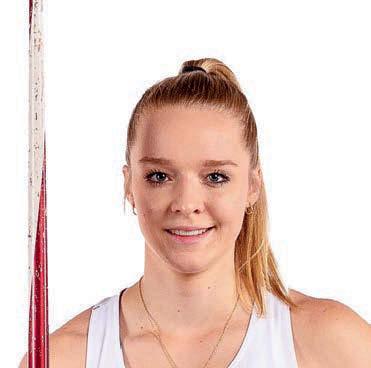
personal bests at every meet, she also helped the first-years adjust to collegiate athletics. The Raiders entered the season with 40 first-years, which is double the usual total and accounts for half the roster. Such an influx required all the captains to play bigger roles as leaders.
Men’s
The challenge didn’t stop Wand, who was using an infrared device and an atomic force microscope to take her images. “Monolayers are very small. Researchers know they are there, but have never seen them clearly by looking at images. Our goal is to see it by taking nice photos publishable photos.” Her instructor, Assistant Professor of Chemistry Eric Muller, constructed the equipment to take nanoscale images.
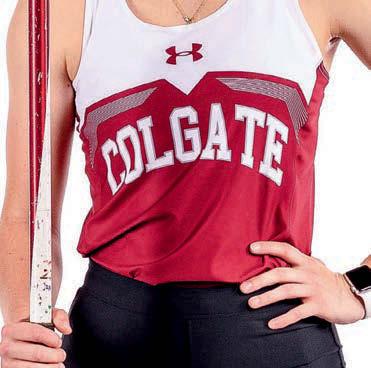








“There’s a learning curve. But a lot of first-years have shown up and done really well,” Wand says. “Over the next few years, we are going to be very good.”
She says she’s happy with her success as a student-athlete and thankful that she could play a sport while taking a STEM major. “Some schools don’t allow STEM majors [to participate in] athletics because of labs,” she says. “I’m happy to have been able to do both.”
Now Wand is starting her life after Colgate. She’s landed a role as an operations leadership development associate with Teva Pharmaceuticals in Salt Lake City. “It is a great place to start my career; my overall goal is to learn and grow,” she says.
Wand leaves Colgate with many wonderful experiences, she says. “I have learned so much about myself and in general. My team, my major, plus my support system have been so beneficial.”
— Omar Ricardo Aquije
Gavin Fowler ’24 came to Colgate to study astrogeophysics. The Hopewell, N.J., native grew up with a love for math and science, especially geology and astronomy. By choosing Colgate, he had the opportunity to study a topic that combined all his favorite subjects while allowing him to join the track team as a distance runner.
After two years at Colgate, an opportunity emerged that Fowler had not envisioned when he began his college career. Heading into summer 2022, Fowler was invited to work with Associate Professor of Physics Jonathan Levine on a project that would later be selected by NASA for a mission to the moon.

When Wand was not in or classroom, she was track team as a member of the throws and jump squads. past season, she competed at events throughout York and along the East Coast.


While aimed

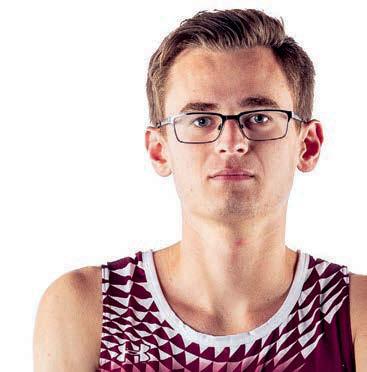

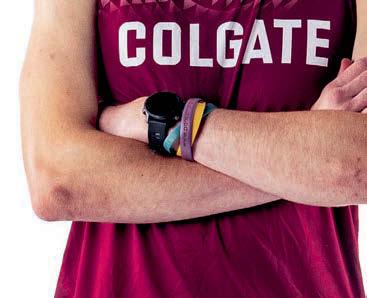
The project is called CODEX (Chemistry Organic and Dating Experiment), and it consists of a one-of-a-kind spectrometer that’s built for spaceflight and designed to help scientists understand the age of rocks. Levine, one of the project’s lead scientists, has worked on CODEX with researchers from the Southwest Research Institute for 20 years. The instrument is kept at the institute’s Boulder, Colo., facility, and throughout the years, Levine has invited students to work with him on the project.
a lead instrument institute’s years, the In various
Fowler took on a number of vital tasks for the collaboration: In his first summer, he did various lab jobs, including data analysis of rocks; he spent the following summer in Boulder, working directly on the prototype.
“It took a lot of time to learn,” he says. “But it has been Summer
really rewarding.”
While Fowler was in Boulder, NASA announced it had selected CODEX for a lunar lander/ rover mission to the moon. The spectrometer would be used to study the formation of the moon and its volcanic history.
Fowler says everyone involved in the project was ecstatic when NASA made the announcement: “It was really cool to see it happen.” While no official launch date has been set, the earliest is 2027.
CODEX is made up of several cumbersome lasers. But in order to meet NASA’s weight limitations, researchers have been reconfiguring the prototype to make it lighter, meaning fewer lasers. “We’ve been doing research into how we could collect data with only three lasers,” Fowler explains, adding, “for the most part, we have it down.”
He also co-authored a paper on the project, which was published by the Planetary Science Journal in 2023.
Levine applauds Fowler for his work: “Working with bright students like Gavin is the thing I like most about my job at Colgate. Gavin Fowler has a special ability to get to know his data the way some others know people: Each measurement has its own special qualities, idiosyncrasies, and even personality, and Gavin astonishes me with his ability to juggle all these in his head. That quality is what allowed us to get important science out of what had been a confusing set of observations.”
While Fowler’s commitment as a distance runner on the track and field team often required traveling and devoting considerable time to training, he found time to tutor two introductory physics courses, and he joined the physics and geology clubs.
Now that he’s graduated, Fowler is preparing for the next step in his journey: enrolling at the University of Chicago to pursue a PhD in cosmochemistry.
— Omar Ricardo Aquije

Colgate’s Varsity Eight and Varsity Four boats earned first-place finishes in their respective petite finals to help the Raiders finish
seventh in the Patriot League Championship at Cooper River (Pennsauken, N.J.) in May.
The Raiders’ Varsity Eight shined in the petite final, securing a time of 07:06.865 to claim the top spot over secondplace Loyola and third-place Lehigh. In the Varsity Four petite final, Colgate crossed the line with a time of 08:29.724, 3 seconds faster than Lehigh to claim first place.
“We were hoping to peak at the right time, and I felt like our boats finally did that today,”
Quinn Livesay ’25 was voted as a first-team
All-Patriot League catcher, highlighting a list of five Raiders named to All-League squads in 2024. Jillian Herbst ’25 (second base), Rachel Carney ’24
(shortstop), Adrienne Nardone MAT’24 (designated player), and Kiley Shelton ’27 (outfield) were all placed on the All-Patriot League second team.
The five selections are the most for a Colgate squad since
2011 when six Raiders earned spots on the first and second teams combined. It’s also the most honorees named to AllLeague squads in Coach Marissa Lamison-Myers’ six-year tenure. — Quinn Schmidt

said Head Coach Jim Lister. “We have a lot of returners, so there’s a lot of excitement about coming back next fall and being a better program next year. We will have a lot more rowing maturity in our boats, and that will be revealed in our depth with the addition of our incoming class.”
Colgate’s 2V8 brought home a second-place time of 07:36.856 in the petite final. They’d qualified in their heat race by placing fourth with a time of 07:56.309. The Varsity Four kicked things off with a fourthplace finish in its heat with a time of 08:38.224. The Varsity Eight secured a spot in the petite final with a fourth-place time of 07:14.973.
— Jordan Doroshenko
work, dedication, and commitment culminated in a trip to Indianapolis earlier this year where she was one of 40 women working in college athletics selected to attend the 2024 NFL Women’s Forum.
“To be there made me realize that the hard work I put in and the faith I had in myself was all worth it,” she says.
The invite-only forum is one of the few programs worldwide that connects women in college football with NFL owners, head coaches, and club executives during a daylong networking event. Paduano spent two days rubbing elbows with the NFL’s finest, including Commissioner Goodell and all 12 of the current full-time female coaches. For the first time, all 12 of the women sat together on a panel where they discussed the best ways to navigate the maledominated sports industry.
Backed by top-10 finishes from Dugan McCabe ’24 and Robbie Herzig ’25, Colgate fired a 290 as a team — the best single-round by any team all weekend — to finish second at the Patriot League Championship for the second consecutive year.
Forty-eight golfers across the eight Patriot League institutions competed in the
three-day championship at Saucon Valley Country Club’s par 72, 7,901-yard Grace Course (Bethlehem, Pa.) in April.
Colgate was led by McCabe, who finished fourth with a three-day total of 73-76-71=220 (+4). Herzig was hovering around the top five all weekend and finished tied for fifth with a score of 225 (+5) during the tournament.
“History was made at that moment,” Paduano says. “The information they shared was incredible. Not even just what it is like to be a woman in this field, but also how to succeed and thrive.”
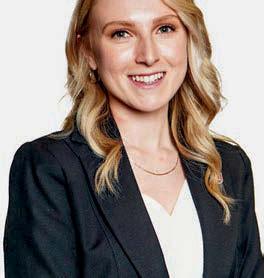
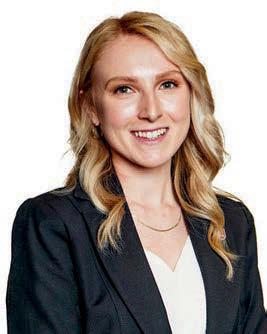
Five years ago, if you would have told Abbey Paduano, the current Colgate football director of operations, that she would be standing in a room with Roger Goodell and hundreds of NFL staff members at the 2024 Women’s Forum, she would have called you crazy. But the college hockey player turned operations extraordinaire has carved out a promising future in the football world. Years of hard
Paduano played hockey at SUNY Cortland and majored in sport facility and event management before pursuing her master’s degree in human resources at Albany Law School. She joined Colgate through an internship as athletics event and marketing coordinator.
As she was finishing her master’s, Paduano applied for the Colgate football director of operations position. She’s now entering her third season and was recently honored with an Individual Staff Excellence Award by Colgate for her accomplishments in successfully operating a Division I football program.
“I’m forever grateful to the people and connections I made along the way to help me get to where I am today, especially working with Head Coach Stan Dakosty. I owe a lot to him for having faith in me and helping me find my passion.”
— Quinn Schmidt
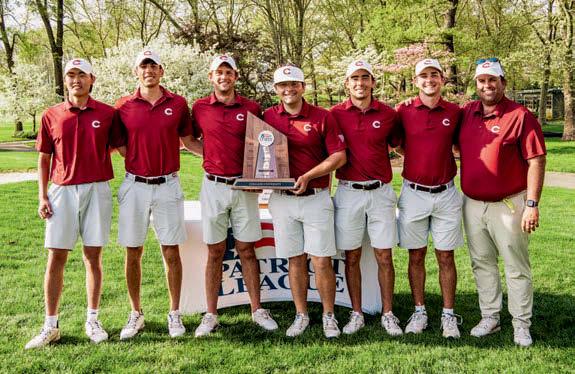



















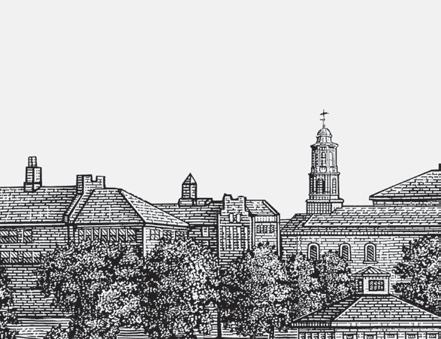
new 65,000-square-foot basketball and volleyball arena will replace the Reid Athletic Center. Construction of the facility is slated to begin in February.
Named the Carey Center in honor of a lead $23 million gift from the Carey family Trustee Emeritus Chase Carey ’76, his wife, Wendy, and their children Steve ’12 and Tara ’13 — the new arena will serve as the home for men’s and women’s basketball and volleyball. The facility will also be the first of two buildings planned for an athletics quadrangle that will ultimately replace the existing facilities currently housed in the Reid Athletic Center.
The Carey Center will be heated with a geothermal heating system, setting a new standard for energy efficiency and conservation in athletics facilities at Colgate, which reinforces the University’s dedication to creating a more sustainable future for the campus. This decision was guided by Colgate’s recently updated Green Building Standards, which call for thorough building life cycle analysis and highlight the long-term environmental and economic benefits of zero-emission technologies such as geothermal heating.
Built in 1959 and designed for a student body of just 1,500 men, the Reid Athletic Center no longer meets the physical, technological, or programmatic standards necessary to support a modern, coeducational, nationally competitive Division I athletics program for Colgate’s 25 varsity teams.
“This is a significant, comprehensive endeavor on behalf of student-athletes,











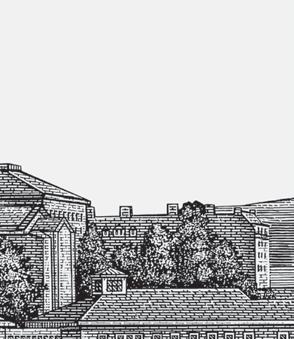
and it is happening because of the generosity of alumni, parents, and friends, most especially the Carey family,” says President Brian W. Casey. “We rely on the kindness of these donors to help move Colgate athletics forward. What is just as exciting is that this facility will also provide a new flexible venue for significant University events, gatherings, musical performances, and so much more.”
With a seating capacity of 1,650 and additional standing room, the arena will also feature a practice court; team suites for volleyball and men’s and women’s basketball; the Hall of Honor; media facilities; and a satellite sports medicine, strength, and wellness space.
“Anytime you’re going to get something new of this magnitude, you’re extremely excited about it,” says men’s basketball Head Coach Matt Langel. “For me, it speaks to the mission of the institution and the individuals it represents.”
Wrapped in glass and locally quarried bluestone to complement the look and feel of the campus’ existing buildings, the twostory venue will occupy the space currently held by Colgate’s Facilities Department, just west of the current Reid Athletic Center footprint. The first floor will house the arena court, locker rooms, coaching offices, satellite sports medicine and strength and conditioning spaces, nutritional and wellness space, a media and production studio, and more. The second level will include the competition arena concourses along with a practice court, strength and conditioning mezzanine, and a recruiting lounge.


“For an athlete, having everything they need in one space — from a weight room to nutrition, to athletic training, to a locker room — and having access to multiple courts and baskets whenever they want is important,” says women’s basketball Head Coach Ganiyat Adeduntan. “From a coach’s perspective, the ability to meet with your student-athletes and have communication with people who support your team all in one area is essential.”
The second planned new building, an expected 40,000-square-foot facility, will serve multiple purposes while focusing on priorities of unifying sports performance and training, locating all elements of the football program within one facility, and providing additional space for studentathlete support.
Designed by Robert A.M. Stern Architects, LLP, Building 2 will be the primary location for nutrition, health and wellness, and academic support. It will be finished with a traditional exterior façade, paying tribute to the University’s historic bluestone while mirroring the look and feel of the neighboring venues such as Sanford Field House, Trudy Fitness Center, and Lineberry Natatorium. The construction timeline for this project is now in development.
“Colgate continues to show the country and the Patriot League that we’re serious about being great at academics and athletics,” says volleyball Head Coach Ryan Baker. “There’s a sense among my peers that Colgate is doing both really well and it has put Colgate on the map nationally.”
The construction of the Carey Center and Building 2, along with Sanford Field House, will frame a new athletics quad at Colgate. The quad will establish more active space for recreation in the heart of athletics, as well as serve as a place for community gatherings on game days and during other campus events.
The athletics quad — created by the eventual removal of Reid — will include improved, safer pathways to and from the main athletics buildings at Colgate. As part of developing the Lower Campus, the quad will also serve as an event staging space, and will provide natural pathways from Andy Kerr Stadium to Huntington Gymnasium. Upon completion, visitors to Hamilton approaching from the south will be welcomed with a new, beautiful arrival experience of Colgate athletics.
— Jordan Doroshenko
The University marked the beginning phases of the Lower Campus Initiative this summer with construction and restoration projects at 66 and 70 Broad St. Over the next several years, Colgate will invest more than $200 million to enhance student and residential life.
“Changes in the first two renovations will support a holistic program that supports community, addresses accessibility, and creates student housing for Colgate’s next century,” says Vice President and Dean of the College Paul J. McLoughlin II. “We are constructing not only sleeping spaces, but also social, dining, and study places, where juniors and seniors can embrace community while enjoying greater independence.”
The chapter house of Delta Upsilon at 66 Broad St. currently houses 33 students, with 26 in double rooms. A yearlong renovation project will reimagine those living spaces, creating 26 single rooms and four doubles, increasing the capacity and comfort of the house for students. Meanwhile, social and party spaces will be separated from living quarters, so that those who wish to study and rest may do so, regardless of other activities taking place at the house.
The University will recognize DU’s history at Colgate and its traditions through the selection of accent colors and decorations reflective of their fraternity’s charter. Hallways and common spaces will be bright and well lit, and a new dining room will facilitate group meals. Most importantly, the building will be made accessible through the installation of lifts and ramps.
Throughout its long history, 70 Broad St. has been expanded on multiple occasions. Renovations will restore the original house facing Broad Street — underscoring the University’s commitment to historic preservation — and replace the patchwork of later additions with a single annex that matches the architectural character of the home. The design

will also incorporate a green roof. This new space will include accessible bedrooms and bathrooms, a dining room, living room, and kitchen.
In its current form, 70 Broad St. can house 11 students, eight in double rooms. Following renovations, it will welcome 20 students, all in single rooms.
The University has pursued sustainable building practices in all of its recent construction projects, and the tradition continues at 66 and 70 Broad St., where building envelopes and mechanical systems will provide greater efficiency in heating and cooling. Contractors will reuse materials and structures where possible.
While residents of both houses will be temporarily relocated for the 2024–25 academic year, members of each special interest community will continue to live and dine together.
After completing these important projects, the University will continue to pursue its Lower Campus plans by regrading the West Row, the area behind current Broad Street houses, and installing utilities to support new construction.
These renovations are just the beginning of a complete transformation of residential life for juniors and seniors. The Lower Campus project — a mix of creation and recreation — will renew the physical spaces along Broad and College streets. The effort reimagines how juniors and seniors live and interact with their peers, and it promises a more equitable residential experience across all four years as a way of fostering connections between undergraduates of all interests and backgrounds. The Lower Campus Plan will positively contribute to our students’ mental, physical, and personal wellness while helping them transition to life following graduation.
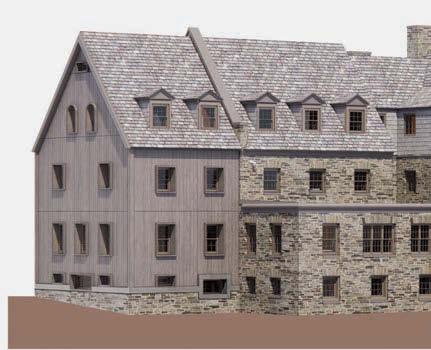



Addressing a standing-room-only crowd in Memorial Chapel on April 5, National Youth Poet Laureate Amanda Gorman invited the audience to “become part of the performance,” demonstrating how spectators at poetry readings often snap their fingers when they hear something that particularly resonates.
“I want to hear you, Colgate,” she explained. “You are part of this, so please feel free to make some noise for me.”
Her visit was the keynote event during the second annual celebration of arts, creativity, and innovation at Colgate, which brought hundreds of visitors to campus for performances, workshops, presentations, and panel discussions. Gorman’s talk was sponsored by the Kerschner Family Series Global Leaders at Colgate.
She began with three poems from her 2021 bestselling book, Call Us What We Carry. Gorman then joined Kezia Page, professor of English and Africana & Latin American studies and John D.
and Catherine T. MacArthur Chair, for a conversation that ranged in topics from sociology and Black history to Gorman’s “speech impediment turned superpower” and texting with Oprah. (It was Oprah, Gorman explained, who gifted the young poet with the now-iconic yellow Prada coat for her reading at the 2021 presidential inauguration, along with her “caged bird” ring and earrings — a nod to the late Maya Angelou, she said.)
Much of Call Us What We Carry, including the titular work, was inspired by Gorman’s observations during COVID-19 — and the pandemic’s “lasting impact on social trust and human connection,” she said.
The youngest inaugural poet in U.S. history, Gorman also shared how dramatically her life changed after delivering her poem, “The Hill We Climb,” as part of President Biden’s inauguration in 2021. “I remember stepping off the podium. I was like, ‘Oh, that went better than I expected,’ and I remember … looking at my phone, and it was basically on fire,” she said. “I think I’m still processing that change…. I’m just trying to handle that growth with as much intentionality and grace as I can.”
The weekend’s events began in the chapel on Thursday, when former University president Rebecca Chopp joined Doug Johnson, dean of academic and curricular affairs and William R. Kenan Jr. Professor of psychological and brain sciences, and Ellen Kraly, professor of geography

and environmental studies emerita, for a discussion on Alzheimer’s disease.
On Friday afternoon, campus guests participated in a series of faculty-led, ACIfocused workshops. Hosted by faculty in music, computer science, art and art history, earth and environmental geosciences, peace and conflict studies, museum studies, and theater, students, alumni, and guests experienced Colgate’s innovative arts curriculum firsthand through experiments and improvisation.
Saturday’s program began with a panel discussion featuring arts and innovation faculty members and alumni. The panelists shared their thoughts on how the new Bernstein Hall — the former Benton Center, at the heart of a new Middle Campus — will help foster collaboration and innovation across disciplines and inspire student and faculty creativity.
“We’re thinking really carefully about arts and technology and the fact that these two things are increasingly impossible to separate out,” said Mary Simonson, the Daniel C. Benton ’80 Endowed Chair in arts, creativity, and innovation. “That’s something many of us in our work think about all the time — how we can help our students understand that those two worlds are increasingly one world.”
At the Thought Into Action Entrepreneur Showcase, students and alumni presented their ventures. The informal showcase was followed by the presentation of the Colgate Entrepreneur of the Year Award to Craig Hatkoff ’76, co-founder of the Tribeca Film Festival.
In the “Shark Tank” portion of the event, five groups of student and alumni entrepreneurs presented their ventures, which included a line of farm-grown lavender products, a collectible sports card resale business, and a soy-free soy sauce.
The winner and the recipient of a $5,000 prize as chosen by the panel of entrepreneur judges: Pair + Care, a student-run childcare service founded by Chayce Canty ’27, Maddie Theveny ’27, and Henry Galicich ’27.
In his remarks, President Brian W. Casey shared his vision for the future of arts, creativity, and innovation at Colgate — and its burgeoning Middle Campus: “We are just a couple hundred yards away from what will be Bernstein Hall, which is the physical manifestation of an institution embracing creativity in all its expressions,” he said.
“From my vantage point, this is a weekend filled with energy, excitement, intelligence, and a sense of the future.”
— Mary Donofrio
Colgate is a small institution in many ways, but it is a complicated thing to make 50-plus majors and minors work.
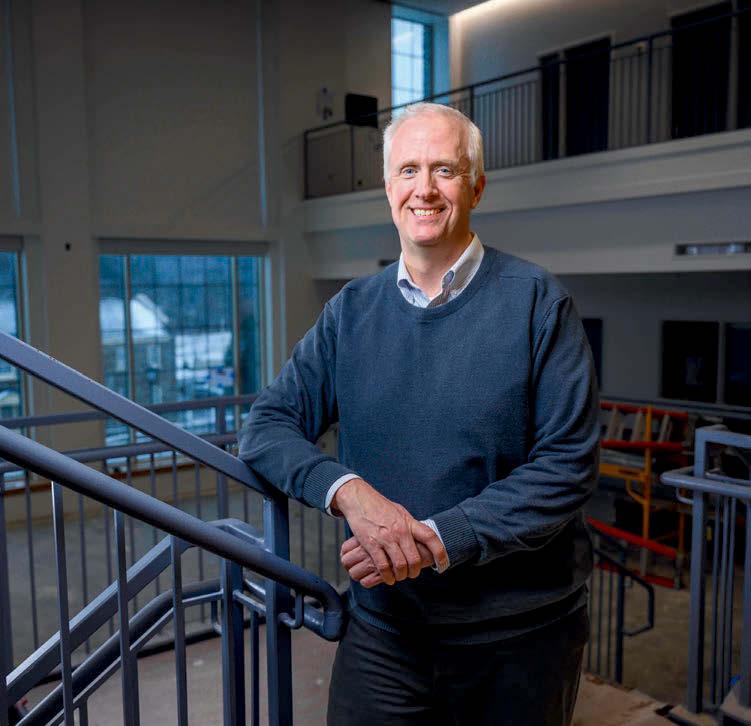
Professor Doug Johnson in the new atrium space in Olin Hall’s addition while under construction
Professor Doug Johnson on what makes Colgate’s “multidimensional” academic enterprise work
Amember of Colgate’s psychology faculty since 1996, Professor Doug Johnson has won numerous awards for his teaching, including the Jerome Balmuth Award, the Colgate Alumni Corporation Distinguished Teaching Award, and the Phi Eta Sigma Professor of the Year Award, to name a few.
In 2022 Johnson was honored with the William R. Kenan Jr. Professorship in psychological and brain sciences. Endowed professorships recognize the excellence of University faculty in their research, teaching, and service to the community; Colgate will establish 25 new professorships as part of the Campaign for the Third Century. While Johnson has enjoyed success in
the lab and the classroom, it’s his recent work as dean of academic and curricular affairs that he has found, in some ways, even more impactful.
“My counterpart at another institution put it to me like this: In each class, you’re impacting 20 students. But if you do this job well, you’re going to be impacting all 3,000 students and the work lives of 300 faculty members,” Johnson explains. “The scope is much larger.”
Indeed, Johnson’s new position (he took on the inaugural role in summer 2023) requires a deep understanding of Colgate’s curriculum and its faculty — and how to leverage faculty strengths to help students thrive.
“Each semester is like solving a new, multidimensional puzzle,” he says.
Colgate Magazine talked with Johnson to learn more:
Attracting and retaining outstanding faculty is a pillar of the Third-Century Plan. How does your work help Colgate accomplish this goal?
I like to think of my job as helping allocate generous but limited resources. For example, we have a generous sabbatical
policy at Colgate, which is needed for faculty members to get their important scholarship done. But when people are on sabbatical, there’s not an infinite bucket of visiting professors. I have to make difficult decisions about where those visiting assistant professor lines go and how best to allocate those resources. That requires understanding the curriculum, how each department does what it does, and the overall goals of the institution. Colgate is a small institution in many ways, but it is a complicated thing to make 50-plus majors and minors work.
How do you help faculty find balance between teaching and scholarship?
One important way is through teaching load. There are schools where faculty teach up to eight courses a year. At Colgate, we teach five, and many of the new distinguished chairs come with a four-course teaching load. That’s not extra time faculty are spending on a beach sipping mai tais — they’re engaging with students on research and working on their own scholarship. Colgate is an especially supportive institution in that we provide the resources to get their scholarship done; we have a really strong research council and offer lots of grants. I believe our faculty honestly want to be incredible teacher-scholars, and our promotion and tenure processes reward that. It’s hard to be a world-class scholar and an excellent undergraduate teacher; Colgate has roughly 300 of those people, and it’s amazing that we do.
Moving from the faculty to the administrative side of the University gave you a new perspective on how Colgate operates. What surprised you most?
Just how much everyone — from buildings and ground staff, to the people who do accounting, to human resources — cares about the academic mission of the institution. It is primary in everybody’s mind. We are here to be a premier undergraduate liberal arts college and to support world-class scholars. That only happens when everybody values the mission, and when we’re all working toward it. As a faculty member, I didn’t completely understand just how many people it takes to make that happen.
— Mary Donofrio
Veronica Padilla Vriesman ’17, an assistant professor of geosciences at Oberlin College, is uncovering how shells tell the story of climates past, present, and future.
Inside the Quaternary Invertebrate Paleo Lab where Veronica Padilla Vriesman ’17 works at Oberlin College, the white-tailed deer and tractor trailers of small-town Ohio are nowhere to be found. Plastic baggies full of wedge-shaped aquatic mollusks from the Pacific Coast litter the shelves. A microscope sits on a lab bench, surrounded by specimens of pearlescent mussels. In the back, shells overflow from a cardboard box.
A paleontologist and marine scientist, Vriesman’s research focuses on how changes in the ocean’s temperature, acidity, and other factors — either natural or humaninduced — affect the composition and structure of shells. In doing so, she hopes to understand what those changes mean for the overall health of coastal environments.

We can get estimates of conditions like temperature and acidity, but then we can also look at qualities and characteristics of the shell.
Vriesman is not alone in her fascination with shells: “Shells have this long-standing relationship with humans because humans have eaten shell[fish] and collected or used shells for tools or jewelry for more than 10,000 years,” she explains. She has become especially interested in California mussels, which, beyond being culturally important, play a critical role in coastal ecosystems, supporting the well-being of hundreds of other coastal species by filtering water, providing shelter, and minimizing erosion. These mussels grow their shells through a process called calcification, during which they produce proteins and minerals. These minerals form bands, like how tree trunks have growth rings, but they don’t only show the organism’s age. The composition of the minerals also acts like a tiny time capsule that captures features of the environment in which the shell grew. “We can get estimates of conditions like temperature and acidity, but then we can also look at qualities and characteristics of the shell: its shape, its size, its pattern, how fast the shell was growing, how happy [the organism] was in its environment,” Vriesman says.
Vriesman started researching historic shells and the information they held when she was a graduate student at University of California, Davis, where she graduated with her PhD in 2022. “I was interested in reconstructing past climates,” she explains. She wanted to look at shells from the past 12,000 years to assess previous ocean conditions to build a better understanding of how ocean climates once looked — on scales as large as millennia and as short
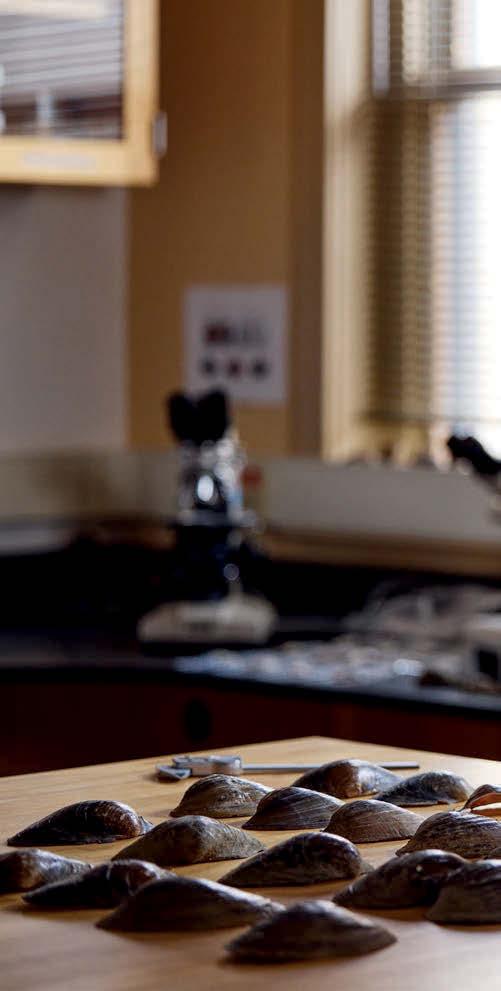
as seasons — and about how mussels responded to those climates.
But to understand shells of the past, Vriesman first had to learn more about the shells of the present. Using tools like microscopes and chemical analyses, she examined California mussel shells from the early 2000s and 2020s and compared them to already-recorded ocean conditions to develop a better baseline understanding of shell composition so she could use that knowledge to study older shells.
Some of her findings were quite surprising. Over those two decades — which, according to Vriesman, “is really geologically fast” — the minerals in mussels’ shells had become much more disarrayed, showing that their composition and growth was changing rapidly. “It was an unexpected
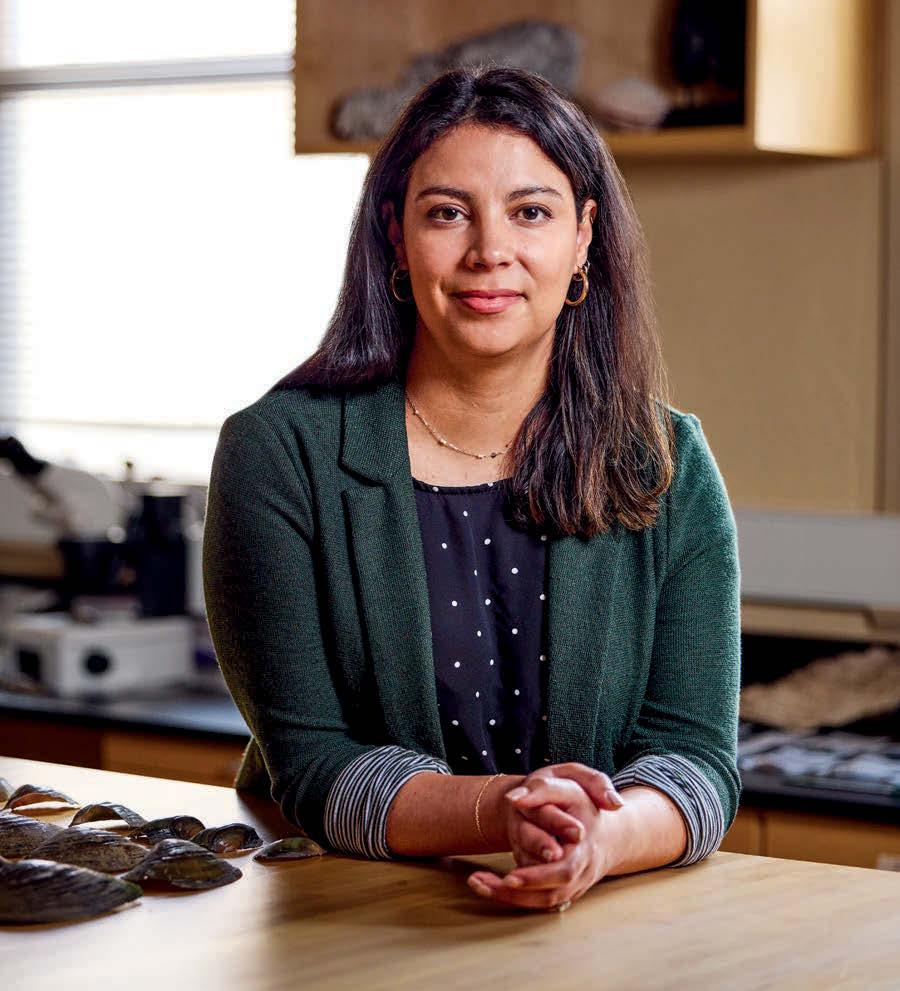
result that is now making up a central aspect of my research,” Vriesman says.
Now, she’s curious about what this rapid change means for the mussels and their ability to thrive in oceans with increasing temperatures and acidity. “Are they trying to calcify faster, and they’re adapting? Or are they really being negatively impacted, and this is a sign that they aren’t doing well?” she says. Vriesman is interested in figuring these questions out: “It’ll involve looking at modern shells but also looking into archival records to see if we’ve seen this before and it bounces back or if this variability has never appeared.”
But California mussels aren’t the only species that can provide some of these answers. Since Vriesman joined Oberlin’s geosciences faculty two years ago, much of
Illustrations by Bernie Freytag
her research time has been spent developing her lab and recruiting students, who are already starting to look into different types of shells — gathered from the coasts of the Pacific to the Atlantic and even to the Great Lakes. “The plan is to study many ecologically and economically important shells to see how a variety of species are responding and to get a big-picture understanding of what we’re doing to coastal ecosystems,” she says. “Mussels are just one example of many species’ stories.”
— Lily Stewart
Vriesman never planned to go into science, but her experiences in Colgate geology classrooms — including one where she got to hold a multimillion-year-old seashell — motivated her to pursue research.

In The Great Murdering-Heir Case, Professor William Meyer takes aim at a seminal law case.
On the afternoon of April 25, 1882, Francis Palmer took a swig of rum that turned out to be his last. A farmer in upstate New York, Palmer had no idea that his 17-year-old grandson, Elmer Palmer, had put strychnine in the liquor, intending to kill him. His motive was clear: Elmer
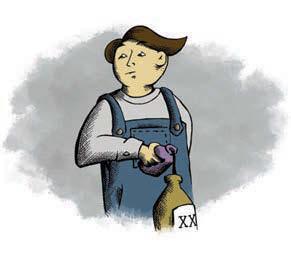
was heir to his grandfather’s property. Although his crime was quickly discovered and Elmer found guilty of seconddegree murder, nothing in the letter of the law prevented a murderer from inheriting the property of his victim.
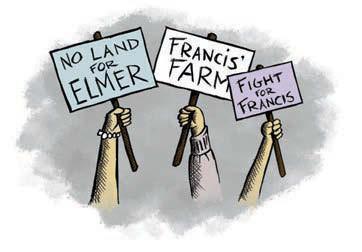
Elmer’s aunts protested when a lower court ruled accordingly, and in 1889, the New York Court of Appeals overturned that decision. The case, Riggs v. Palmer, has become a classic in first-year law classes, used to question an overly literalistic interpretation of the law. “The case is written very much as a universal principle,” says William Meyer, author of The Great Murdering-Heir Case: A Biography of Riggs v. Palmer (State University of New York Press, 2024). “But the case is really not what everyone has taken it to be. It was really an ad hoc and ad hominem decision just good for this one case — and never really intended to be more general.”
A geography professor at Colgate, Meyer used the burgeoning tools of legal archaeology, which scrutinizes the origins of a case, and case biography, which looks at the aftereffects of a decision, to examine how Riggs was decided and interpreted over the years. Those are tools he’s uniquely suited to use as a geographer. “Geography is both a natural and social science, and it’s pretty standard in those disciplines to look for all the sources you can find and test your assumptions against them,” Meyer says. “Legal studies doesn’t routinely do that, focusing only on the text of the decision instead.”
Legal studies has long been “a hobby” of Meyer, and Riggs often came up in books in that field. When Meyer had a sabbatical in 2019, he decided out of curiosity to look into the case, scouring old newspaper stories online. “I quickly noticed there were facts about it that didn’t jibe with the image I had of it,” Meyer says. He dropped other projects to focus on the case. Among its curiosities was that the jury convicted Elmer of seconddegree murder — a murder of passion — even though the evidence showed it was clearly premeditated, which should have warranted a first-degree murder verdict.
Another quirk is that even though seconddegree murder was normally punishable with life in prison, New York at the time was piloting reformatories for youthful offenders, and Elmer only served four years before he was let out and stood to inherit his grandfather’s farm. Those facts so galled
the Court of Appeals judges that they twisted themselves into knots to overturn the lower-court decision, offering two contradictory explanations for, in effect, amending the law. On the one hand, says Meyer, they said that it just hadn’t occurred to the lawmakers that such a situation might arise, and that they would have excluded murderers if they had thought of it. On the other hand, they said that the legislators had had such an exception clearly in mind and had assumed that it went without saying.
For some 30 years after it was decided, Riggs was pilloried by the legal profession as wrongly decided. “The prevailing idea of the 1880s and some decades after was that

judges have no business making law; all they can do is follow it,” Meyer says. It was only later, in the 20th century, when judges exercised more latitude in interpreting the law, that Riggs was pressed into service to justify that trend, first by influential Supreme Court Justice Benjamin Cardozo, and later by other judges and scholars. Meyer doesn’t take a position on whether that judicial creativity is warranted, only on the use of Riggs to justify it. “All these lessons it supposedly teaches may or may not be true, but they don’t follow from the case,” he says. “It’s too freakish and unusual to do the work it’s expected to do.”
Meyer’s critical examination of the case illustrates the usefulness of analytical tools such as legal archaeology and case biography for legal studies. On the one hand, he says, judges shouldn’t be expected to be historians and investigate every case they cite; on the other, this kind of intensive research can help set the record straight and test the validity of important precedents, says Meyer, who plans to split his time 50/50 between geography and legal studies going forward. “For a lot of legal questions, you need a wider range of sources than legal scholarship usually relies on,” he says. “And people would also learn more and get more engaged with cases if they knew something about the people and context behind them.”
—
Michael Blanding
How Korean pop music has become a global phenomenon
In South Korea, they call it Hallyu. Translated, it means the “Korean wave” — an explosion of pop culture that’s rolled from the small East Asian peninsula across the world in recent decades.
“It’s about television series and film, and then from about 2005 on, it’s music,” says Paul Lopes, associate professor of sociology. In previous generations, South Korea had made its mark on the world with electronics and cars, but this was something different. “It meant a lot to the Koreans that they were exporting culture.”
Lopes explored the unexpected rise of Korean pop music — or K-pop — in a special issue of Asia Pacific Business Review, which he co-edited with Korean sociologists Ingyu Oh, Lynn Pyun, and Jangwoo Lee. A longtime expert on the American music industry, Lopes participated in a January 2023 conference on K-pop, from which the journal articles emerged.
The startling success of K-pop has been woefully understudied, he says. After all, in 2022, Korea had two of the top-10 musical acts in the world, with the boy bands BTS at no. 1 and Seventeen at no. 6, according to rankings by the influential International Federation of the Phonographic Industry. Taiwanese pop star Jay Chou was no. 9, while the rest were stars who are more popular in the U.S., like Taylor Swift, Bad Bunny, and Drake. In 2023, BTS only dropped to no. 2 behind Swift.
“[K-pop has] a huge fandom, not just in Korea, not just in Asia, but also across the globe,” Lopes says. “So that’s a phenomenon worth asking questions about.” It’s all the more surprising given the small size of Korea (compared to other Asian markets such as Japan and China) and its status as a postcolonial country, having been liberated from Japan just after World War II. In part, that is due to the uniqueness of the music itself. One paper in the issue discusses how the music caters to a female fan base with something it terms “gendered melancholia.” “It’s that sense of sadness that comes from
being marginalized in the way you are viewed by society,” Lopes says. “That is universal for women.”
Even the male-fronted K-pop bands don’t express masculinity in a typical style of a hip-hop or rock artist, he says. “It’s still masculinity, but it’s softer and it’s about healing,” says Lopes. “It’s one that feels very different than the masculinity women typically experience in their everyday lives or in other pop culture. It’s a kind of masculinity that accepts them and is comfortable with them.”
Another paper in the issue looks at K-pop fandom across the world to find that, indeed, it is women who are driving the global phenomenon through online forums that connect different fan communities. Other scholars in the issue look at the business of K-pop, finding its success in the strategy of its producers, especially record label SM Entertainment. The birth of K-pop stars started in the mid-1990s when they were manufactured by labels in an “idol system” that trained artists at a young age through a strict regimen. Although that first attempt died down, SM Entertainment resuscitated the phenomenon in the mid2000s, with the GLG strategy, standing for global-local-global. “SM Entertainment and the other major labels said, ‘We need to go out into the world and find creators
successful in the mainstream popular music market,’” Lopes explains. In Los Angeles, as well as London and Sweden, label representatives found songwriters and musicians who created the scaffolding of songs that then were brought back to Korea. At the same time, SM Entertainment wanted Korean artists and producers to fashion imported songs into a unique K-pop genre. The main strategy was to put together supergroups of up to a dozen performers in training since their early teens — who appeared in elaborate music videos that featured coordinated group dancing. Finally, SM Entertainment pursued a global strategy of distribution; locked out of mainstream channels, it concentrated on getting music directly to fans online. “It’s by distributing K-pop music videos on YouTube that really makes it a global phenomenon,” Lopes says. His own scholarly contribution to the issue looks at a paradox of K-pop’s success. Despite the popularity of the music worldwide, and even in the United States, few Korean bands have achieved the ultimate triumph: hitting the Billboard charts. One exception is BTS, which charted on Billboard once it signed with Sony. Lopes, with his co-authors Oh and Hyeseon Hwang, argue that that is no accident. While Billboard keeps its formula a closely guarded secret, it revealed a decade ago that its charts were
[It’s] a phenomenon worth asking questions about.
based on approximately 9% record sales, 34% radio airplay, and 27% streaming. That means that 61% of the determination comes from channels controlled by the major labels, says Lopes. “You’ve heard of pay-to-play or payola?” Lopes asks rhetorically, referring to the illegal practice of paying radio stations to play songs. “Well, it never went away.”
Although cash payments might be verboten, labels find other ways to offer perks, including free trips for station staff or increased advertising payments to encourage radio stations to play their artists. As far as streaming goes, Lopes adds, many people don’t realize that the largest streaming service, Spotify, is partly owned by Sony, Warner, and Universal Music Group, which run many of its playlists. “So even though BTS was no. 1 in 2022 and no. 2 in 2023, it’s not on these playlists,” Lopes says. There’s not much that can be done about that, Lopes adds, meaning that if K-pop bands want to break into the American charts, they need to follow in BTS’ footsteps and make deals with the major international labels.

Either way, K-pop continues to thrive even as it evolves. As the members of boy band BTS have all gone into mandatory military service, a new wave of female-fronted bands is gaining prominence. Meanwhile, SM Entertainment exploded last year over a feud between founder Lee Sung-man and his nephew and current CEO, Lee Sung-soo. But it is already charting new futures. At a news conference last year, Sung-soo outlined a big play to bring K-pop to the multiverse. Whatever lies in the future for K-pop, Lopes has been glad to bring a better understanding of the U.S. music industry to Korean scholars — and to help international scholars and the public at large better appreciate the “Korean wave.”
— Michael Blanding
For more about faculty members’ scholarly work, visit colgate.edu/ researchmagazine.





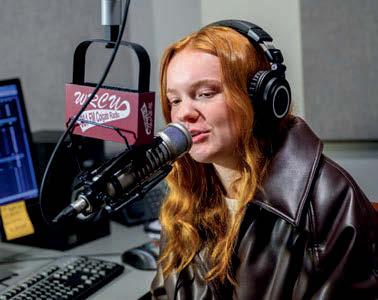
ByTateFonda
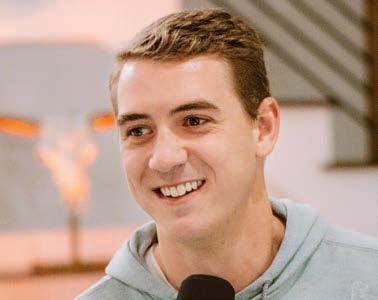
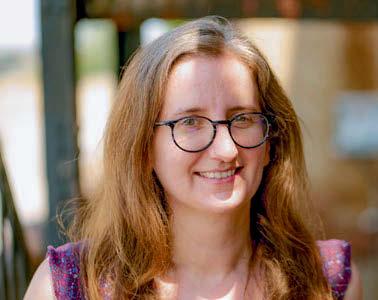

Tate Fonda ’25 interviews previous DJs who set the record in motion on 90.1 FM.
Imet my co-host during one of those whirlwind days of first-year orientation, when, in a sea of other students, Meg McClenahan ’25 and I noticed our similar red hair and introduced ourselves. A week prior, we had arrived early to Colgate: she for the WRCU pre-orientation and I for the Maroon-News program. So when she later asked me to co-host a radio show, which we decided to name Redhead Radio Hour, I was lucky to have an in.
Since then, we’ve found our niche as one of the station’s only folk music programs. On Tuesdays, in between selections from artists such as Neil Young and Big Thief, you’ll usually hear us spewing English-major jargon and talking about the best banjo players.
From there, I suppose I could tell you about the time we blew dust o of vinyl records and spun them on the air, or the time we just had to find the CD of It’s the Great Pumpkin, Charlie Brown for an autumn show, but I’ll hand the mic over to a few distinguished alumni, whom I’ve had the privilege to speak with on behalf of Colgate Magazine.

Martin’s guitar collection includes:
→ The 2012 Fender 50th Anniversary Jaguar in “burgundy mist”
→ Two seafoam-colored Fenders: the Thinline Telecaster and the Powercaster, one of three in circulation with the original “Fastback” name on the headstock
→ Danelectro’s ’59 Vintage 12-string in white and its ’59 Mod New Old Stock Plus Thunderbird in pink
→ A 1990 Fender American Stratocaster with a custom red paint job
→ Two blue guitars in Fender’s Squier line: the Supersonic Electric and Deluxe Stratocaster
→ A “sunburst” orange club bass by Höfner
→ Two acoustic guitars: a Taylor 514ce and a Fender Paramount
→ A 1934 National Duolian Resonator on loan from the family of Hobie Bowman ’11
Perry Martin ’11, digital product manager with Fender
When Perry Martin ’11 was 12 years old, he started strumming his first Fender Stratocaster — a classic, two-horned model with a reputation as one of the most recognizable and beloved instruments ever created. Today, in his work as a digital product manager for Fender, his Stratocaster still holds a special place in his collection.
Martin’s work with the instrument company known for its guitars began in 2016, when he moved to Los Angeles. “I wanted to play more music and be part of a music scene,” says Martin, whose first role as a production coordinator started his professional journey with the Fender Play app. When Martin started getting involved with Fender Play, he took the lead — he shot thousands of videos for the guided guitar lesson program tailored toward beginner and intermediate players.
“Our initial strategy was to make our videos very high quality,” says Martin, whose early days introduced him to a world of familiar creators. “We were shooting in a nice studio space in Los Angeles, where artists like The Chainsmokers and Vince Staples would come through to record their own projects,” he says.
Just two years later, Martin was promoted to a producer for Fender Play — it was at this time when he began to tailor the learning experience beyond the videography component.
“It is common for beginner players to start learning guitar and quit,” says Martin, “so we wanted to create a digital experience that would help new players overcome that hurdle.” Music scholars and rising stars lead the lessons, which range from learning a recognizable ri to a full song.
Today, Martin’s role as a product manager for Fender
Play places him in an integral position — overseeing development of the app to meet the brand’s greater business objectives.
When Perry Met Paul
In his days at WRCU, Martin broadcasted a midnight rap hour with Paul Vogelsang ’11. Martin and Vogelsang’s show featured songs from the “’90s golden era of hip-hop,” including artists such as A Tribe Called Quest, OutKast, and Nas.
When he reflects on those days, Martin fondly recalls the friendships fostered by his radio show. “My senior year, my friends and I lived on Lebanon Street in a house we called Baby Blue,” he said. “During my show, my friends would call in from home,
requesting songs and all hanging out, listening to the radio.”
Even now, Martin continues to share his love for music with these friends through an album-of-the-month club. “Each month, one person picks an album, and everyone has to listen to it over that month all the way through,” he says. “We then gather on Zoom to share our thoughts.”
So for Martin, what started as a radio show led to a lifetime of opportunities, both personal and professional.
“When I got into academia, I almost put my passion for music aside,” he remembers. “WRCU kept that passion alive, and now, I’ve found a profession that fuses my love for music with my professional skills.”
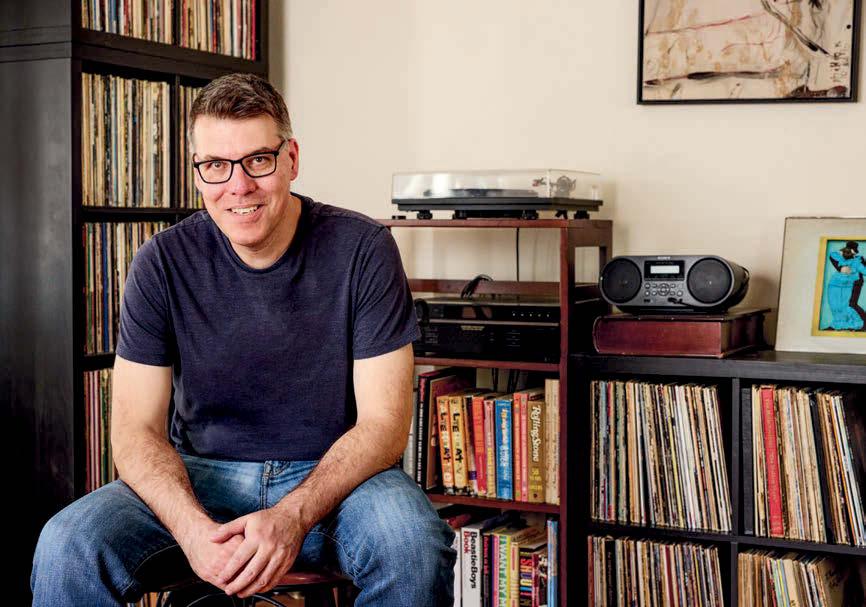
Jon Dolan ’96, music critic and reviews editor for Rolling Stone
Like many, Jon Dolan ’96 discovered “the canon of great albums” through a Rolling Stone list. “When I was 12,” he recalls, “[Rolling Stone] put out this issue on the 100 best albums from 1967 to 1987. I remember going to the record store to get one after the other, again and again.”
Dolan began his work with the publication in 2010, when he began writing
reviews on artists ranging from Steely Dan to Paramore. It was a skill he developed not only in his music-loving background, but also in his prior work with music magazines Spin and Blender “When I worked with Spin,” he says, “my office was filled with towers of CDs — I would get sent piles upon piles of them.” By parsing through countless records, he learned how to unpack the art of the album: “I try to find what’s interesting about something, why it might resonate with people, and try to lock into that rather than just writing about my favorite records,” he says. At the same time, Dolan remains honest in his criticism: “I heard this, kind of by-the-by from someone,” he says, “that I made the guy from [a redacted householdname band] cry.”
In 2018, Dolan was promoted to his current role as the reviews editor for Rolling Stone. And whether he’s assigning a batch of stories to his staff or writing his own, he continues to cover a blend of mainstream and lesser-known artists. In the past few years, he’s overseen Rolling Stone’s list of the 500 Greatest Albums (from 2020) and 500 Greatest Songs (from 2021).
Dolan attributes his ear for compelling music, in part, to a summer he spent archiving thousands of records for WRCU. “Going through all of those collections,” he says, “was a good education on how to be a dedicated, active music listener.” During a cataloging and preservation project, Dolan was part of a student team who organized and reviewed WRCU’s vinyl collections, which are still spun on-air today. “[Professor] Michael Coyle asked us to organize them,” he says, “so they wouldn’t melt in the sun. Before we intervened, the records were going to be stored in a bin outside, where construction was happening all summer. So we saved this treasured collection that had accumulated since probably the ’50s and ’60s.”
In his own collection, Dolan doesn’t care to chase rare pressings of albums, as others might. And although he describes his shelves as modest, they actually consist of approximately 1,000 vinyl records and 2,000 CDs. “It’s about having albums I love,” he says. “I want to reach into my collection and always pull out something I want to listen to.”
In the time before streaming services, physical collections were all the more important. “While planning my show with WRCU, I’d have to go to my friends’ dorms and borrow their CDs,” says Dolan. “That was part of the fun, going around like, ‘I know soand-so four dorms over has this record I want to play — I’m going to go get it.’”
As for Dolan’s taste, it cannot be confined to a particular, defining genre. “It’s astonishing, really, to see how much good music is out there,” he says. “And when you really listen, you find that artists are making great new albums all the time.”

Danny Healey ’19, in content and partnerships with Tom Brady’s media studio, Shadow Lion
During his senior year at Colgate, Danny Healey ’19 co-founded The Morning Blitz, a daily sports newsletter recapping “everything you need to know in the world of sports in five minutes or less.” Five years later, the Monday through Friday memo hasn’t missed a day — and has amassed a following of more than 50,000 readers.
From his early experiences with WRCU to his time in the sports media industry, here’s Healey’s highlight reel:
At Colgate, Healey was a member of the men’s lacrosse team known for his defense and leadership. After touring CNN studios with his coach, Matt Karweck, Healey was inspired to begin his newsletter project.
Healey’s WRCU spot was a sports talk show — Ruling on the Field — where he (a
Steve Sidman ’92, entertainment attorney with Pierson Ferdinand LLP
When Steve Sidman ’92 was a student DJ, he and Eric Breitman ’92 named their show Star Time after a box set of the funk legend James Brown’s greatest hits. “Which is ironic,” says Sidman, noting that he went on to become Brown’s day-to-day transactional attorney — a full-circle coincidence that still amuses him.
In his work with various firms, Sidman has represented many household names and brands, including Willie Nelson and the labels of Warner Music Group and Netflix. Today, his position with Pierson Ferdinand LLP stations him in Atlanta, where he’s been since earning his JD at Emory University School of Law.
“At my first job,” Sidman remembers, “I brought my little Mac-in-a-box that I bought at the Colgate Bookstore.” This first firm was where Sidman found his way: “Every so often, someone would come over and dump some work on my desk, and I would just devour it all. That’s largely how I learned.
Eventually,” he says, “I became one of them.” Sidman would remain with Greenberg Traurig LLP — a firm representing the likes of the late Jimmy Buffett and his Margaritaville empire, maestro John Williams, and Brad Paisley — for all three years of law school and 13 years after.
In his earlier experiences at Colgate, Sidman was no stranger to the music scene. Alongside his radio show, he was also a member of multiple bands, the Maroon News’ music editor and record reviewer, and the student in charge of booking campus concerts (featuring artists such as the Psychedelic Furs and Spin Doctors). It doesn’t come as a surprise, then, that Sidman stayed in the music business after his undergraduate studies.
“I enjoy being around creative types, because, in all humility, I think I relate well to them and they relate well to me,” says Sidman.
As an entertainment lawyer, Sidman’s work is exclusively transactional — it takes place outside of the courtroom. Over time, his experience with industry-specific contract agreements and intellectual property law has broadened to cover book publishing, social media, and the representation of celebrity chefs, athletes, songwriters, and producers.
Boston sports fan) and Matt Donovan ’19 (a New York sports fan) would debate and discuss sports news.
Following graduation, Healey’s success with The Morning Blitz scored him a role with ESPN, where he worked for a year in media planning.
When the sports media network TorchPro later picked up Healey’s newsletter, he took up a career as its head of content, managing a network with 30 million monthly impressions across its channels.
With TorchPro, Healey started a podcast — Pass the Torch — where he interviewed athletes such as Adam Thielen and Dana White.
Since May, Healey’s new role with Shadow Lion (Tom Brady’s creative studio) has placed him at the head of its newsletter strategy operations and original content series. “The 12-year-old Danny would be pinching himself right now,” says Healey, who has cheered for the studio’s founder since his childhood.
“Helping artists and other creative types get their projects out into the world is a professional calling for me,” says Sidman, “and the highest honor I could possibly have.”
IN HIS WORK WITH VARIOUS FIRMS, SIDMAN HAS REPRESENTED MANY HOUSEHOLD NAMES AND BRANDS, INCLUDING WILLIE NELSON AND THE LABELS OF WARNER MUSIC GROUP AND NETFLIX.
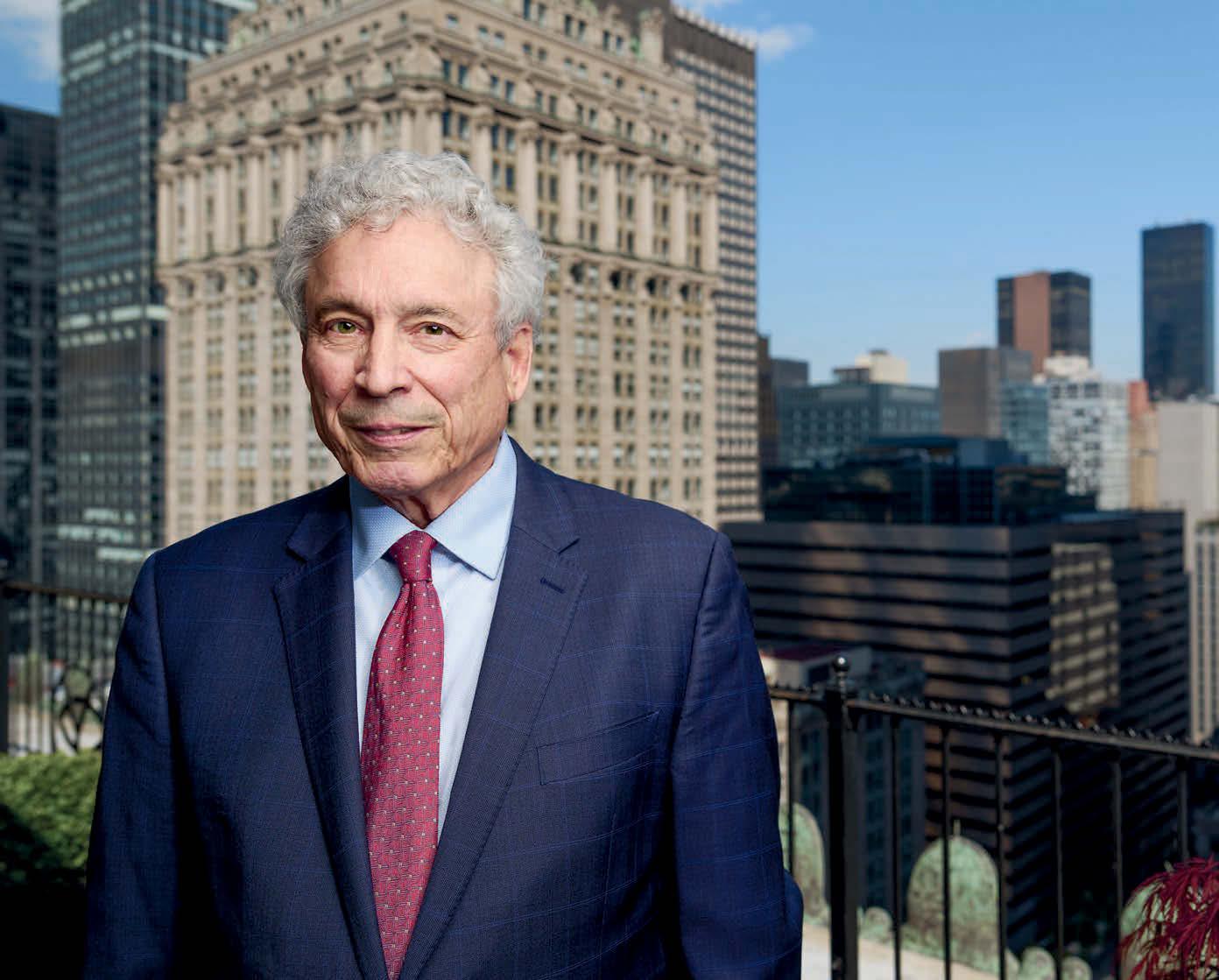
Allan Dodds Frank ’69, two-time Emmy Award–winning journalist and political correspondent
Reflecting on his time as a WRCU broadcaster, Allan Dodds Frank ’69 will always remember his last day — when he was fired by Joe Castiglione ’68 (the future voice of the Red Sox). And “he was right,” says Frank: “I was supposed to open the station as the first morning show and slept in late. Students with 8 a.m. classes had set their alarm clocks to WRCU and were depending on me to wake them up.” Since then, throughout his fruitful career as a
correspondent for ABC News, CNN, and Bloomberg, Frank has never missed a show time.
Frank’s early experiences include working as a journalist for the Anchorage Daily News (Alaska) and the Washington Star (D.C.) before he began his seven-year career with Forbes as a foreign correspondent. This title brought him to 34 countries, but one of his favorite stories took place in the U.S., when he spent a week with The Grateful Dead:
“They traveled around with a posse,” says Frank. “It smelled like patchouli oil and there were tie-dye T-shirts everywhere. I spent a day wandering around, counting how many thousands of steps I could make around the whole crowd. It turns out that the crowd they traveled around with was
the size of a medium shopping mall” — a number Frank confirmed by calling the International Council of Shopping Centers in Washington.
Frank’s knack for crunching numbers earned him recognition among the media community. After Forbes, he began to work with ABC where, in his role as an investigative correspondent, he broke a story exposing the extent to which presidential candidate Ross Perot relied on taxpayer funding to build an airport in Fort Worth, Texas. For this story and a CNN piece on the funding of the 9/11 attacks, Frank was awarded the Emmys for Outstanding Coverage of a Breaking News Story (1992) and Best Story in a Regularly Scheduled Newscast (2002), respectively.
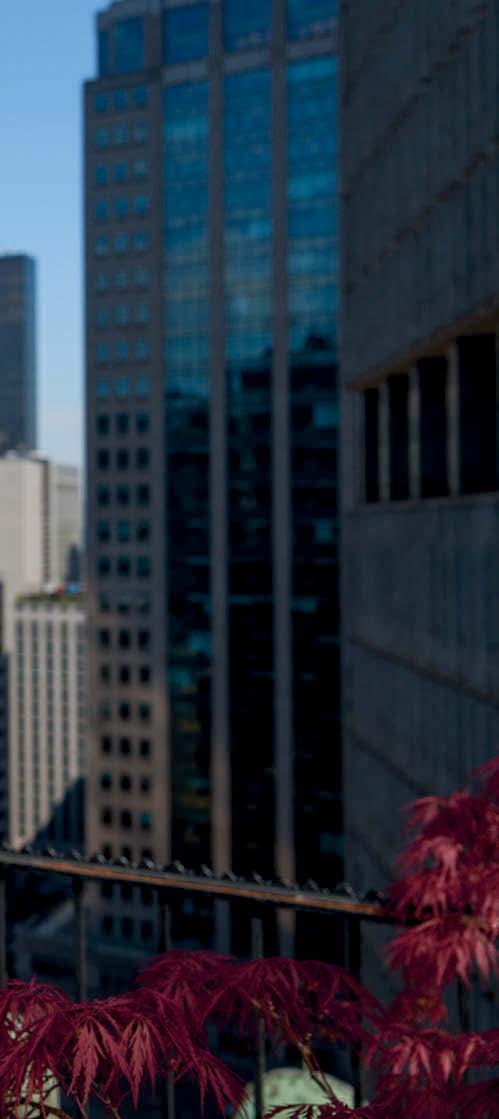
And to think — all of this started in “the little stone building that housed the WRCU studio,” which Frank compares to “a trip into a magic castle.” (This was when WRCU was located in a room in the Drake Hall tunnel, before Blackmore Media Center was built in its current location in the Coop.)
“For me and, I suspect, most of my fellow radio folks,” he says, “it was the first time I had really experienced being in an actual studio with big old microphones.”
Broadcasting in the booth, Frank says, “imparted a strange confidence in me about whether I could spread a message, whether it was news or trying to convince students to appreciate the music I liked. Having your own moment with an audience was special.”
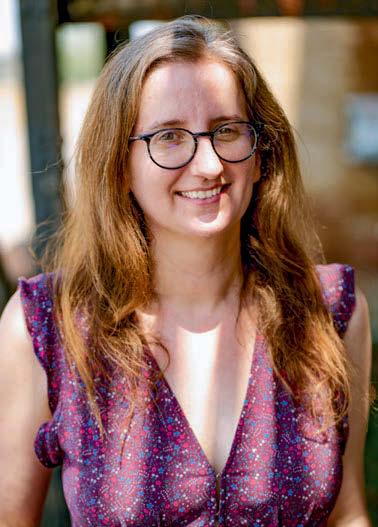
Tracy Hoole ’08, in podcast promotion and planning at Audacy Broadcasting, Inc.
Based in: Brooklyn, N.Y.
Works in: Promotion and media planning at Audacy Broadcasting, Inc., filling podcasts’ ad slots with referrals to related shows. “My job is to handle the promotional inventory for instance, when you’re listening to podcasts and you hear ads for other shows we think you might be interested in.” She had previous experience in media planning at Nickelodeon, VICE, and Sirius XM.
Get to know Hoole: “Over my career, I’ve always worked with companies that release content I enjoy. It’s important to me, especially from a marketing standpoint, to believe in the shows I’m promoting. So I’m an avid listener. I rely on podcasters to tell me stories I would have never heard otherwise.
At WRCU: “I was program director, and it helped me land an internship with Sirius XM.”
Advice for current DJs: “Learn as much from the experience as you can. Learn how to edit, and share your tastes with other students. In college radio, you have space to be as silly or serious as you want.”
Griffin McMahon ’19, in artist and label relations with Stem Disintermedia
Together in Harmony
“I work with Stem Disintermedia, an independent distribution company that provides artist and label services. We oversee release rollouts, marketing, and funding for the artists and labels who work with us. As a member of the artist relations team, I act as a kind of manager between Stem and the artists’ teams to create meaningful and fulfilling partnerships.”
“The whole ethos behind the company is to benefit the artists and their teams as much as possible, so we try to be flexible and understanding. Although Stem is a relatively young company, we’ve worked on all kinds of projects with all kinds of artists, including James Blake, Nicolas Jaar, and BADBADNOTGOOD.”
It’s Personal
“I work in the music industry because I love music and want to work with talented people. I’ve always had a very eclectic taste in music, but working in the industry has heightened my interests even more. And I think that the music should always come first — artists should be at the forefront of every decision that’s made to benefit the most from their work.”
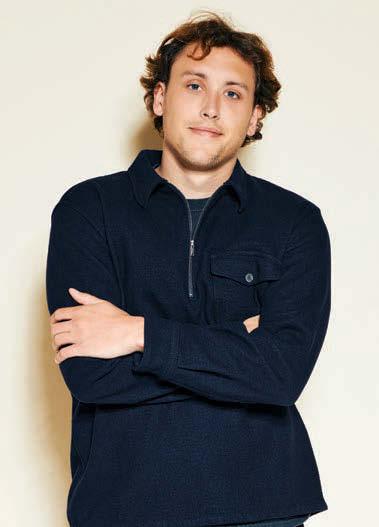
Here’s some WRCU trivia for you: Can you name the long-standing show that features a jazz-loving member of Colgate’s faculty and his partner?
If you answered Slim and Him, you’d be correct!
Many past and present WRCU DJs are familiar, at least by word of mouth, with this staple jazz hour — a music history broadcast hosted by Professor of English Michael Coyle and his partner, Kara “Slim” Rusch, since 2007. “The jazz tradition is now more than a century old,” says Coyle, who has served as WRCU’s faculty adviser since 1992. “So how do you know where to start?”
That’s where Slim and Him comes in. By planning a weekly themed show that airs on Monday evenings, Coyle and Rusch present playlists that are educational, but also playful. Topics such as jazz covers of albums by The Beatles keep the subject light while also providing an entry point into the genre. “There’s so much great music out there, and there’s so little time,” says Coyle.
Altogether, it isn’t about only reaching the jazz fans — but they’re out there, and they’ve been listening closely. “Some of our listeners are old-time jazz fans who know a lot about the genre, and they’re fun,” says Coyle. “But we never assume that our listeners know anything about jazz. You could spend your whole life exploring the genre, as Kara and I have, and not run out of new things to hear.”
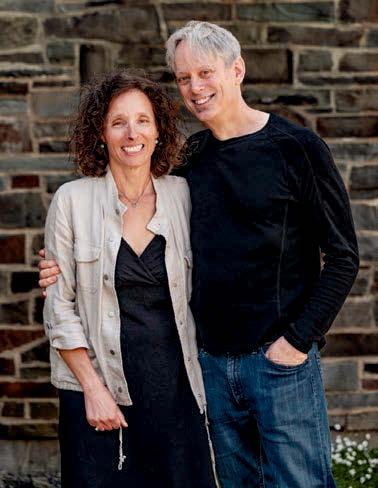
Sportelli (second from left) and other DJs provide music for Homecoming 2014.

Natalie Sportelli ’15, director at Bullish, a venture capital firm and brand consultancy
Whether it’s exemplified in her current work with Bullish or her past experience co-leading a massive broadcast fundraiser with WRCU, Natalie Sportelli ’15 has a way with numbers. Today, on behalf of Bullish, she coordinates investment and marketing
“YOU’RE
for a variety of customer-facing brands, including Harry’s and Warby Parker. Looking back at 2013, she fondly recalls kicking off the historic WRCU broadcast that raised $5.1 million in 18 hours.
After the Office of University Communications developed the idea, the program was planned in association with several WRCU alumni working in the media industry. It was broadcast locally on 90.1 FM and across the country to more than 20 alumni clubs and the broader Colgate community on Colgate Day, Dec. 13, 2013. With contributions from 5,683 donors, the funds were to be allocated to financial aid and capital expenses. “It became a big competition,” remembers Sportelli, “when an anonymous alum pledged to donate $1 million if we hit 1,300 donors.” By noon, the alum’s pledge was met.
The fundraiser featured a variety of hotly streamed shows, including:
→ An hour of Sports Talk with Joe Castiglione ’68 and Vicky Chun ’91, MA’94
→ A special episode of the Chewin’ It podcast featuring its hosts, Kevin Heffernan ’90 and Steve Lemme ’90, and special guests Jay Chandresakar ’90, Carrie Clifford ’93, and Eric Levy ’94
→ An afternoon jazz soundtrack during Slim and Him and an evening of classic rock with Professor Michael Coyle and his co-host, Kara Rusch
The marathon will be remembered as one of the greatest student-led fundraising projects in Colgate history. “And to be seen as an important partner in that fundraising process made us proud of our involvement as a student-led station,” says Sportelli.
Here’s a sampling of some current shows playing in WRCU’s state-of-the-art studio, the Blackmore Media Center:
Fools on the Hill with Kyle Born ’26, Cal Tortolani ’26, and Hayes Wilkiemeyer ’26: The trio hosts this weekend wake-up show featuring rock selections from the ’70s and ’80s, including songs by Creedence Clearwater Revival and Simon & Garfunkel.
The Put-On with Qye Woodard ’24 and Jordan Najah ’24: During this hip-hop variety hour, Woodard and Najah put you on to their favorite songs. “We try to extend to our audience an array of music that they might not otherwise hear,” says Woodard.
Musings of an NPC with Gisele Tjan ’26: Each week, Tjan picks a video game (past selections have included The Last of Us, Before Your Eyes, and Life is Strange) and either plays music from its soundtrack or songs with a similar mood.
To see the WRCU program schedule or tune in, head to wrcufm.org.
AS HE’S CODED HIMSELF INTO THE MUSIC INDUSTRY, PENNER HAS DEVELOPED HIS SKILLS FOR BUILDING APPLICATIONS AND TOOLS THAT HELP ARTISTS AND LABELS GET THEIR CONTENT TO FANS.

John Penner ’04, senior principal engineer at Sony Music Entertainment
Although John Penner ’04 is officially a senior principal engineer at Sony Music, he calls himself a “computer programming nerd” — having turned his passion for coding into a career.
In 2015 Penner started his work with Sony Music by joining The Orchard, a subsidiary specializing in independent music distribution. He transitioned into his current role in 2023, and since then, he’s worked
more directly under the parent company. Altogether, though, his work has been consistently focused on building software, whether he’s writing code or mentoring others.
“Technology teams are like one giant group project,” Penner explains. “You have to figure out how to collaborate.”
At Colgate Penner majored in computer science and minored in mathematics. Outside of the classroom, his first-year experience as a WRCU DJ would land him a position on the station’s board for the next two years, during which he served as the music director for the indie rock genre.
In this role, Penner represented the station at music conferences, including South by Southwest and CMJ. “Talking to labels, promotional companies, and artists at these conferences,” he recalls, “was a really definitive
experience — in my career with Sony Music’s team, I do this all of the time with technology vendors and partners.”
As he’s coded himself into the music industry, Penner has developed his skills for building applications and tools that help artists and labels get their content to fans, including projects to process streaming data and calculate revenue distribution.
“I find it super rewarding to build applications that help real people solve problems,” he says.
During Reunion 2024, Penner organized a WRCU alumni “radio takeover” with 10 shows, including his own hour of early 2000s throwbacks.
By Mary Donofrio
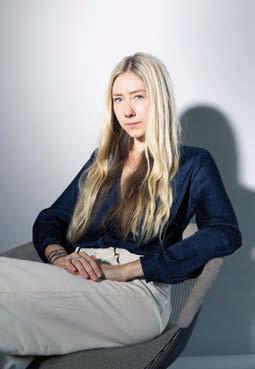
Thea Traff ’13 can easily rattle off the elements of a “good” editorial photograph. Readability, she says, is foremost.
“You have to immediately understand what you’re looking at.” Also, repeating shapes satisfy a particular itch in the human brain. Layering is important, too — drawing the viewer’s interest to both the foreground and background to make an image more dynamic.
And then there’s the light.
“You can have an amazing subject doing an amazing pose with a great expression, but if the light’s not right, it’s not going to be a good photo,” Traff says. “The light is everything.”
But, of course, there’s also something else — something that, even when all the boxes are checked, separates a nice picture from a striking piece of art. That requires skill. A good eye. Or “an understated yet sophisticated sense of nuance,” as Professor of Art and Film & Media Studies Lynn Schwarzer puts it. “Thea always had it.”
In the 11 years since graduating from Colgate with a degree in art and philosophy, Traff has emerged as a stand-out talent in the editorial photography world, making her mark as a photo editor for the New Yorker and TIME magazines, and most recently, as a freelance photographer, with her work appearing in the New York Times Magazine, the New Yorker, and Rolling Stone. Some of her
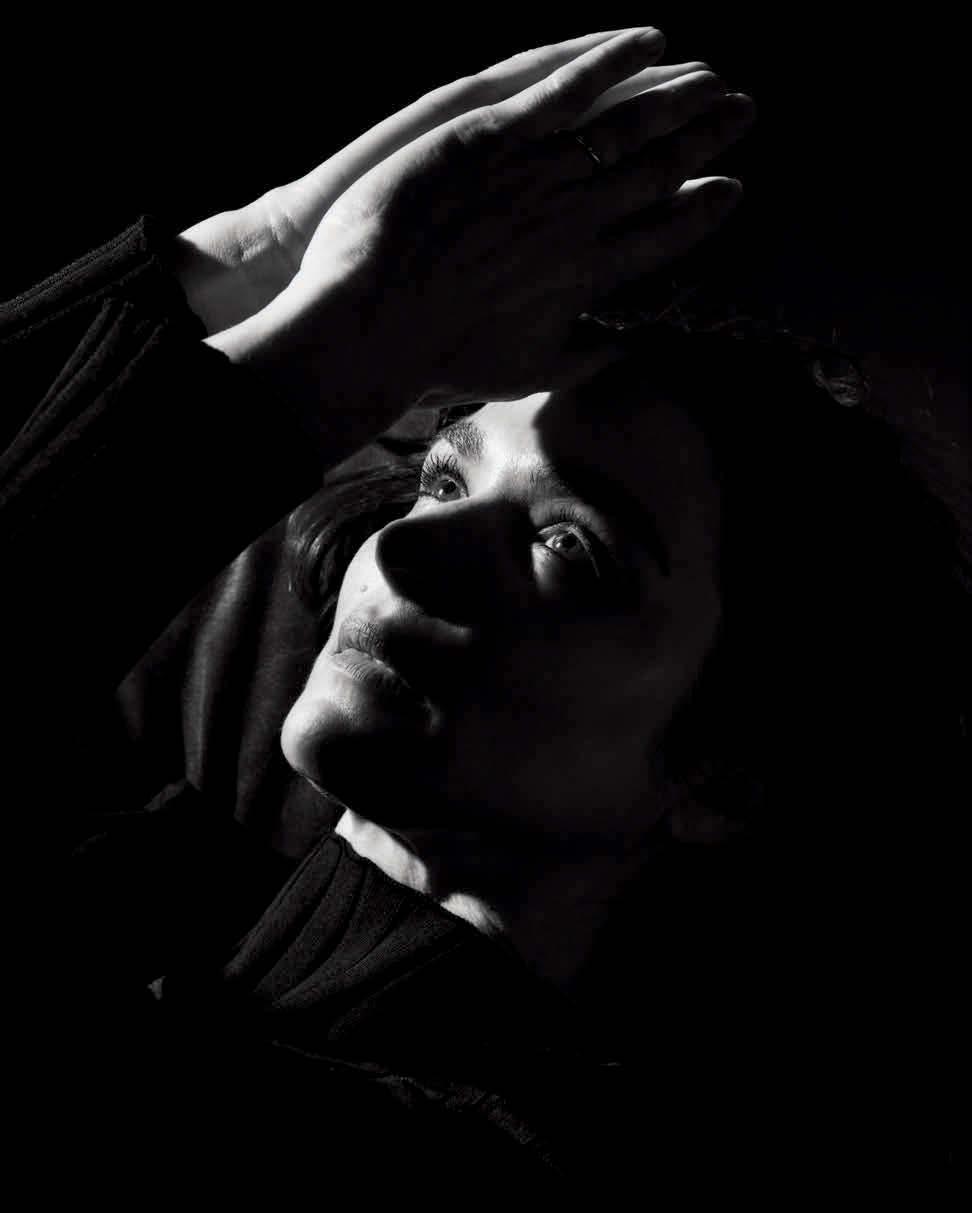

Rachel Weisz
The New York Times Magazine, April 2023
“All the stars aligned for this shoot. Rachel and her team gave me nearly three hours, which almost never happens — with some celebrities, I’ll have just two minutes. But she was so patient and trusting and open for collaboration.
“The [accompanying] New York Times Magazine article was about her TV series Dead Ringers, in which she plays twin doctors in a maternity clinic. It’s a highly sexualized show with themes around abortion, sex, and pregnancy, so for references, I pulled a lot of Renaissance paintings that use fruits to hint at sexual ideas. You can see in my work that I like to use hands. I think they’re a nice shape and can create something visually interesting. I’ll ask [subjects], ‘Is there anything with your hands that feels natural around your face?’ Rachel just got it and embraced the ideas.”

recent subjects: of-the-moment pop singer Sabrina Carpenter, fashion icon Diane von Furstenberg, and Cyndi Lauper.
A Minnetonka, Minn., native, Traff enrolled at Colgate interested in photography. Drawn to Colgate’s small-town feel — “It reminded me of home” — she found a mentor in Schwarzer and thrived within the arts curriculum, which exposed her to “sculptors, painters, and installation artists in addition to other photographers,” says Traff. “I benefited from being immersed in all these art forms and learning how they play into photography.”
At Colgate she began to find her quiet, contemplative style. Her senior project — a series of minimalist landscapes in and around Hamilton — demonstrated her “thoughtfulness and restraint,” says Schwarzer. “We talked for hours about details, like the snow and the fog in [one of her landscapes]. She went to that particular landscape again and again just to see the subtle changes in the light. ‘Well, what does it look like at 10? What does it look like at 2? What happens if the contrast is a little different? And then which one gets you to look hardest at what it is?’”
Also during her senior year, Traff signed up for Career Services’ Day in the Life program, which paired her with Christina
Cahill ’85, then a photography editor for Reportage by Getty Images. Cahill welcomed Traff into her New York City office for several days, eventually connecting the young photographer with the photography team at the New Yorker. After an interview and a review of her portfolio, the director of photography offered Traff a job as web photo editor; she started immediately after graduation.
“[Cahill] really gave me an in into the editorial world in New York and set me down this path,” says Traff. “I owe everything to her.”
As photo editor, Traff initially felt overwhelmed. “I was working for the New Yorker’s website, and for a time, I was the only person choosing the visuals for all the stories,” she recalls. “It’s a news website, so I was working seven days a week and expected to be responsive to news 24/7,” says Traff, who likens her five-year tenure at the New Yorker to “editorial photography graduate school.”
By 2018, Traff moved into a new role with TIME, as a photo editor for the print magazine and the website. There, says Traff, she further developed as a storyteller, determining how to create portraits that convey emotion in a fresh way. But all the while, Traff felt herself pulled back behind the camera.
“So often as a photo editor, I would get
shoots back and [the subjects] would have kind of a blank, thousand-yard stare,” she says. “I felt like the photographers could be pushing the boundaries a bit more.”
In 2020 she returned to making images of her own, incorporating all she’d learned at the photo editor’s desk into her approach. She also began to shoot almost exclusively in black and white — an attempt to stand out during a time when most editorial photography veers toward loud and vivid color.
“The trend of the past few years has been shooting in a kind of filmic, very colorful, little bit retro way,” she says. “I want to create images that feel timeless.”
Guided by the work of Irving Penn and Richard Avedon, Traff often asks her subjects to mimic reference images — sculptures, for instance, or photos of dancers. The idea is not to copy the reference, but to inspire that same emotion in a slight tilt of the head or hint of a smile.
“I try to evoke emotion through a gesture or a facial expression in hopes that it brings some emotion out of the viewer,” she says.
In an interview with Colgate Magazine, Traff shared the stories behind some of her favorite recent shots and the lessons she’s learned — about photography, creativity, and herself — along the way.

President Joe Biden
The New Yorker, January 2024
“I got the call about this assignment on Jan. 16 at 3 p.m., and I had to be at the White House the next day at 11 a.m. So I had no time to plan, to brainstorm, or even to organize an outfit for myself. I was told that the writer and I would get 30 minutes with [Biden] in the Oval Office. So I grabbed my suit jacket and pants that did not match, picked up my cameras and lighting equipment, and got on a train to D.C. I was actually still on the train when I learned I wouldn’t be able to use any lighting in the Oval. No flash. I don’t know if that’s because it would be too distracting to [Biden] during the interview, but I also wasn’t able to direct him or pose him in any way. So that was an unexpected challenge. When I arrived in D.C., I ordered an Instacart delivery from Lowe’s — a few pieces of fabric and a pane of glass. My thinking was that, if I can’t use a flash, sometimes shooting through objects makes an interesting effect. I’m always trying to make portraits a bit more interesting and elevate them in some way.
“In the end, I only had about 10 minutes with him, and my favorite photo was shot through that piece of glass; that little flare to the left of his body is a reflection. The New Yorker chose to run it in color, because the editors felt like a black-and-white photo would be too somber and heavy. The whole experience was a big adrenaline rush, and I was proud of the result. Sometimes when the circumstances are so limited, it takes a bit of the pressure off of me. It’s easier to know I did my best.”
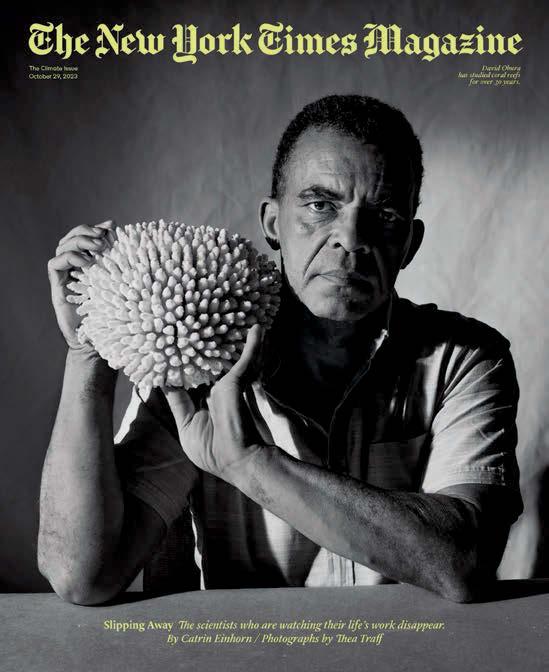
Climate Scientists
The New York Times Magazine, October 2023
“This was the biggest shoot I’ve ever done in terms of time granted and resources. The piece required a lot of solo travel — from Chile to France — to photograph scientists who are studying different aspects of the earth that are affected by climate change.
“To get the shot of [coral reef scientist] David Obura, the plan was for me to go to Kenya for 48 hours and shoot him in Mombasa, where he lives. So I packed my equipment, my whole lighting setup with my light stand and my backdrop, one change of clothes, and a lot of bug spray. I got to JFK, and I’m in the Kenya Airways check-in line, and they asked for my passport and visa. I thought, ‘Oh my God. I don’t have a visa.’ So I waited at JFK for four hours trying to see if I was going to be able to make it without the visa. That didn’t happen. I got in touch with David to tell him, and he was just incredibly patient and excited to be a part of the story. He told me that that weekend, he was going to be in Paris for a day to attend a conference.
“The idea behind the shoot was that each scientist would be holding the object of their study, and for David, that was this native piece of finger coral. He had a contact at the National Museum of Natural History in Paris, and they happened to have a piece of the coral he studies. So I got on a plane and headed to Paris. I had about 20 minutes with him at the museum, and he was really lovely and open to my references and sense of direction. We got the shot, and then he got on his train and left. That portrait ended up on the cover.”

The Rolling Stones
The New York Times, September 2023
“This was an awesome shoot and exactly what you’d expect from [the Stones]. I shot them all separately and Mick, especially, was so lovely. [He said] ‘Hi, Thea, it’s nice to meet you. I looked at your website. Would you be OK if I wore this? If not, I have a second option.’ We had our full 20 minutes, and he asked, ‘Do you feel like you got what you need?’ Just very patient and kind.”
Lily Gladstone
The New York Times Magazine, January 2024
“This shoot was for a profile of Gladstone, who had just been nominated for an Oscar for Killers of the Flower Moon. Knowing she is Native American and how much it connects to her role in the film and her work as an actress, I wanted to convey some element of nature in the shoot, even though we were in a studio. I used this metallic reflective sheet, and I pointed the light down at it so that the sheet reflected her face, like a water reflection. I cropped it and played with the light a bit in Photoshop, but I loved the result.
“Most people wouldn’t expect this, but actors can feel really awkward during photoshoots because you’re photographing them — not a character they’re playing. So I’ve found that giving them a role to play for a shoot can make them come alive a bit more in front of the camera. If I’m shooting someone and it’s pegged to an intense film that’s coming out, I’ll say, ‘I’d love to convey the intensity and the drama of the film through your expression. Is there anything you can give me in that world?’ Sometimes my ideas are shot down, and it’s taken a lot of practice to remind myself that that’s part of the process. In fact, I tell myself now, if I’m not shot down with one idea, I haven’t pushed hard enough creatively for that shoot.”
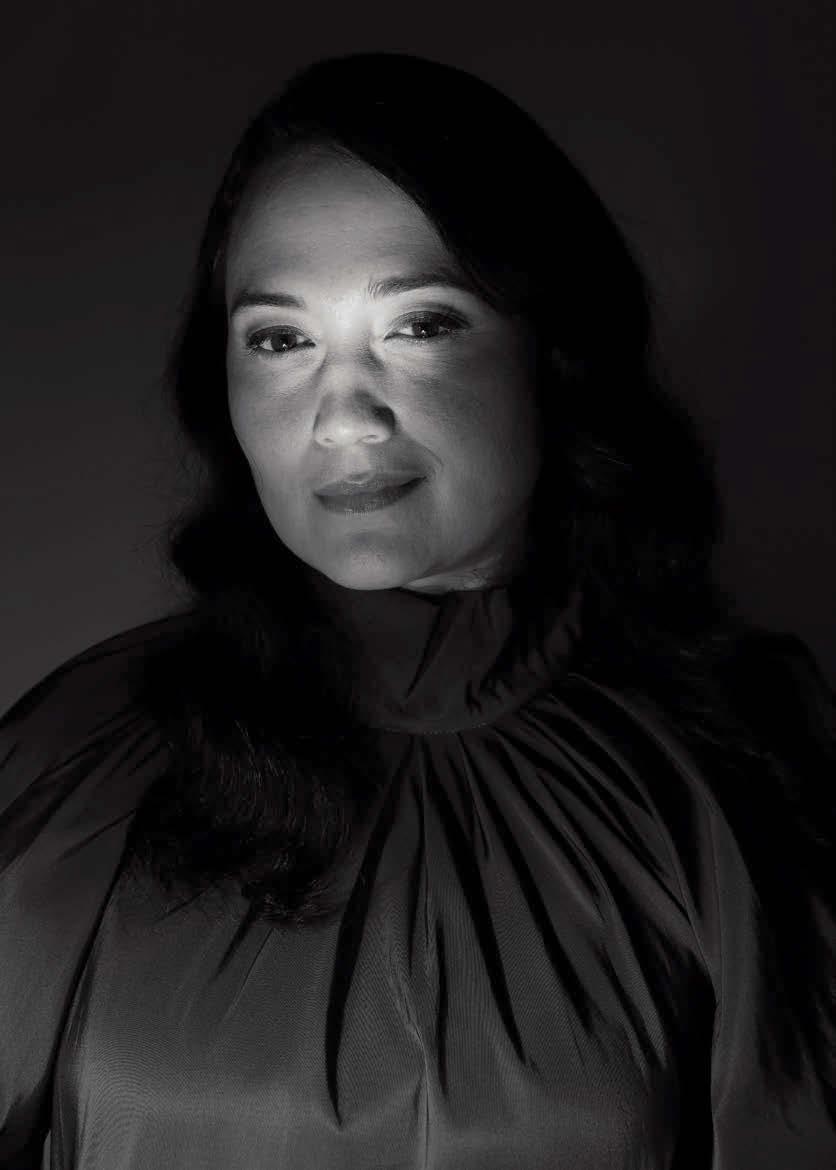

May 30–June 2, 2024
Between the revelry under the tents, the Torchlight Procession, fireworks, music, and general conviviality, reunion weekend can be a blur of activities. Here are some of the quieter moments, as well as a glimpse at how it all comes together, from setup to wind-down.
“Reunion weekend was a blast! Having the opportunity to meet the alumni was such an amazing experience.”
Zja’Kyla Brumfield ’26
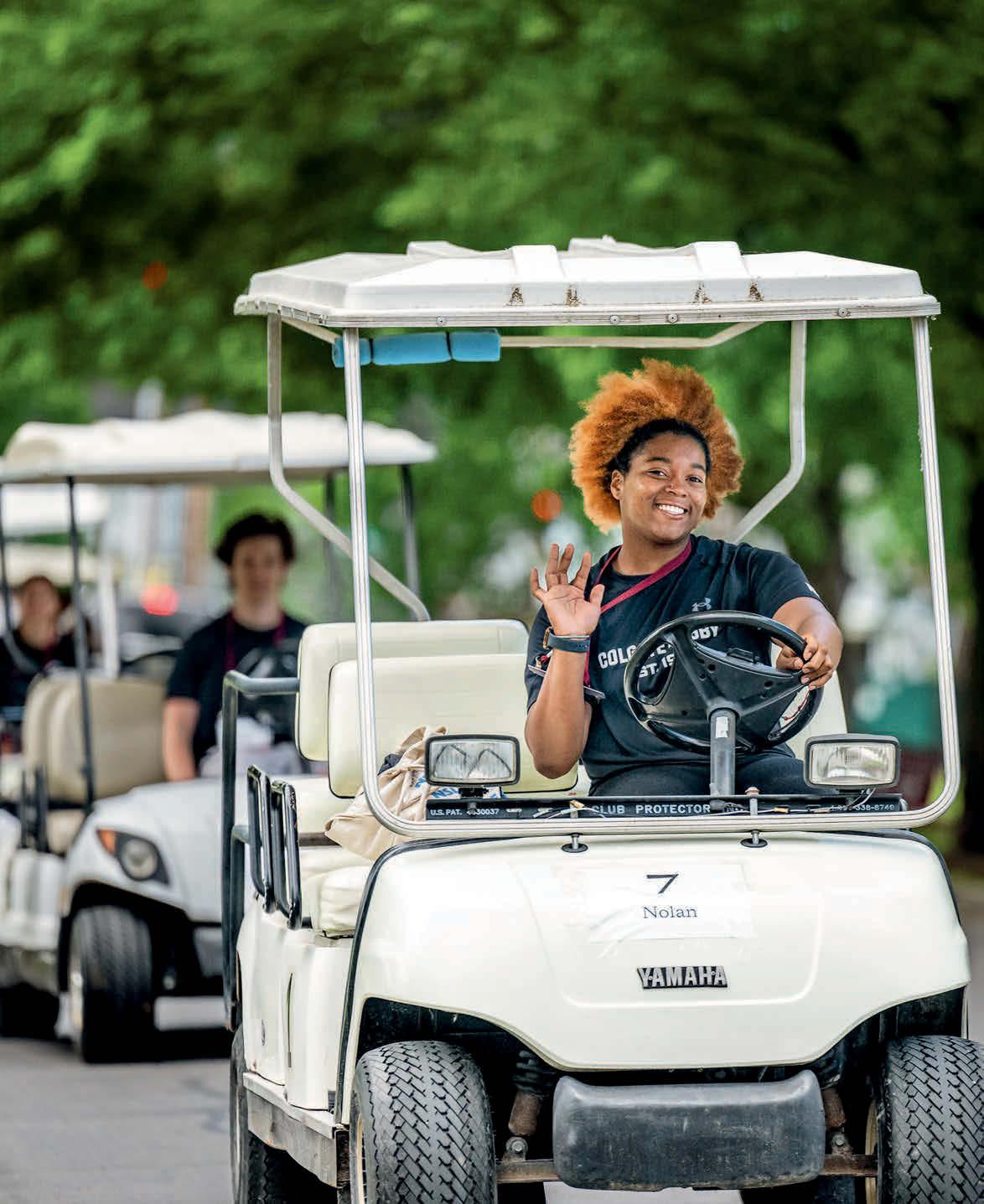

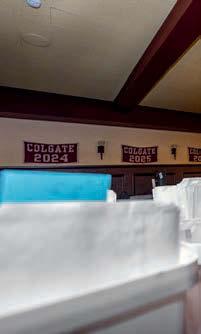


Staff members prepare for the estimated 2,100 alumni and guests returning to campus.
Clockwise from top left: 1. The welcome center in Donovan’s Pub greets guests from 8 a.m. until midnight throughout the weekend. 2. A total of 10 event tents and 8 catering/support tents staked the campus grounds. 3. The sound crew sets up for the Saturday night band, Atomic Funk. 4. In the quad before the Torchlight Procession, a buildings and grounds crew unloads the boxes of torches to be handed out at the 9 p.m. start. After the torches are distributed, the crew quickly brings the crates to the bottom of the hill, where the extinguished torches are packed up and stored until next year.
1,534
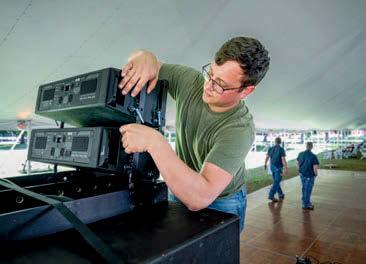

25
YEARS OF TOURS
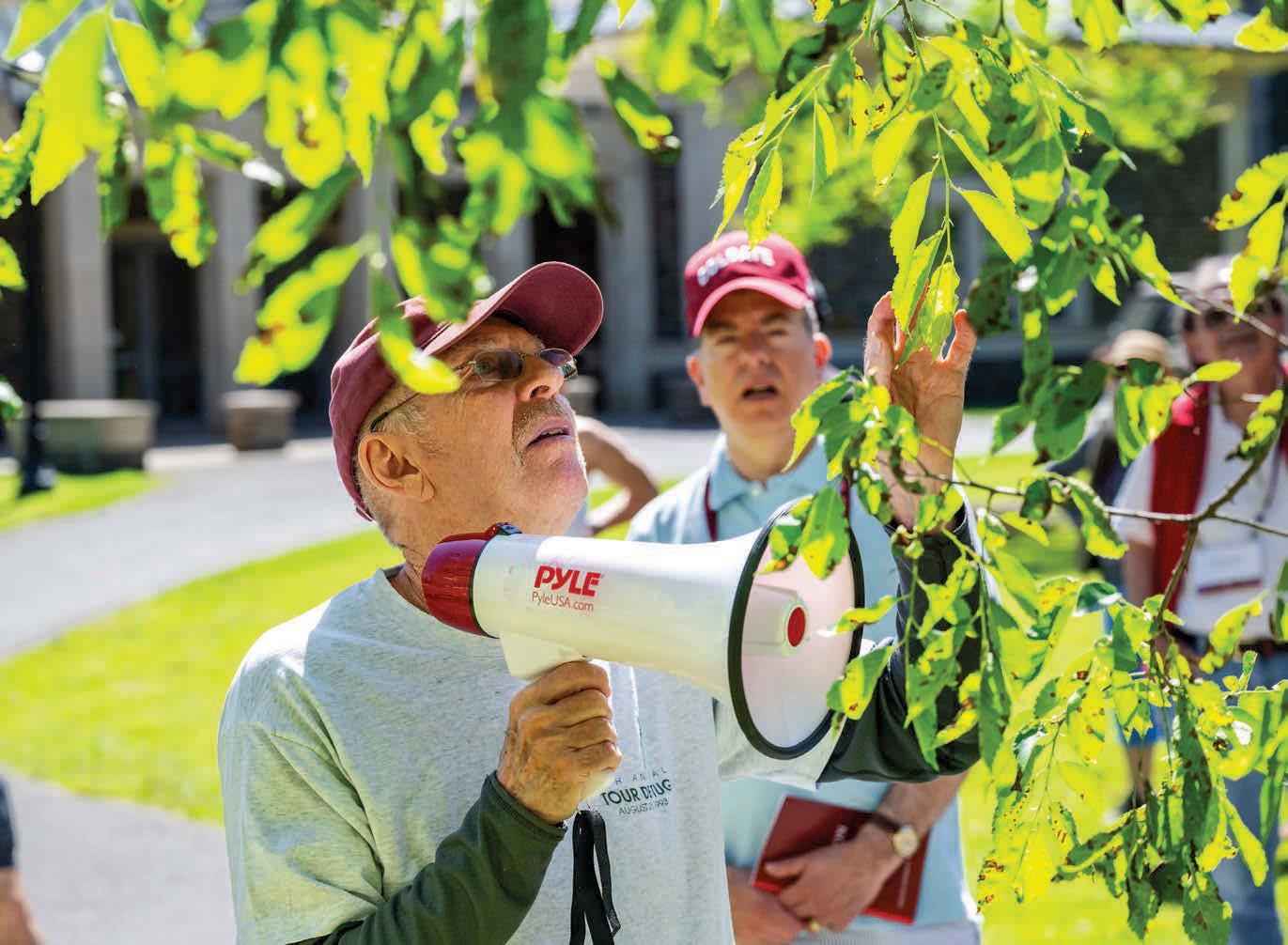
This homestead elm (one of President Brian W. Casey’s favorite type of trees) in front of McGregory Hall, with Olin Hall in the background, is a stop along Ron Hoham’s campus landscape walk. This is the 25th time Hoham, professor of biology emeritus, has given a tour of Colgate’s signature trees and perennials. The reunion tradition began with a request from his former student Beth Meer ’80, who asked him to share his knowledge for her class’ 20th. To Hoham’s surprise, 45 alumni showed up for that first tour, which was particularly memorable for the professor: “We got to the crest of the hills, formed this big circle, and we sang the Colgate alma mater. It was unbelievable.”
Ever since, Hoham’s tour has consistently drawn a large crowd of curious tree lovers. This year’s group included Hoham’s former students Zach Kaminsky ’99 and Men’s Hockey Coach Mike Harder ’97, as well as Gordon Stanley ’59, the son of Oran Stanley, who was Hoham’s predecessor in the plant sciences at Colgate.
“I never know who’s going to show up,” Hoham says.
“That’s the incredible part of this.”
9
HOURS OF RADIO PLAY
35th
ANNIVERSARY OF THE ALANA CULTURAL CENTER

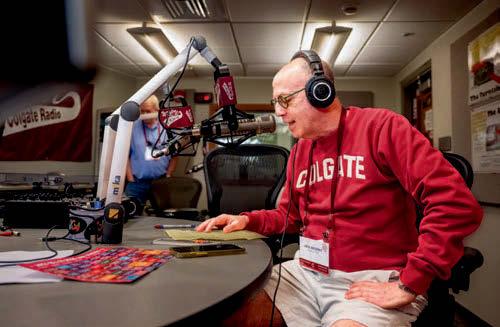
↑ Greg Brodsky ’79 was one of the WRCU alumni who DJed during the WRCU Alumni Reunion Radio Takeover. His playlist included classic rock songs from Tom Petty, Bob Dylan, ELO, Warren Zevon, and The Who.
Forits 50th, the Class of 1974 chose the theme “change.”
This reunion — just like the class members’ time as students — was distinguished by a number of firsts. For the first time, women led their class at the front of the Torchlight Procession. Also, for the Saturday class photo, there is usually a dress code of blazers and khakis, but alumni could wear what they liked. The class photo was first taken with alumnae only and then all of ’74.
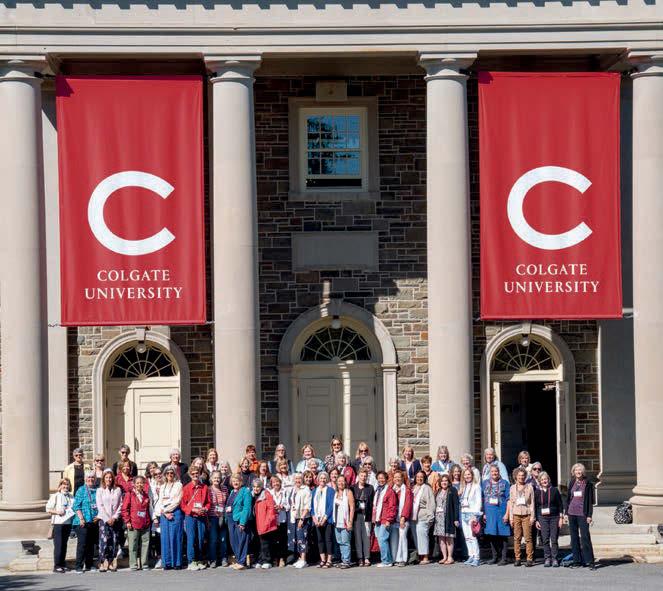
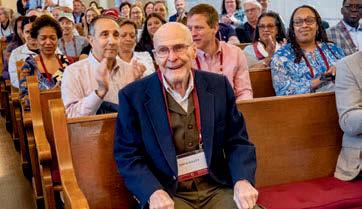
Former Colgate president Tom Bartlett H’77, GP’15, who helped usher in coeducation at the University, attended. “It was moving and deeply memorable to be with the Class of 1974 as we remembered together its pioneering role as the first class of modern Colgate, creating a coeducational college on a wonderful campus,” says the 93-year-old.
Class co-chair Diane Ciconne ’74, P’10 says: “Our 50th Reunion was spectacular, from the work our classmates did in preparation, to reunion college sessions prepared by our classmates, to dinner with President Casey, to the tree dedication by Professor Emerita Ellen Kraly, to the service of remembrance with Professor Emerita Jane Pinchin, to the attendance and remarks from President Bartlett, to seeing classmates — some of whom had not been back in 50 years.”
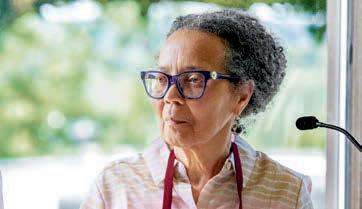

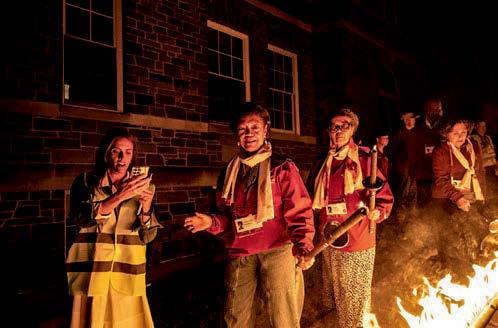
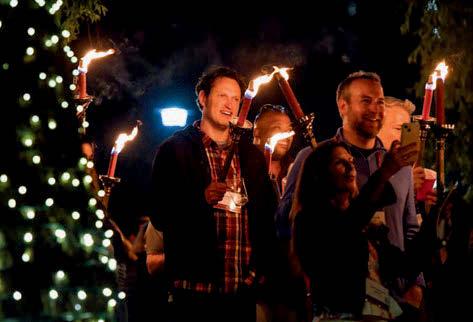

An Anniversary for A Cappella Alumnae
“Stairwell…”
“Stairwell…”
“See you in the stairwell…”
The Swinging ’Gates whisper to each other in passing when it’s time to meet on the stairs behind Donovan’s Pub for their annual stairwell sing.
“The acoustics are great, number one. Number two, it’s a circular staircase, so you can really fill it up and see one another,” explains Ellen Rosen ’84 Keller, president of the Swinging ’Gates Alumnae Association.
“You look down, you look up, and you can see the whole group in this beautiful column.”
The gathering takes place every reunion after the Friday night fireworks. This year was significant for the group, marking its 50th anniversary. Keller describes the Swinging ’Gates as “a microcosm of the strides women have taken over the last 50 years” at Colgate. “There is a deep meaningfulness to this weekend for all the women who attended,” she says, “starting with the original founders, who asked only for an opportunity because nothing existed for them.”
For the group to continue and grow throughout the years, it proves that “it clearly provides something in each of us that we need,” Keller adds. “Women fulfill a lot of roles in life but this is something we do for ourselves. Truly, when I’m with these women, I am completely and authentically myself.”
During reunion weekends, the group gathers several times, including a formal concert in Memorial Chapel on Saturday night. This year, because of the 50th anniversary of the first fully coeducational class, the Women’s Leadership Council invited some of the ’Gates to make a special appearance at its Saturday brunch. Council member Madeline Bayliss ’76 had added lyrics to the “1819” song, acknowledging the 13 women who gave $13 million to the University in 2022, and the Swinging ’Gates sang this amended version. “We were really honored [to be asked to do this] in front of this amazing group of women,” Keller says.
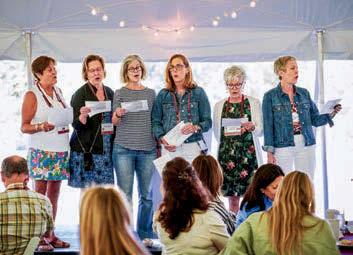
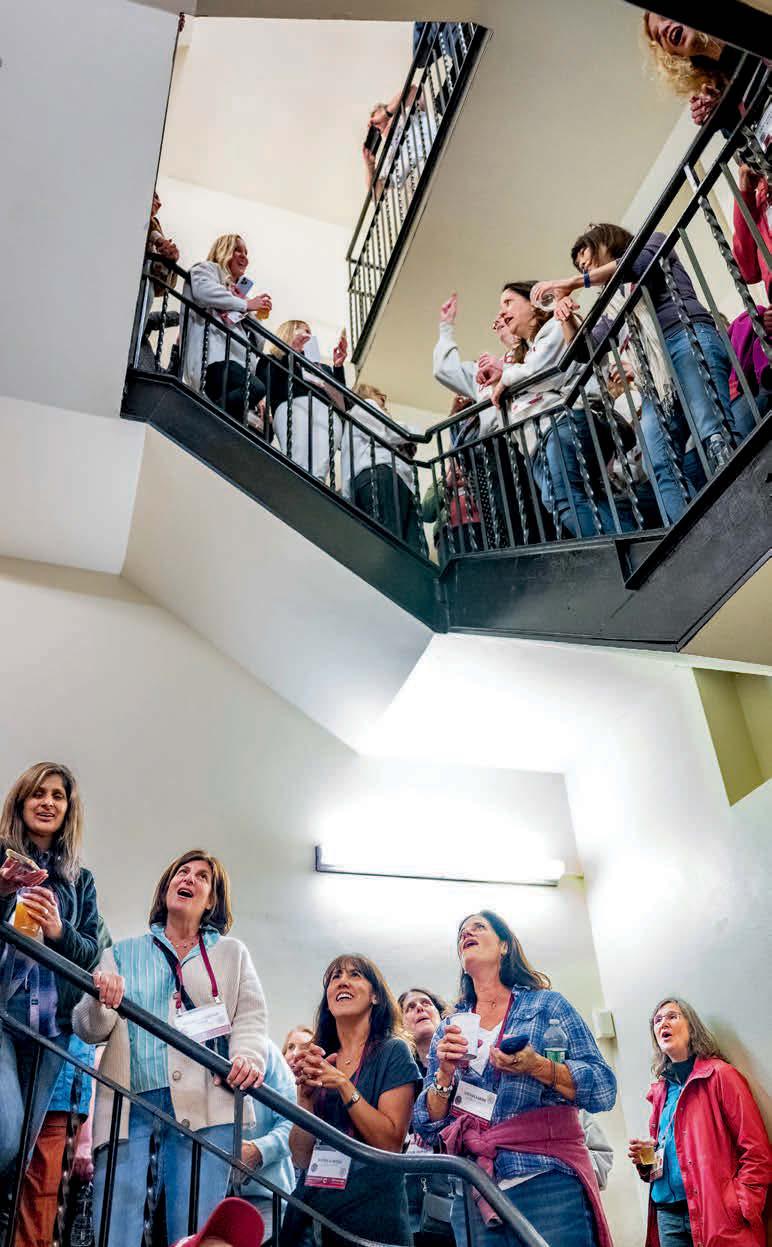
And to the 13 women who chose to be bold.
’Tis the spirit that is Colgate, a place to behold.
Excerpt from amended “1819” by Madeline Bayliss ’76
John Frazier ’93 has logged 25,000 hours of volunteer service, he estimates, ranging from documenting human rights abuses in Africa to working in refugee camps to mobilizing his students at Miami Dade College to make global change. He’s twice received the President’s Volunteer Service Award — from Obama in 2016 and from Biden in 2023 — and this year he’s Colgate’s Alumni Corporation Humanitarian Award winner.
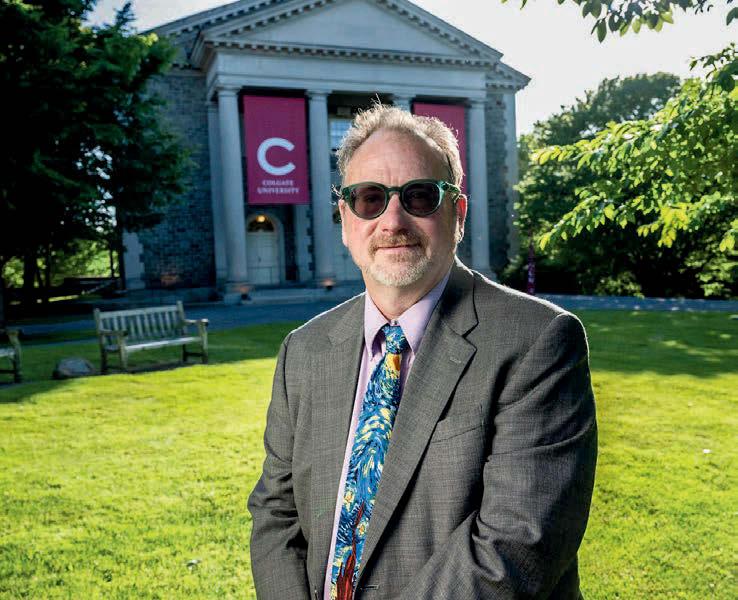
Frazier’s trajectory started with a Colgate study-abroad trip to Nigeria, which he says, “was nothing short of life changing.” He grew up in rural Ohio and it was his first time out of the country, “in this pretty challenging area,” Frazier remembers. The group arrived in Lagos to find unsafe conditions due to the military government of General Ibrahim Babangida cracking down on students and others protesting his rule. As the police were shutting down universities across the country, the Colgate students spent that first night driving 10 hours to their home university in Nsukka — which would also soon shut down.
Despite that bumpy beginning, Frazier fell in love with African culture and art, and one night he had an experience that would put him on his life’s path. With his Igbo friends, he attended his first African masquerade, which he describes as an interactive parade during which the community members danced, joked, received praise, aired and resolved their grievances publicly, and engaged with ancestors. “They used this idea of heating the world up — using a dance to activate people,” he says. “In Africa there are different words for it, but it’s an energy of action, and that could be used for positive change, to get people to do something, or to cool them down so they don’t act hastily.”
Frazier was so heated up by his experience abroad that when he returned to Colgate, he added an African studies major to his chemistry major. Also on campus, he helped expand Colgate’s Big Brothers Big Sisters chapter and co-developed (with Keith Cunningham ’93 and Jennifer Lewis ’93) an organization for scientists to have conversations about the ethical implications of their research. In his senior year, he was one of 13 who won a Konosioni award, for those most actively involved on campus.
He found support academically and personally from chemistry professor John Cochran (now deceased) and Carol Ann Lorenz, associate professor of Native American studies (now emerita) and former curator of the Longyear Museum of Anthropology.
Colgate is also where Frazier fell in love with his wife, Stacy (Taylor) ’93, when he, Cunningham, and Stacy were summer research students who house-sat for psychology professor Nick Longo. In the lab that summer, Frazier and Cochran “created a compound that had never been created before in the history of humankind,” looking at the way palladium can be used as a catalyst for cancer research.
When Disney Called
Wanting to further explore art’s power to heal, Frazier went on to graduate school to study African, Oceanic, and preColumbian art. During this time, he also started working with the United Nations and other human rights organizations. “It was happenstance because I was in Kenya learning Swahili when the genocide in Rwanda — right next door — ended in 1994,” he remembers. “I was asked if I wanted to help out with some of the human rights documentation that was taking place.” This began his work with the UN that continues to this day.
Frazier has a way of attracting the attention of important figures. In the late ’90s, he published a paper critiquing Disney’s representation of Polynesian culture — and subsequently got a call from the entertainment conglomerate. At the time, he was working at Chicago’s Field Museum as director of education for teacher and school programs, applying his knowledge of African and Oceanic art. “[Disney] flew me down and asked what I would change in the reimagining of their Polynesian Village Resort.” The company hired him as a cultural consultant, and he’s since helped to ensure accurate and sensitive depictions of non-Western cultures for Disney resorts, including Animal Kingdom Lodge, Caribbean Beach Resort, and Coronado Springs, as well as consulting on movies, including Moana and Black Panther and for other organizations, including the Louvre. Frazier never acts as the sole expert, rather he helps organizations sensitively collaborate with Indigenous experts and people on the ground. “The challenge, of course, is should a private corporation be the one that presents other people’s cultures? That’s something we’re going to have to grapple with in the future,” he says. “And in my career, that’s something I have to consider on every project.”
Motivating the Next Generation
Today, as a professor of art history at Miami Dade College, Frazier enlists his students to help further his mission. Rather than writing papers or making art just for a grade, Frazier’s students are responsible for doing a “project for world good.” They can either participate in one of the professor’s ongoing initiatives, or they can propose their own idea based on their studies. His students’ accomplishments have included selling their artwork to buy solar lamps for a village in Kenya and providing microloans to women in places like Pakistan. Frazier’s students have also helped to end the sale
This year Frazier traveled to reunion from Indonesia, where he and colleagues spent five weeks on a Fulbright-Hayes grant.

of non–fair-trade chocolate at Universal Studios and eliminated the use of Styrofoam containers on campus. “I want students to do something that’s going to impact the community, even in a small way, so they’ll learn the process and can make larger societal changes in the future,” Frazier says. “I believe that’s the basis of what a real college education is in the modern-day world.” To date, his students have raised more than $4.5 million for social causes, donated more than 75,000 community service hours, and positively impacted the lives of more than 550,000 global citizens. During summertime, Frazier spends at least a month in African refugee camps, working with the United Nations to set up education programs for elementary children and art vocational training. “The average length of stay in a refugee camp is 10 years,” he explains. “Many refugees, even after the war, want to stay in the area, with their friends and family members; they’re growing up and getting married in these camps.” Frazier has co-developed a training program to give refugees job skills so they can contribute to the economy without competing with the local people. He handles the arts and business side: “We sell the artwork they’re making on an international
market; we work with Disney, Costco, and World Market.” And to “make the program sustainable without a lot of international investment coming back into the program,” many of the refugees will return to the camp to apprentice the next generation.
This year Frazier traveled to reunion from Indonesia, where he and colleagues spent five weeks on a Fulbright-Hayes grant. The Miami Dade College faculty members collaborated with one of their global partners, Airlangga University, to see how it was incorporating AI into its curriculum. “It might be a game changer to have a number of different worldwide universities partner to figure out, how do we jointly leverage AI for student learning?” Frazier says. “Almost every university is at the same point of figuring out, how do we work with students using this new technology of generative AI?” For years, Frazier has been using a model of flipped education in which students listen to recorded lectures and do the readings outside of class so they can focus on project-based learning and discussion in class. “The faculty member becomes more of a facilitator, a guide who can collaborate with students to help them critically and ethically reflect upon how their education actually relates to the real world and our wicked problems.”
Frazier and Stacy came to reunion for their second time (they were last here for their 10-year Reunion) so he could accept the Humanitarian Award. The two spent a whirlwind day and a half on campus before leaving for a short family vacation with their two children; then he was off to consult for Disney (both in Florida and California) before heading to a refugee camp in east Africa to work for the UN. When he returns home, it will be his turn to hold down the fort while Stacy travels. She is also a changemaking professor (at Florida International University), as well as a child clinical psychologist who brings children’s mental health services to underserved populations in cities including Chicago, Miami, and LA. “Her programs are helping nearly 5 million children a year,” Frazier says. “She’s a superstar.”
On campus the couple walked down Willow Path, revisiting Taylor Lake, where they married. Part of the couple’s handwritten vows was to “make the world a better place to live in.” Their family members joked that the line was “too cheesy,” Frazier says, but “we have fulfilled that mission.” Of course, there’s always more work to be done: “We still have many years to go.”
— Aleta Mayne
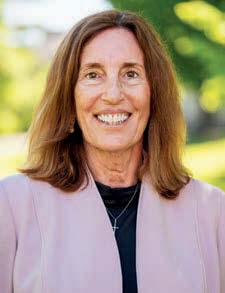
Deb (Coda) ’74
Abraham went into her 50th Reunion with the mindset that it would be like the end-of-yoga pose Savasana. “That’s when you absorb and integrate all the things that happened in that particular practice and make them part of who you are,” she says. “And I feel like at the 50-year mark, it’s time to reflect back, to think of your life, of all the elements that made you who you are and brought you to this particular moment.”
Some of the elements of Abraham’s life include:
→ Lives in: Gulfport, Fla., and Hartland, Vt.
→ Colgate major: social relations; MEd, Nazareth College; master’s in history, Tufts University; PhD ABD, Boston University
→ Was a member of the first women’s ice hockey club team at Colgate
→ Career: history professor; retired from Berklee College of Music
→ Family: husband Bob Abraham, four children, 12 grandchildren
→ At reunion: co-chaired the service committee with her former suitemate, Carol (Brown) ’74 Michael. “We organized the memorial service that remembers classmates who are no longer with us,” Abraham says. “To some extent, we tried to change the orientation of the service so it was also an opportunity for people to remember our years together at Colgate.”
→ Has attended two reunions before, and after the last, she and a few classmates decided to form a Boston Colgate women’s book club, which is still going strong. The last book they read was The Women by Kristin Hannah: “It was a perfect pick because it threw us right before reunion to a time period [the Vietnam War] just before we were at Colgate.”
→ Abraham arrived on campus a day before reunion officially kicked off so she could have time to “walk around before everyone got there and have that moment of breathing in, breathing out, and thinking about everything that’s happened.” She says: “It’s really been an amazing life and I’m grateful for it.”
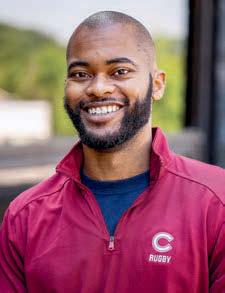
James Speight IV ’14 thinks the number of reunions he’s attended is more than the number of years he’s been an alumnus.
Speight sang with the Thirteen at the event
every year as a student and estimates he’s returned seven times since. “My favorite part is the energy of people coming together for the love of Colgate and getting to engage with alumni across class years,” he says.
→ At Colgate: political science major, writing and rhetoric minor
→ Student involvement: Thirteen, Brothers, Konosioni, Theta Chi, rugby, student government (student senator and then student policy coordinator for two years)
→ Alumni involvement: President’s Club Membership Council; Alumni Council, chair of the Diversity, Equity, and Inclusion committee and member of executive committee
→ At reunion: Led “Leadership and Storytelling for the Kitchen Table” with Rodney Agnant ’14. “Because many times, communication is where a lot of disagreement is formed, and when you’re able to have discourse and conversation with one another, you realize we’re a lot closer than we are apart.”
→ Profession: associate director, Harris Philanthropies, the family foundation of Marjorie and Josh Harris (owner of the Philadelphia 76ers, New Jersey Devils, and Washington Commanders) that partners with organizations to enable opportunities for at-risk youth, health initiatives, and community growth. “I interact and engage with a lot of different people,” Speight says. “When it comes to philanthropy, it is important to be able to understand varying viewpoints and different experiences.”
→ Something he’s most proud of in his career: When the pandemic began, Speight was working for Robin Hood (NYC’s largest poverty-fighting organization), and he played a role in the strategic development of its pandemic relief fund. “It felt very empowering to be on the side of providing
millions of dollars to New Yorkers.”
→ Lives in: Stamford, Conn.
→ Last featured in Colgate Magazine: as part of the Love Story series, with his wife, Abby ’15 (and a mention of their dog Willow, named after Willow Path)
→ On winning the Ann Yao ’80 Young Alumni Award at reunion in 2019: “Colgate gave so much to me, and I wanted to be a really involved alum as soon as I graduated. To be recognized and honored for my contributions in the first five years meant a lot. It also served as a catalyst to remain involved and helped lead me to the Alumni Council. For me, it was encouragement — ‘People are recognizing the work that you’re doing and keep it up,’ which I did.”
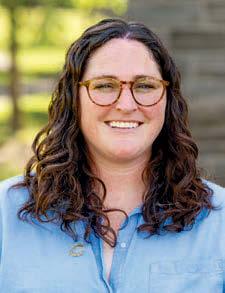
A veteran Reunion College presenter, Mari Jones ’09 has cracked the code for ensuring a lively, wellattended session: Just add wine.
On Saturday of reunion weekend, Jones, president of Emeritus Vineyards in Sebastopol, Calif., walked alumni and friends through five unique Pinot Noirs in a guided tasting experience in Benton Hall — her third such presentation since 2012, when she began working at the winery founded by her father. “I love doing these sessions because [alumni] are always very knowledgeable and curious, and they ask great questions,” she says. “This is a group that appreciates wine.”
→ At Colgate: majored in philosophy and religion
→ Alumni involvement: Jones joined Colgate’s Alumni Council in 2022 and is a member of the Women’s Leadership Council and the President’s Circle. She was honored with a Maroon Citation at this year’s Alumni Council Awards.
→ Finding her passion: At age 12, Jones accompanied her father on a business trip to Burgundy, France, where she first sampled and “fell in love with” Pinot Noir. “It wasn’t just the taste that I loved, but the history. In the cellars, you can see the roots
from the vines above, and during the French Revolution, soldiers would hide there,” she explains. “The way wine connects across time and tells a story — that just blew my little 12-year-old mind.”
→ Rising star: Jones is active in the wine community, serving on the board of directors for the Russian River Valley Winegrowers and Russian River Valley Pinot Forum and working with the Sonoma County Vintners International Committee to promote Sonoma County wines internationally. In 2022 she was named one of the “40 Under 40” by the North Bay Business Journal.
→ Special delivery: Jones’ father and Emeritus’ founder, Brice Cutrer-Jones, shipped “care packages” with bottles of his daughter’s favorite rosé to campus during her undergraduate years. “I was a big hit with my roommates when I’d come back from the mailroom with that 40-pound box,” she says.
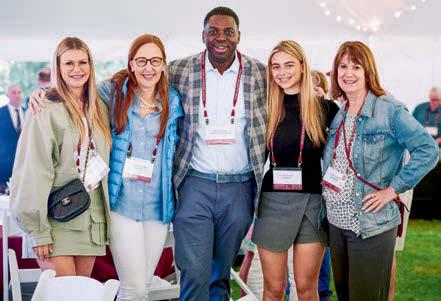
This annual weekend is produced by Advancement, in close collaboration with campus partners.
For more scenes from Reunion 2024, visit colgate.edu/magazine.
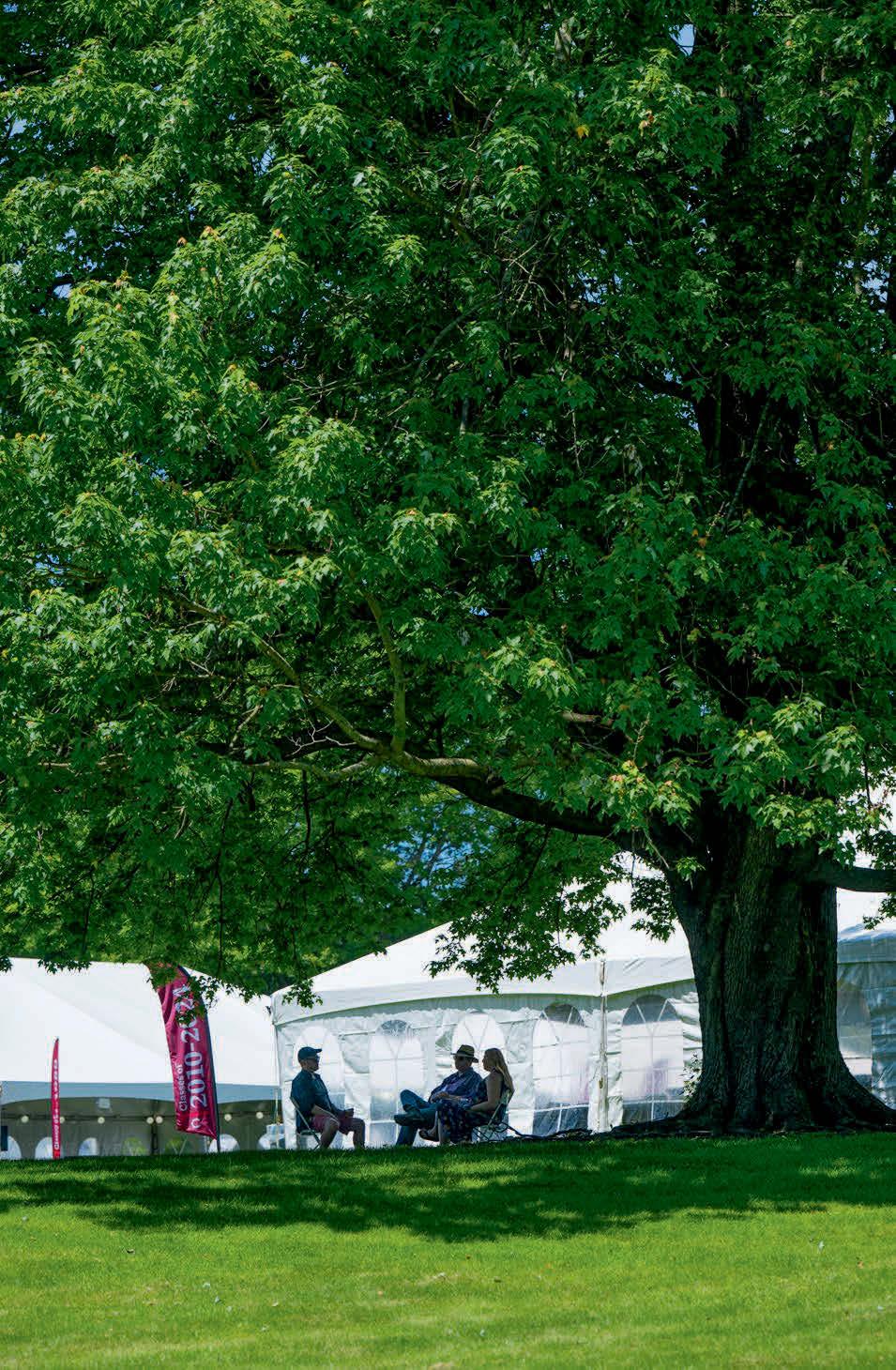
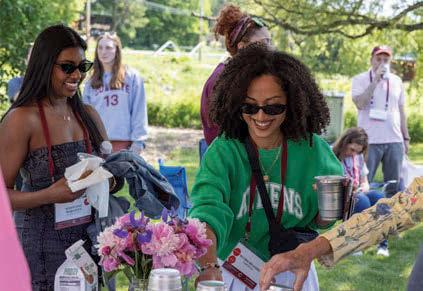
“My favorite part [of reunion] is the energy of people coming together for the love of Colgate and getting to engage with alumni across class years.”
James Speight IV ’14

world, and it’s been guided by the imaginative vision of its Chief Creative Officer Bruce Vaughn ’88.
Vaughn is the first to admit that his path to helming the creative output of Disney Imagineering was unconventional — and, in many respects, unlikely. Hailing from a family of lawyers with a strong Colgate legacy, Vaughn seemed destined for a legal career when he graduated with a degree in English literature. But this meant turning his back

As chief creative officer at Walt Disney Imagineering, Bruce Vaughn ’88 has had a hand in developing some of the parks’ most popular rides and attractions.
Every year, tens of millions of people around the world visit a Disney theme park, where they are swept into immersive experiences populated with beloved characters from their favorite television shows and films. From classic rides like Space Mountain to newer offerings like Star Wars: Galaxy’s Edge, there is an overwhelming
sensation of magic at work in all things Disney.
But peek behind the curtains and you won’t find magicians. Instead, you’ll find the team at Walt Disney Imagineering — the storytellers, engineers, artists, and scientists who are the creative force behind Disney’s most popular rides and attractions. It’s one of the most sophisticated R&D firms in the
on his true passion — filmmaking — which he had cultivated as a child growing up on a steady diet of Indiana Jones and Star Wars films.
“These films blew my mind, but I wasn’t obsessed with the characters like my friends were,” Vaughn says. “I was obsessed with George Lucas and Steven Spielberg. So I got an American Cinematographer magazine and started reading everything I could about these people who were making movies.”
After graduation, Vaughn spent a summer cleaning pools near his home in Sag Harbor, N.Y., biding his time until he could apply to law school, when he learned that a film crew was shooting Star Trek V at a set nearby. Vaughn’s father had a client who knew Bran Ferren, a renowned creative technologist
who was running special effects for the production, and Vaughn’s dad arranged for his son to tour the set with the production’s general manager. It was only two weeks later when Vaughn received a phone call telling him he was hired — that he realized that his visit hadn’t been a tour, but a job interview. “That was the only job interview I’ve ever done in my life and I didn’t even know it,” Vaughn recalls with a laugh.
Vaughn’s first job in filmmaking wasn’t glamorous — he was a truck driver for the Star Trek production — but during the long nights on set he befriended one of the cameramen who taught him how to operate a camera after his shifts. It turned out to be a serendipitous apprenticeship. When another cameraman on the production had to make an emergency flight out to California, Vaughn’s mentor roped him in as a stand-in cameraman. Overnight, Vaughn found himself working side by side with the film’s director of photography.
After the film wrapped, Vaughn briefly attended law school before realizing the legal profession wasn’t for him. He dropped out and contacted Ferren about getting back into the film business. Ferren took Vaughn under his wing at his firm.
“Bran is a true Renaissance man and he made me his righthand person, so I jumped into career development instantly,” says Vaughn.
Ferren’s talents and Vaughn’s hunger to learn the film business paid off, and before long the firm was hired as a consultant at Imagineering. At Disney Vaughn had the chance to flex both his imagination and project management skills, starting as a writer and climbing the ranks until he was the director of the R&D group, overseeing a team of engineers pioneering robotics and other technology used in attractions. His leadership skills propelled him to chief creative officer, succeeding the legendary Marty Sklar, who had helmed Imagineering for decades (a role he inherited from Walt Disney himself).
During his tenure as chief creative officer, Vaughn has helped craft several of Disney’s immersive experiences such as Zootopia at Shanghai Disney Resort and the World of Frozen at Hong Kong Disneyland.
After more than 25 years at Imagineering, Vaughn says he’s still impressed by the creativity and raw intellectual horsepower of his colleagues. He compares his job to that of a jazz musician, which calls for constant improvisation and collaboration. “This is truly a collaborative business; there’s no going solo,” Vaughn says. “We’re very dynamic, and we’re open 24/7, 365 days a year, around the world. I find myself wired for that.”
— Daniel Oberhaus
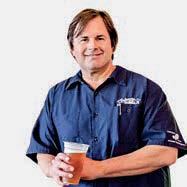
It’s never been Andrew Balmuth’s goal to change Japanese beer culture. Instead, the Class of ’89 grad hopes to bring a taste of America to Japan.
The Hamilton native (and youngest child of legendary Colgate philosophy professor Jerome Balmuth) moved to Japan in early 2004, inspired by both a family trip to Kyoto during his father’s sabbatical in the early 1970s and by the 1998 Nagano Winter Olympics.
“[On TV] I saw the snow monkeys, the ice rinks, the golf courses, the hot springs, and how beautiful it was,” he says. “So I packed up my hockey bag and golf clubs and flew to Nagano.”
Balmuth, who had worked in estate planning and insurance, lived briefly in Nagano before relocating to Tokyo, where the “lifelong beer lover” was surprised by the limited variety of craft beers available in the city, especially his American favorites like Stone and Sierra Nevada Brewing.
“Restaurants and retail stores offered only Japanese pilsner or lager styles, and I could usually find Budweiser, but nothing else from the USA. So, as an entrepreneur, I was looking for opportunities, and I hit upon the idea that I would introduce American craft beer to the Japanese market,” he says.
With help from his wife and business partner, Akemi (who was also in the beer business — they met on a train ride to a beverage trade show), they established Nagano Trading Co., Ltd in 2006. The company has since grown to become Japan’s largest importer and distributor of American craft beer, offering more than 200 varieties. In 2013 the Balmuths opened Antenna America, a bottle shop and tasting room designed to give both wholesale and retail customers the American craft beer experience. Today Antenna America operates three popular locations in major Japanese train stations and has expanded its offerings to include traditional American fare — Buffalo chicken wings, Baja fish tacos, and housemade jalapeno poppers, to name a few.
Colgate Magazine spoke with Balmuth to learn more about Japanese beer culture and how he’s creating an “authentically American experience” for customers from all backgrounds.
“In Japan, beer is celebrated as an afterwork, kind of starting drink. Over the course of an evening, most people switch from beer to sake, and maybe whiskey at the end. So there isn’t a culture of just drinking beer all night, and it’s not something you pair with a meal. That’s traditionally been sake. Craft beer is growing in popularity, though. Japanese brewers are winning international medals for styles like IPAs, and you can now find restaurants that only serve Japanese craft beers — so maybe American craft beer has been an influence.”
“Most of the beer produced by the major breweries in Japan is lager and pilsner style, and the recipes are more European by design really high-quality ingredients, really fresh and crisp. So when we brought in American IPAs, which can be very bitter and have the aroma of grapefruit and hops, people are blown away, like ‘Whoa, this is beer?’ But the Japanese palate is actually well suited to those bitter flavors and aromatics.”
“At Colgate, my beer of choice was probably Utica Club and Saranac. But the beer that defined my interest in craft beer is Sierra Nevada’s Pale Ale. It’s really the benchmark beer; it’s that balance between the malt and the classic hoppy bitterness. It’s timeless in the sense that I think there are customers who will like that beer forever. IPAs, hazy IPAs, or something super sour or barrel aged and high alcohol; those come in and out of favor. But that particular pale ale will always be relevant to beer lovers.”
“The yen is falling against the U.S. dollar, which makes travel from Japan to America even more expensive. So I think of that as another benefit of a place like ours, where we’re introducing American culture in an experience that is real and authentically American. Our chicken wings are brined, smoked, and fried. Our burgers are amazing. We take really good care in making those items American style — things like importing the cheese, the mustard, the hot sauces, and the wood products that we smoke on. Those things all add up to a real American experience, and that’s what we’re going for — pairing the fresh American beer with a real American experience in Japan.”
— Mary Donofrio
For one day only, Lara Donahue ’14 puts on an enigmatic off-Broadway hit.


Lara Donahue ’14 would love to tell you about the play she recently produced. But per the contract, she can’t share much.
The show, White Rabbit Red Rabbit, requires no director, no rehearsals, and no set. Even the show’s sole actor is in the dark until the moment the play begins and, for the first time, she opens a sealed envelope containing the script.
Written by Nassim Soleimanpour, White Rabbit Red Rabbit is inspired by the Iranian playwright’s experience in his home country after refusing military service. Since debuting in Edinburgh, Scotland, in 2011, the play has been performed globally more than 3,000 times and translated into more than 30 languages. Dozens of big-name actors — Whoopi Goldberg, Nathan Lane, John Hurt, and Cynthia Nixon among them have taken on the lead (only) role. And while the script remains the same for each performance, actors are free to insert their own extemporaneous riffs and banter with the audience throughout.
Donahue, who lives in New York City and works as vice president of business management for LPL Financial, was first introduced to White Rabbit Red Rabbit as a spectator at an off-Broadway performance in 2016. She was enthralled, but hadn’t given it much more thought until 2023, when she received an email from the play’s creative
licensing agency. The company, Aurora Nova, was reaching out to everyone who had seen the show in New York with an intriguing offer: free access to White Rabbit Red Rabbit’s creative license for one day only — on March 13, 2023, in commemoration of the day COVID-19 shut down Broadway in 2020.
Of course, there were stipulations in place to maintain the play’s secrecy: no marketing, no video or audio recording, no social media chatter whatsoever. Producers can’t charge for tickets, in an effort to make the performance accessible to all. Donahue, who has always loved theater but had no real theater experience, was game — and felt a serendipitous Colgate connection with the date.
“Seeing that it had to be performed on the 13th just gave me chills,” she says. “To me, that was a sign.”
She began by casting her actor, reaching out to a cousin in Georgia with a background in theater. After securing a venue (a friend’s apartment) and an audience (about 15 friends open to this “looney tunes idea,” says Donahue), the performance was a success.
The next year, with the creative agency’s free-license offer reinstated for March 13, 2024, Donahue knew she wanted to produce the show again — this time on a slightly bigger scale in celebration of an even more Colgate-friendly milestone: the 13th anniversary of the White Rabbit Red Rabbit’s off-Broadway premiere.
With help from well-connected theater friends, she enlisted accomplished indie film
Seeing that it had to be performed on the 13th just gave me chills.
actor Terra Layne and found a new “stage” in another friend’s Harlem townhouse.
On March 13, 2024, approximately 40 people — including a handful of Colgate alumni — attended the performance and joined the growing cadre of theatergoers who have remained impressively tightlipped about the show’s plot.
“It’s really cool because once you see it, you become a member of this community,” says Donahue, who explains how just taking in the performance with a group is an unexpected bonding experience. “By the end of the show, it’s like we’ve all taken this roller-coaster ride together.”
— Mary Donofrio
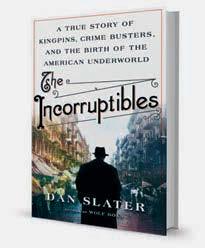
Dan Slater ’00 discusses his new nonfiction book, The Incorruptibles: A True Story of Kingpins, Crime Busters, and the Birth of the American Underworld
The Incorruptibles is about the underworld of the Lower East Side, prior to World War I, during the big immigration of Eastern European Jewish refugees. The Lower East Side ghetto was the most densely packed area in the world. As such, there was a lot of crime there and a lot of vice. There was prostitution, drugs, and there were gangs who specialized in all sorts of things you wouldn’t even imagine — like poisoning horses. Meanwhile, there were these wealthy Jewish people who lived in mansions uptown. These were the German Jews, and they had come from a more acculturated environment in Western Europe. One of those families owned the New York Times; another owned Macy’s. They were looking downtown at these new arrivals whom they were related to through ethnicity and religion, if nothing else, and it was sort of embarrassing that there was all this crime. By the end of the first decade of the 1900s, they decided to do something about it.

The hero is a young man from the Lower East Side who had been raised among the underworld; a lot of his friends had been lured into it. His name was Abe Shoenfeld. He was from a family of reformers, and [the uptowners] hired him to lead a war on crime. He had some success, so the mayor of the city said, I want to put him on the NYPD, History
give him a squad, and he can go around the neighborhood — and eventually the whole city — to shut down brothels, casinos, the drug trade, and gang activity. It was kind of an unlikely plan. How could one kid, even with a bunch of cops behind him, do this?
Even though I was covering a story that was more than a century old, it was the perfect time to do it. Several unpublished memoirs, including one by the main character, had recently become available in public archives. I could also look at hundreds of oral histories and thousands of trial transcripts from the criminal court in Lower Manhattan. Many of those trials related to the story I was telling in the book. Also, a photography archive from an old photo news service in Manhattan came up for sale. This archive contained tens of thousands of images that had been sitting in storage for more than a century. While I was working on The Incorruptibles, the descendants of the owners of the news service sold the archive to an auction house, which in turn sold the individual images on eBay. I got really lucky. As I’m working on this book, all these photos of the time period — in some instances, the characters and places I’m talking about — became available. Taken together, all of these sources enabled me to bring the narrative alive in the vivid and richly detailed way I want to be telling stories.
The idea came from working on a different project. In 2019, I published crime story set in the contemporary Orthodox Jewish community in New York. That titled “Undercover in the Orthodox Underworld,” is about a gang of rabbis who’d been going around assaulting husbands in the community refused to give their wives religious divorces. For decades, these rabbis operated with impunity, until agent, with a speciality in undercover work, got wind of it. That story got me researching the subject of Jewish violence, and in my reading I kept returning to New York prior to World War I. In these books, a secretive and wide-ranging war on crime was often mentioned off to the side, as a footnote, but it was intriguing, so that was the thread I pursued for six years.
only association would’ve been Jewish. I did not know that the word “ghetto” originated in Venice in the 1500s, when Jewish refugees who fled to that city were allowed to stay, but were forced to live on a gated island. That island had once housed a copper foundry, or ghetto, from the Italian verb gettare, meaning to pour, cast, or throw. Today, that history is lost, but the spirit of the ghetto, as a place where the marginalized reside, lives on. Though the associations now are almost exclusively
Black and brown, maybe Native American too, the ideas are the same. It’s about racism and bigotry, and about anti-vice laws being used as a way to control the oppressed.
Another crazy coincidence about this book, and I don’t want to give any spoilers, is that in the course of researching The Incorruptibles, I stumbled upon my own ancestors. They turned out to be tangentially related to this war on crime that is the narrative spine of the book.














I did not know before I started working on this book that prior to 1945, if you said the word “ghetto,” the



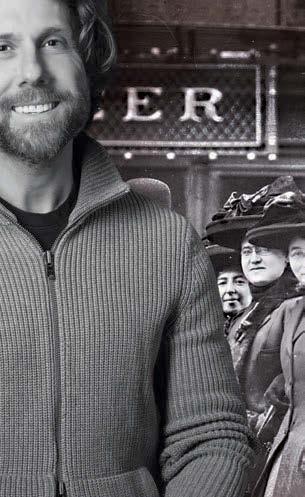


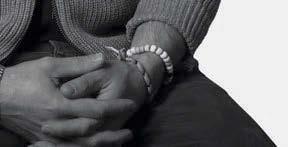
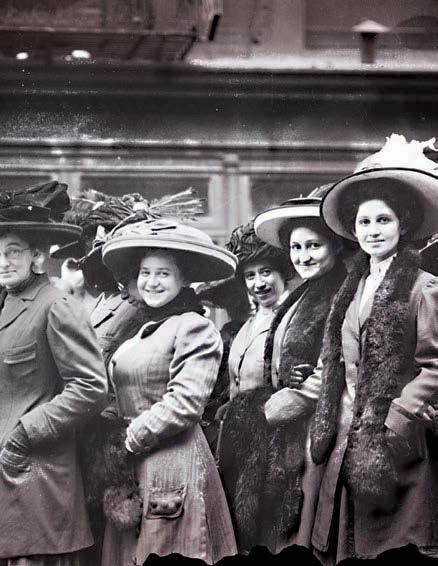
By Malachy Duffy ’74
With the opening of the Dana Arts Center in 1966, Colgate finally had a much-needed home for theater performances. However, those in charge of University Theater determined what was presented on the Brehmer Theater stage and did not think musicals warranted serious attention.
In the fall of 1973, a group of us from The Colgate Thirteen decided it was time to break the mold: We would put on a musical for our 1974 January Plan. [For those who are

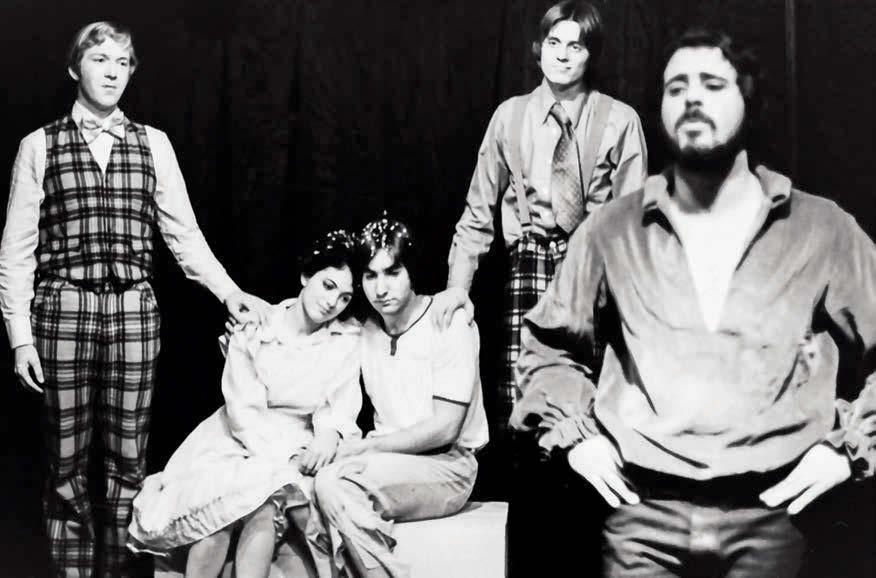
unfamiliar with “Jan Plan,” during January, there were no classes, so students had the opportunity to work on a special, monthlong project.] Knowing time and resources would be limited, we chose the elegantly and elementally simple
The Fantasticks, an eternal tale of children, parents, and coming of age — then and still the record holder for the longest-running musical in the world.
We needed a sponsor, but the head of University Theater was unwilling. Luckily, music professor Dexter Morrill ’60 agreed to sign off on the project. Needing a venue, we approached University Chaplain R.V. Smith to ask if we could use The Agora, a gathering place in the basement of the chapel. With relatively low ceilings, no lighting equipment, and no stage — well, Broadway it wasn’t. He readily agreed.
As soon as we returned to campus in January after winter break, we scrambled to create a performance space. Ned Hitchcock, the designer for the University Theater, gave us a spare platform and a couple of poles we could use for lights and to hang the minimal scenery: the opening drape with The Fantasticks emblazoned on it; a cardboard circle, one side painted with a quarter moon, the other with a bright yellow sun; a bench; and a chair.
The company was made up of: Clint Clifford ’74 as The Narrator; Daniel Mason ’75 as The Boy; Gay Gordon ’76 as The Girl; Bruce Ward ’75 as The Boy’s Father; me as The Girl’s Father; Robert Colby ’77 as The Mute; Bruce Dubois ’75 as The Old Actor; and Rob Michalak ’77 as The Man Who Dies. Joining us were two pianists, Bruce Levkoff ’76 and Christine Sholes
’77; percussionist Fred Kaplan ’74; and Robert Anderberg ’77 on bass. Jonathan Slater ’77 did the lighting. I directed, and Colby devised the choreography. We began rehearsals right away, learning songs, dialogue, and stage directions, as well as creating our costumes and makeup. We put up mimeographed flyers around the campus announcing the show (and the grand admission price of 50 cents). We worked every day straight through until the last week of January when we gave four performances. To our delight, every night was standing room only. And to our even greater delight, audiences erupted in cheering applause and standing ovations after each show. That impressive response prompted Dean of Students Guy Martin ’57, MA’59 to ask if we could mount the show again for four performances during the

first week of spring semester so more people could see it. We did, and perhaps because of word of mouth, the reception was even more enthusiastic.
As a writer for the Colgate News put it, “The Fantasticks was undertaken as a January project

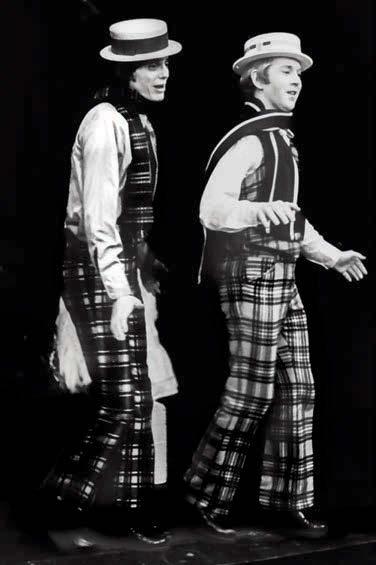
by 11 students who have all passed with flying colors.” (By Colgate coincidence, the actual number of people involved was … 13.)
All this prompted calls for more variety in campus theater offerings, which eventually
happened. In 1977, Colby, armed with the undeniable success of The Fantasticks, convinced the University Theater to help with a show he directed, You’re A Good Man, Charlie Brown. And this is how musical theater came to Colgate.
— Malachy Duffy ’74 spent his career as a journalist working at and writing for magazines such as Travel & Leisure, Food & Wine, Bon Appetit, Town & Country, Bloomberg Personal Finance, and many more. He’s been a regular theatergoer since he was 12 years old. Last year, Duffy opened a box containing his Colgate memorabilia, including a folder on The Fantasticks.

4.
Bike across America p.10

Produce a secret play p.58
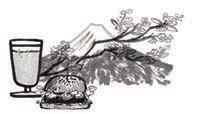
Introduce American beer to Japan p.57
Document the rise and fall of Hitler p.85
Start a K-pop boy band p.26
Photograph Mick Jagger p.42
Bust human traffickers p.105
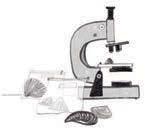
Study 12,000-yearold shells p.24
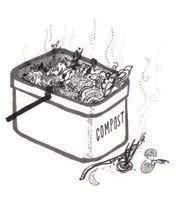
Help your county go carbon neutral p.86
Squat 742 pounds p.110
Restore a printing press from the early 1900s p.15

Run 100 miles p.16


Review albums for Rolling Stone p.30